


is published four times a year by Inman Ink Ltd


Gary Inman
editor: Mick Phillips
editor: Kar Lee
officer: Dave Skooter Farm
rider: Travis Newbold

Sideburn magazine
2040-8927

of this magazine can be reproduced without publisher’s consent
People kindly tell us that Sideburn is going from strength-to-strength. It’s thanks to people like these: Kye and Rick Forte; Lucia; Paul & Susie Bryant; Tom and Sally; David and Todd at Moto-X Lab, Fox Head Inc; Thor and all at See See Motorcycles; Justin at See See KTM; Jimmy Hill; Matt at Northcore; the SnowQuake racers and crew; all at Deus Milan; the Di Traverso crew; Paul France; Ozzer; Hayden Roberts; Scott Toepfer; Jeffrey Carver; Adi at 99 Seconds; Andy DiBrino; Ryan Quickfall; Kit Engwall; Mitzo the turtle; Ollie Brindley; Dave at Flattrackfotos; Michael, Gene and Andrea at American Flat Track; the One Moto Show photographers; Marco at OMT Garage; John H; Raid71; Dave Bevan; John at Brapp Snapps; Kevin at Motorcycle Social; Skip Aksland; Dan Mahony; Les Brewin; all at the DTRA; last, but never, ever least, all our loyal advertisers. They support the independents.
SIDEBURN
May 2018.
will be published
subscribe go to
3 Sideburn
Editor:
Deputy
Art
Entertainments
Poet/Test
©2018
ISSN
None
sideburnmag@gmail.com www.sideburnmagazine.com
Cover
photo: Lucia Aucott & Dave Skooter Farm with Kye Forte’s Yamaha XS750, by Paul Bryant This page: Jimmy Hill by Kit Engwall
33
in
To
sideburn.bigcartel.com @sideburnmag sideburnmagazine.com sideburnmag

6 Father’s Pride and the Speed Block Doctrine Kye Forte’s Yamaha XS750
Framer cover bike. Amen
14 Lucia Aucott
not just our cover bikes
race, our cover models
26 Original Future
See x Fox
36 Close Is Not Close Enough
See’s
44 Alien
SnowQuakewinning, genre-defying
61 You Went Through Red Rock On Those?
and Meriden twins beaten half to death in the Nevada desert
sideburn #32
71 Sami Graystone Portfolio
art from a Yorkshire
79 Nine Years One Show
Portland’s One Moto Show changed how the world thought of motorcycle shows. This
a very potted history
See
Moto-X Lab x a turtle
It’s
that
do too
See
Harley 1200 street tracker shows the factories how it should/could be done
Ollie Brindley is an outsider, a young Brit in the white heat of American Flat Track’s Singles championship
here’s
BSAs
52 Stardust
Yamaha XSR900
Dreamy
lass 98 The Pink ’n’ Purple Peak Eater Travis Newbold finds a new Colorado hillclimb to boss 86 Akira Dave Bevan discovers the 30-yearold manga blockbuster 92 Brand Extension Inside Fox Head Inc’s incredible Irvine nerve centre 5 Regulars 18 Interview: Jeffrey Carver 24 Get Schooled with Andy DiBrino 106 Shop: Deus Ex Machina, Milano 108 Racewear: James Smith 110 Project Bike: Honda 650 sand racer 112 Sideburn merchandise 113 Poem 114 Trophy QueenIllustration: Brent Wick

Father’s Pride and the Speed Block Doctrine

7
Our Father, who art in Devon, give us this day our daily thoroughbred Words: Dave Skooter Farm Photos: Paul Bryant (studio), Paul France (action) >
(from top to bottom) Sideburn sticker covers a scratch. The bike has been used (and had things fall on it); piggyback shocks are from a Yamaha XJR1200; (main pic) Note the hydraulic clutch conversion

N THE BEGINNING of the 2017 DTRA race series, the Thunderbike class was conspicuously graced by the addition of a vitally stunning and pristine race bike. Although the Harley-Davidson XR750 is exalted as the quintessential flat track bike, I think it’s fair to say that this particular bike, a Yamaha XS750 (in classic yellow and black ‘speed block’ livery) clocks in at a very close second. Devonians Rick and Kye Forte are responsible for putting this righteous bike on the track. Faithfully engineered by Rick and deftly piloted by his son, Pro BMX racer/dirt-jumper Kye, they remain unrepentant about rattling the UK flat track congregation with their coveted steed.
After a 15-year career in BMX, some dabbling with motocross and downhill MTB, followed by a vocational change to become an accredited tree surgeon, Kye was yearning for some redemption for his two-wheel addiction. He bore witness to the parallels between BMX and flat track. The short, sharp racing was appealing to him. He was led into temptation.
His flat track baptism came in the latter part of the DTRA 2016 season. Kye initially planned to stick with racing a 450 DTX bike, a far easier proposition. However, he was encouraged by his father to build and race a Thunderbike-eligible framer, a pure thoroughbred, ordained with an impeccable pedigree.
Rick recalls the pivotal and divinely inspirational moment in 1977 when, along with Kye’s mother, he attended the now legendary Strongbow grasstrack race, held at Haldon racecourse, a horse racing venue in Exeter, less than seven miles from their home.
Influenced by the Trans-Atlantic Match Race roadracing series, this special one-off event pitted six British riders on Triumphs against the ‘Rest of the World’. This all-star roster included Kenny Roberts, who gave a jaw-dropping and wide-open performance aboard his outstanding Yamaha XS750. Rick vividly remembers cornering Roberts in the paddock and asking him a barrage of questions about the bike that Kenny didn’t know any of the answers to. Rick is the first to agree that you couldn’t argue that KR knew how to ride it though. Roberts’ actions on the bike spoke to him way more than any number of meticulously answered questions could. Rick had an epiphany. That day has remained in the forefront of his mind, the lasting image of that bike with its


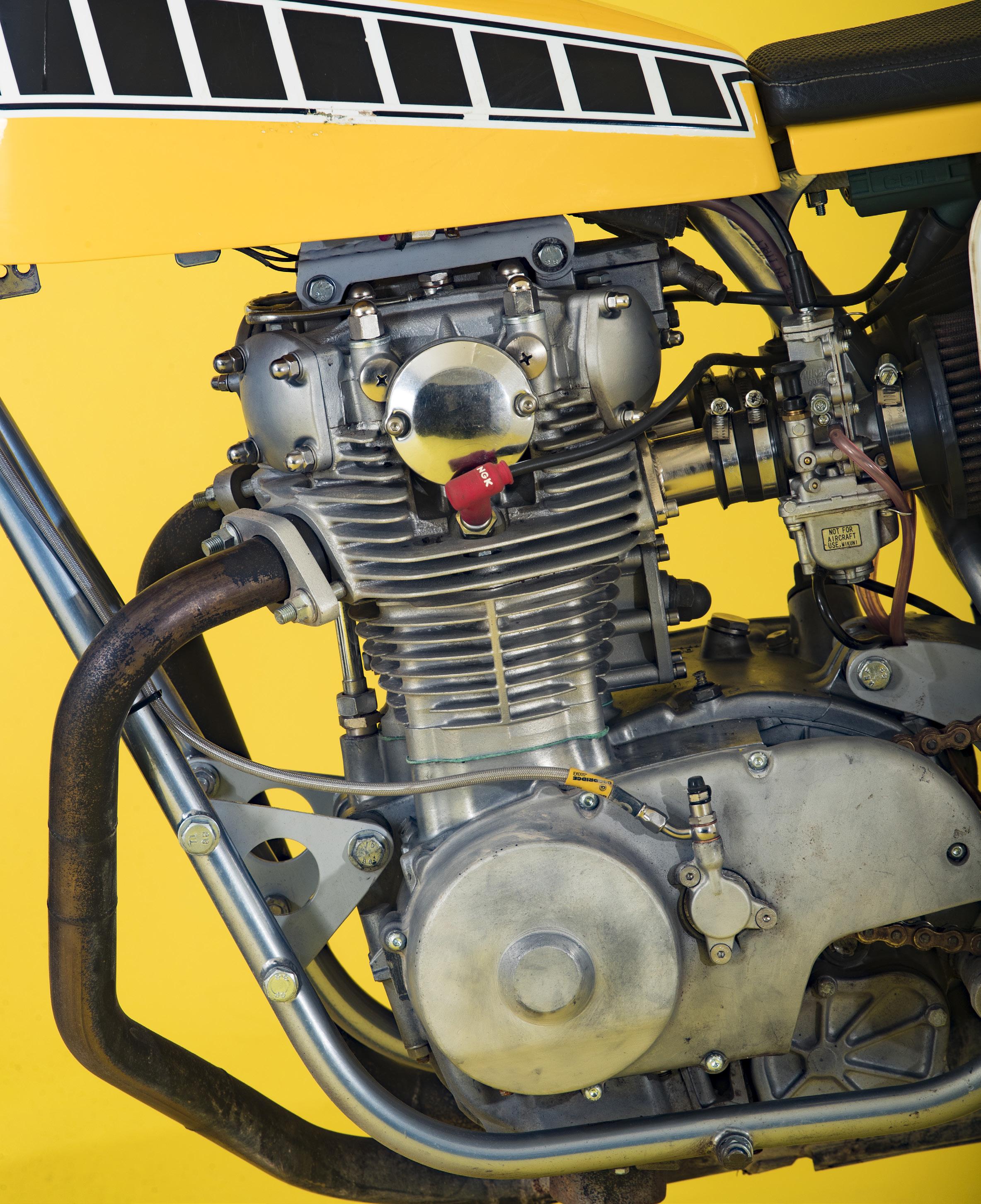
>
stripped-down and purposeful stance seared into his memory. Perhaps more extraordinary is that his wife clearly remembers that day too. Fast forward 40 years and Rick proudly informs me that she fully understood and supported why they had to build their own version of Kenny’s bike.
The weapon of choice was agreed between the father and the son and a donor bike was somewhat hastily picked up on eBay. The frame was duly deemed an unworkable and weighty unholy ghost and lo, the engine was found to be an unrighteous pig-dog.
Thus, a secondary plan was put into effect. An engine build was commissioned from Howard Smedley, at XS650 specialists SmedSpeed. Rick then pledged to hand build his own replica Roberts frame.
Rick’s own introduction to motorcycles was watching Monday night speedway at Exeter as a youngster in the mid-’60s. Smitten by the noise, smell and excitement of the racetrack, he, along with his circle of friends, became a disciple of the local speedway team, emulating his heroes on discarded bicycles salvaged from the tip. His early interest in engineering was born out of necessity, as bicycle frame geometries were modified to improve handling for cycle speedway or dirt jumping. He would spend countless hours in the freezing cold, hanging around the local garage waiting for one of the welders to take pity on him at the end of the day and braze-up his latest project.
Throughout his adult years, Rick was involved with motorcycle trials riding, finding it impossible not to tinker with/improve/devalue every single bike he ever owned. However, aside from some bicycle frames, the XS frame was to be the first one he completely scratch built. The winter of 2016-17, he practically lived in the shed, working tirelessly, referencing a heavily pixilated and low-resolution photo ripped from the internet. The project commenced in earnest on 3 January 2017 and lasted until the bike was fired up for the first time just two days before a shakedown session at a pre-season DTRA practice in mid-April.
Considering how much ‘guesstimation’ came to pass, the bike handled incredibly well right out of the blocks. The footpegs were a little low and the unsilenced exhaust pipes scraped in the corners, but not a great deal else was wrong.
The Forte XS was never designed to be an authentic replica, it had to be a practical race bike first and foremost, so Rick was happy to fit more modern Yamaha forks, wheels, brakes and levers. Pipes took a battering landing the Greenfield TT’s jump. Did you spot the right-side gearshift conversion?

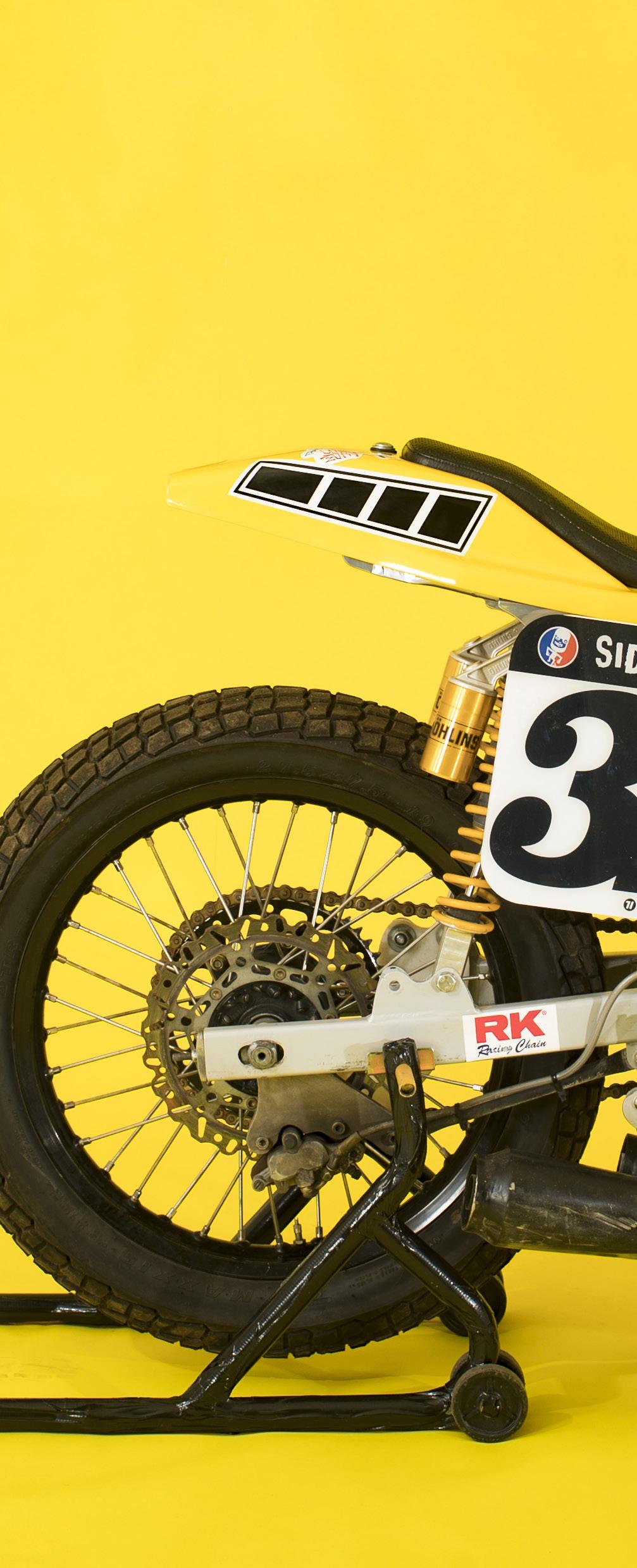

>
The bike boasts an impressive list of modifications, including a re-faced crank, racing camshaft, hydraulic clutch conversion and a very tidy righthand gear change fabrication. Further developments for the 2018 season include a switch to total-loss ignition, a gas-flowed cylinder head and sump extension to prevent the crank dipping into the engine oil each revolution. Eliminating this viscosity drag will hopefully add five horsepower. The swingarm will be shortened, fresh two-into-one exhaust pipes fitted, along with new, adjustable offset yokes, allowing Kye to tweak the steering geometry.
Starved of local flat track facilities, and to complement the bike build, Kye and Rick have also implemented their track-building skills to create their own place of worship, a private practice/test track. It proved a little narrow for the meaty XS but they have plans to widen the corners.
The Fortes are very happy to be racing in the DTRA. As newcomers, they’ve been welcomed with open arms, something that didn’t happen in the motocross scene. At times, Kye’s previous experience
of competition has been at the nerve racking, highest level, with the weight of sponsors’ expectations firmly on his shoulders. With the DTRA he feels considerably less pressure. That’s not to say he’s not up for doing well. He certainly isn’t just making up the numbers and his old man will be livid if he doesn’t get results!
It’s been a path to enlightenment for Rick to be able to build this bike for his son to race. As a by-product, they get to spend some quality time together, which they both seem to really value.
With their debut race season under their belts, they currently have six Yamaha XS engines in their possession, plus frames, some with registrations. And now Rick has his own frame jig, there are serious plans to build two or three similar bikes. It’s not beyond the realms of possibility we might see a roadlegal street tracker or even a hooligan race bike.
‘We’re ever so pleased with it!’ quips Rick. He tells me he was always on a crusade to build a bike that stood out from all the rest, a real messiah, and he wants his son to have a bike that has all the power and the glory, forever and ever. Amen!
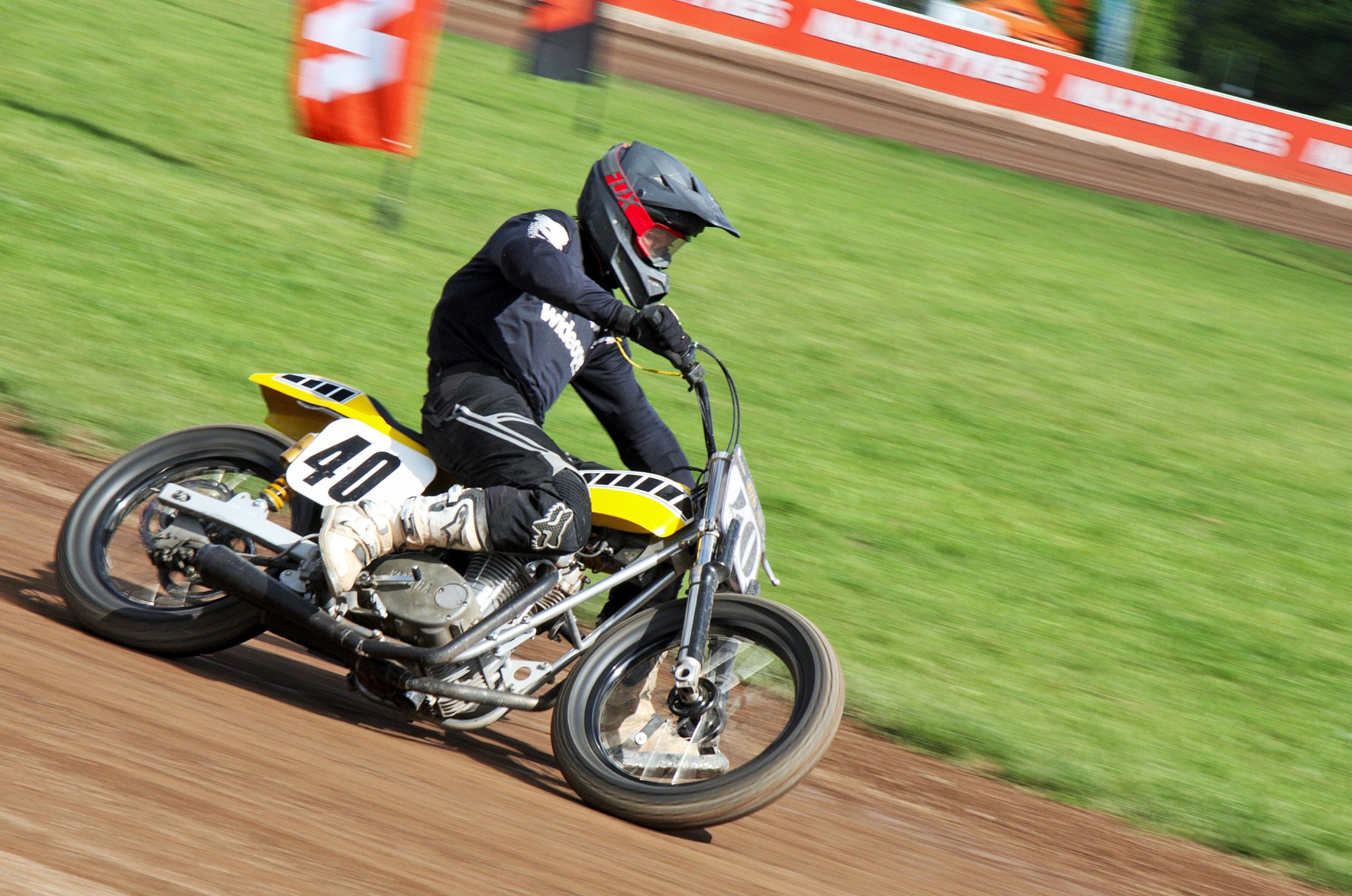

Roll Model
Our cover model wasn’t chosen off an agency’s website, Lucia Aucott races with us in the Dirt Track Riders Association
‘M
y first flat track experience was at Peter Boast’s Champions Flat Track School. My husband Tim and I went there with a bunch of friends and we had an amazing day of riding and laughing. The following weekend I did the DTRA x VC London Ladies Dirt Camp at Greenfield and that was it, I was hooked. I knew it was something I wanted to do. So that same weekend I bought my first flat track bike, a Honda CRF125, and it just snowballed from there.’
Since then, Tim and Lucia (Lut-zee-ah, she was born and brought up in Slovakia) have been filling their garage with flat track bikes: 125s, Honda 450s, a Rotax framer (bought from me), a hooligan Harley...
‘Tim started racing one year before me. He had followed the flat track scene for a while, but was still skydiving so didn’t have enough time to do both. When he started I went to all the flat track meetings and practices with him and we both were overwhelmed by how great the flat track community is. I was dying to start racing, too.’
Lucia also has her full motorcycle road licence, but doesn’t enjoy riding on the road, she’s all about the track and is part of the small but growing group of female racers in the DTRA.
‘Personally, I think its easier for women to get into flat track compared to other bike sports. Get a minibike1 and you are pretty much ready to race in the Minibike class. That’s how I started. I have tried motocross and green lane riding and they’re both a lot more physically demanding. Also, everybody is really helpful around flat track and the atmosphere is much more relaxed.’

Lucia and Tim practise all the opportunities they get, at local tracks and Boastie’s indoor mini oval. They also spent a week at Colin Edwards’ Texas Tornado Boot Camp and are booked in for some time at Johnny Lewis’s JL10 Training headquarters in Florida, to coincide with the Daytona TT.
‘I’m just really happy how my first season went. I was seventh in DTRA Rookies and fourth in Minibikes. I move up to Inter class for the 2018 season so I will be racing against Tim. I will be happy to beat him and hopefully make the finals. And beyond, maybe one day move up to Pro class.’
Words: Gary Inman Photo: Les Brewin
Lucia in her first season of racing.
a bit of this? Contact your local track or race promoter and get involved

Fancy
Appendix 1 Minibikes in UK flat track tend to be Honda CRF100s and 125s or similar, not the pull-start Taco-style machines that North Americans call minibikes. The DTRA Minibike class is for adults on 100s and 125s. 15
VARIAL






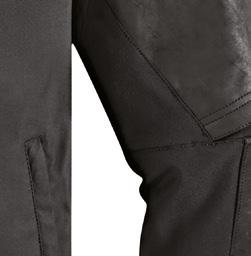
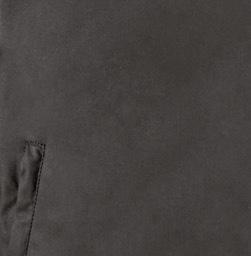

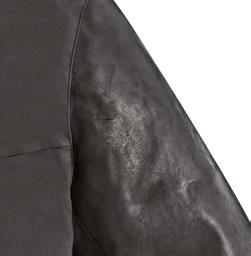
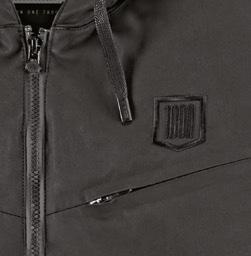



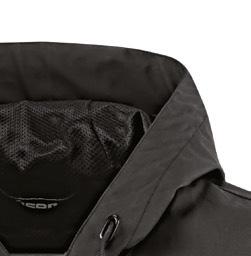



COLLECTION
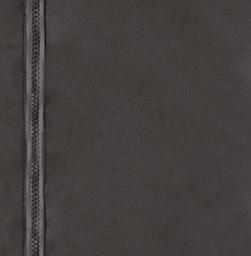
_ SP18 featuring:








shown: HELMET_ [AIRFLITE] PANT_ [VARIAL] JACKET_ [VARIAL] BOOT_ [TRUANT 2] GLOVE_ [AXIS] BAG_ [coming soon]
Who? What? When? Why? Where?
Jeffrey Carver
Interview: Gary Inman Illustration: Adi Gilbert/99Seconds
Hey Jeffrey, you’re one of the most popular racers in the American Flat Track series and scored your first Twins class win last season, but when was your first ever motorcycle race?
It was flat track at Belle-Clair Speedway, Illinois. I think I was four years old, so, 1993 or ’94. I think I rode a KTM 50. I got first or second and the trophy was bigger than me. After that I actually concentrated on motocross till I was about 12. I knocked myself out a couple of times and got scared about the big jumps. That’s the time you’ve got to go for it if you’re going to be fast. So we switched over to flat track and raced knobbie TTs1, then I got flat track tyres and progressed from there.
My birthday is 10 January, so my first bike was a Christmas and birthday present combined, a Suzuki JR50 with #23s on it. My dad raced in the woods and a whole lot of motocross and my grandpa also raced, woods races and TT scrambles. They both raced with the number 23, so it’s been in my family a long time. When I say woods racing, it’s what we call hare scrambles or enduros. I grew up in a club called Splinter Creek Dirt Riders and they had about 100 acres, so I rode in the woods a lot, but I didn’t race in the woods a lot.
I remember my last couple of motocross races, trying to borrow a front brake lever and couldn’t get
anyone to lend us one because we were racing against their kid. Flat track was a different scene, more congenial and I enjoyed what I did. I enjoyed hitting corners hard and fast. And our TT track was pretty quick, it was tapped out on a small bike and I was doing well at it. I just wanted to ride, I didn’t care what it was, but, like I said, I was scared of hitting the big motocross jumps at the time. By the time I started flat tracking I was riding a Kawasaki 85 that we purchased from George Mack. When I won my first national, the Castle Rock TT in 2013, I was actually on his motorcycle. When we bought the 85 we didn’t know who he was, we didn’t know he helped out some of the top pros, we just saw he had a bike for sale.
When did you turn pro?
In 2008 I got my pro licence, and I raced in the Hot Shoe class, which is what AMA Pro Racing called it before they brought in the 450 class.
What’s the most memorable win of your career so far?
It has to be Lone Star this year, with it being on a twin, I’ve been really working for that. I felt the guys who win on twins are gladiators, after I raced one for the first time I realised there’s a lot more to deal with. I’d raced the Harley but then I put it to one side to concentrate on the easier-to-ride, easier-to-work-on Kawasakis, so to win on the Harley and to beat Jared Mees in the year he’s had made it all memorable.
What is your favourite track and why?
Man, it’s really hard to say. We’ll break it down. The reason for all these tracks is the surface. My favourite cushion track is Lima, Ohio. There’s not a definite line, at Lima you can run from the bottom of the grass to the hay bales and be fast there. When it comes to stock car tracks, Rapid City, Black Hills last year was just amazing. It was a racy racetrack. I like all different tracks, as long as they’re racy you’ve got me hooked. I like that it becomes about mental strategy. Then there’s the Springfield Mile. Last year there wasn’t a defined groove, we could race way up the racetrack. I think it shows our talent and what we can offer to people and put on a show.
What’s the best motorcycle you’ve ever raced?
As of now, I’ve had a lot of success on the Kawasaki and the Harleys. Right now, if I was to choose a bike that was supposed to work everywhere it’d be a Kawasaki, but there are certain tracks where I’m going to be a second or two faster on the Harley. My Kawasaki has a Big A chassis, out of Pennsylvania.
And what’s the worst bike? A Suzuki TL1000 was the first twin I ever raced and it was a handful. It was heavy, pushed the front, [and had power delivery] like a light switch. That, or I rode a Buell at Springfield for two laps and blew the spark plugs out of the thing.
incorporates a left-right kink and a
Appendix 1. A class for bikes with motocross tyres, not traditional flat track tyres. TT is a type of flat track circuit that
single jump. TTs make up part of American Flat Track’s national series.
>

I don’t know how it rode, because I destroyed it right away.
It seems like there’s a big exodus to the FTR750, tell us why you’ve joined the team that you have signed with.
The FTR is up to date. It’s a production motorcycle built to race flat track. The last one of those was the Harley XR 2. I think I can learn from the bike and take the good points of it to our other motorcycles and expand our knowledge and stay up with it. I think Yamaha and Harley are going to keep improving, and I don’t want to get left behind. I want to see what it has to offer. I want to understand all the brands.
Being a privateer, I can pick and choose our battles. After I’ve ridden the FTR a bit I’ll have a better understanding of where I think it will work, but we’re keeping our options open to run the Harley or the Kawasakis3 .
Would you have signed for Harley if they’d come calling?
That’s a hard question to answer. A lot of me would say no, because I want to do my thing, but it would depend on what they had brewing and what kind of benefits I’d get from it. I’m very happy where I am now.
What do you have to do or change to become the number 1?
I have to stay in focus. The older I get the more in depth I’m getting into the racing. It’s all day long, rounding up help, putting together a good image, keep training, buttoning up all my bikes. I’d rather be out riding, but to get this whole package right I’ve got to be on the phone, doing this stuff. Then me and my mechanic, Ben Evans, have been pulling late shifts to make sure everything is ready for when the season starts.
Appendix
All those things will really help me chase the championship.
What’s the best thing about being a professional motorcycle racer?
It’s my job, that’s the best thing about it. I’ve been in positions where I’ve thought the other way, but having it as a job, even thought it’s not really a job, means I’m living my life as I always dreamt it would be. In some sports they don’t want any hair sticking off your face, but what’s great about dirt track is it’s open and old school.
And the worst thing? I don’t like complaining.
Who is the toughest competitor you’ve raced during your career? Jared Mees. He sleeps and breathes it. If you can line up next to him and be in his head, that’s good.
Who is the greatest flat track racer of all time? Ricky Graham, RG3.
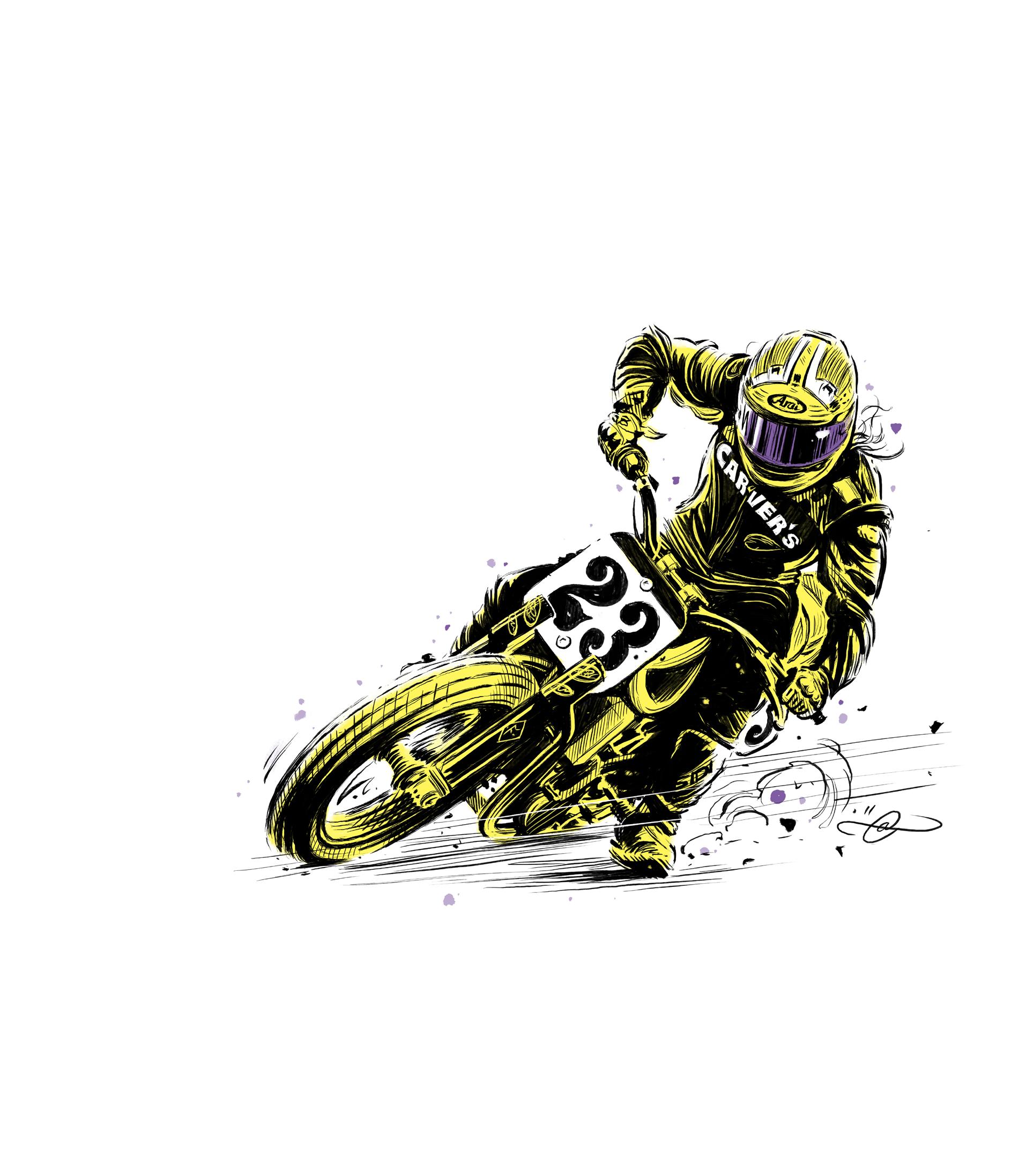
You seem one of the most laidback people in racing, do you think that makes people underestimate you?
I think so, but I think that’s out the window. It’s from when I couldn’t find my footing, people got that off of me, but now it’s more like the sleeper kind of deal. That’s why I like the nickname the Wizard, you don’t know what I’m going to throw at you.
I had been riding other people’s bikes, but I wasn’t finding a place for myself and finding a connection with the twins, because I’d only really ridden DTX bikes until I rode a twin,
so it was a different step. This year has been the one I’ve put in the most work and effort, working on bikes till 3 or 4am, then driving all day, getting a little bit of sleep then racing a national. I feel the type of package I’m putting together is better than some of the factory deals. I’m going to try to keep building it. I look at Jared Mees, who has factory backing but is still running his own deal. You can have a $20,000 race bike that can win a national, you just need a lot of talent. There’s been a lot of adversity, but I wouldn’t change any of it.
What’s next for you?
Getting on top of the box. Top fives and podiums are a goal, but I want to start stacking up the numbers. I’m here to win nationals.
2. The Harley XR750 was a factory production racer when it was released in the late ’60s, for sale to any customer. Years later Harley continued building engines,
can’t swap the make of bike halfway
but no longer offered complete bikes. Over 45 years after the introduction of the alloy XR750
engine, Carver won the
2017 Lone Star Half-Mile on a private XR750. 3. American Flat Track is unique among pro motorcycle sports because some privateers swap between different makes of bike depending on which they prefer for each track. Historically, XR750s have been very strong on half-miles. Rules state the rider
through a race meeting.




Win a hooligan title
HE’S COMPETED IN supermoto and road racing since 2007, but Andy DiBrino is a fairly recent flat track convert. ‘I live in Oregon, it’s kinda rainy in the winter with not a lot of outdoor riding, so about four years back I started indoor flat track racing at Salem and became friends with Thor Drake from See See Motorcycles. In 2015, Thor asked me to race at Dirt Quake USA on Icon’s H-D Sportster 1200. That was the beginning of my hooligan racing, but it wasn’t until I won $10,000 at The One Show’s hooligan race on Thor’s XG750 [see SB24] that I developed a love for it. Without Thor’s encouragement, I wouldn’t be hooligan racing. Coming from a motocross background, I had zero interest in Harleys and he changed my perspective on all of that.
‘People told me I could win the 2017 Superhooligan series, but I’d already committed to doing MotoAmerica, the US professional road racing series. It was early enough to change my plans and my dad let me [do the Superhooligan series] on the condition I talk to my sponsors and work something out. That was only four days before the second round, 2000 miles away in Wisconsin. I flew and was able to borrow a bike. I knew I’d make eight of the ten rounds, I missed round seven at Santa Maria due to road racing commitments. It was so tough to make that decision because I had a 15-point lead in the hooligan series and was lying second in the road racing championship. If something went wrong I could lose both.’ DiBrino won both the 2017 National Superhooligan series and the OMRRA road racing title.
Weight management
The bikes are heavy but due to my road racing experience the weight is not an issue. The only thing I keep in mind is when I throw the bike in I could hurt somebody. I’m careful when I’m overtaking but you can ride those bikes as hard as you want and they do surprisingly OK. Sammy Halbert and I were banging off each other at the first round of the Superhooligan series. If we go back to Dirt Quake 2015, when I first rode a Sportster 1200, I was worried about the lean angle in the corners and wasn’t sure how planted it would be; honestly, it scared me. As I got more seat time on these bikes, I learned you can do a lot with them.
Smoothness
Because of the weight, when you get out of shape you can’t manipulate it in the same way as a 450, so it’s important to be smooth. I had a moment at Dixie Speedway in Georgia. I was on a 750 against the 1200s so I had it wrung out in the corners. I came out of turn two wide open, lost the rear and went into an 80mph tankslapper. My feet came off the pegs and I don’t know how my arms didn’t get ripped off. The racing has got really good at the front and on the bigger tracks Joe Kopp and myself, on bikes that weigh 130lbs more and have less horsepower, were less than one second slower on lap times than some of the AFT twins riders.
Set up
The See See XG750 I raced in 2017 was still street legal at the first round, with speedo, lights, licence plate, kickstand... After that it changed every race. I realised what the level of competition was when Halbert and Kopp came out. Before, I was winning races on a bike that I would never touch. That’s what originally I loved so much about it. Then, I got new suspension; I stripped off all the street stuff; the handlebars had integrated switches in them, we took those off and used different bars every single race. The bike needed those changes to make it more comfortable for me and to turn it into a race weapon. Finally, we added an 800cc big-bore kit because I was lacking horsepower on the big tracks. The biggest set-up tip is wheelbase. If you look at Joe Kopp’s Triumph it’s short, good for traction on the short tracks.
Rise Above
Towards the close of the 2017 series, things got a little ugly between a couple of racers. I’m one of the friendliest guys there and I’m a pretty clean racer. On a tiny track, where everyone is ultra-competitive and riding 400lb bikes, it’s hard to not hit people. I get hit every main event, that’s just how it goes. When hooligan racing started, people were not professionals and their approach was having fun. Now you have these events partnering up with AFT, professionals are coming in and not just from flat track. From a fan’s perspective, it couldn’t be better. I think AFT could use a third class.
Support
I have a professional racing history and adapting to the way hooligan events were run was difficult. I was used to having a schedule and a procedure. At a lot of these races would be chaos. For road racing I have a support crew, but I started the hooligan series by myself, van trips of 4000 – 6000 miles, just me or maybe a buddy. For the Dirt Quake USA Superhooligan round I realised I was going to need some help if I wanted to win. My dad came with me... and I won. At races by myself I don’t ride differently, but I’m calmer when my dad is there. For the first four rounds of 2017 I hadn’t made any changes to the bike at the races. When he was there, we changed gearing and tuned the suspension. We made so many modifications because we continued learning things.
Adaptability
Whether it’s learning the wide variety of tracks in eight practice laps or fewer, or racing situations that evolve around you in an instant, you need to adapt on the fly and that helped me succeed when I may not have been the fastest. Practice would’ve helped, but I never had the time. My only practice all season was three days before the final race at the MotoBeach Classic. As a riding tip, get the holeshot, because races are short and the tracks can be really tight and hard to pass. It’s happened that guys who aren’t the fastest got on the podium because the track was too treacherous to make a pass on.
Words: Dave Skooter Farm in conversation with Andy DiBrino Illustration: Ryan Quickfall
25
original future

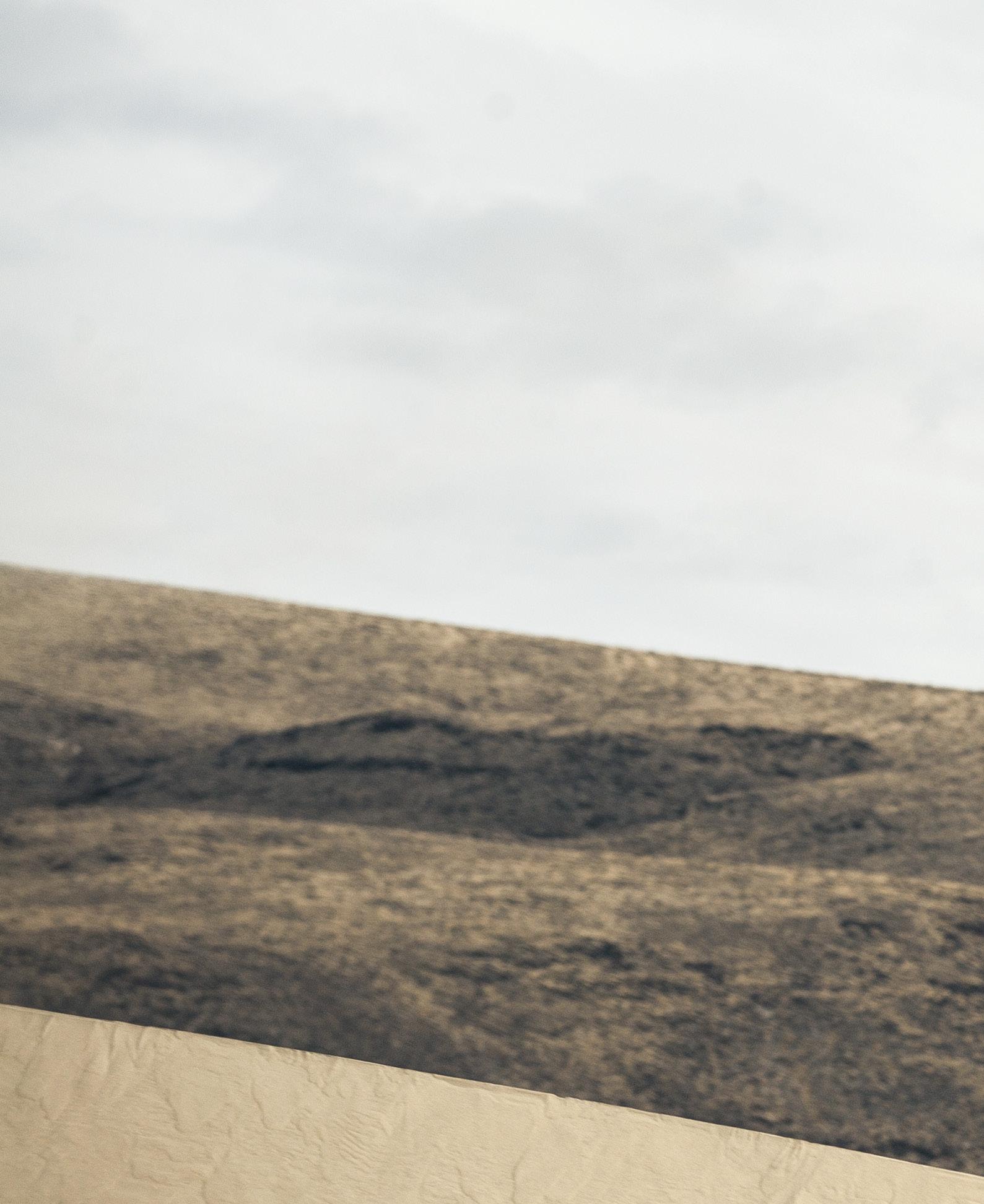
See
See’s Thor Drake moves from hitting a cactus with a stick to designing clothing with Fox
Words:
Thor Drake Photos: Kit Engwall
future


> 27
WHAT MADE MOTOCROSS?

The question itself is a tricky one, a sort of chicken and egg type situation if you ask me. On one hand you have these powerful, smoky, loud motorcycles that with the twist of a grip launch you into the great unknown. On the other, you have these loud, stinky, wild and colourful characters that pilot the motorcycles. From afar it would be a close match until you take into consideration names like these: Damon Bradshaw, Danny ‘Magoo’ Chandler, Johnny O’Mara, David Bailey, Bob Hannah, Brad Lackey. Hell, dare I say Steve McQueen? The gods of motocross, exceptional talents that stick in my mind not only for their skill, but also their personal style.
When I was six years old, in 1986, I was out playing in a field, throwing rocks, hitting a cactus with a stick, you know, just being a typical six-year-old boy in northern Arizona, when a guy riding an XR250, maybe 500, came blasting out of the tree line up on the hill just above me. He was wearing allred MX gear with a big ‘Honda’ in stitched-on letters down the leg of his pants. He wore a red Bell Moto 3 with white goggles and a blue fanny pack [bum bag]. I remember him like it was yesterday. He was the coolest looking thing I had ever seen (since my first encounter with He-Man, still the master of my universe). As he went by he gave a cool nod and left me holding my ears in a bluster of dust. His little nod must have been some sort of acknowledgement that he had changed the course of my future forever. From that point on, the image of this motorcyclist would be burned into my mind’s eye.
When I founded See See Motorcycles the logo came to me in a dream. It is a big smiling face with two crescent moon-shaped eyes looking off to the side. The logo is essentially See-Seeing something
in front or behind it, implying the notion that you must respect the past to take on the future. You have to SEE history to SEE how to go forward. The smile part is pretty cut and dried. Motorcycles are, and always will be, fun.
We are not the biggest company, but we understand our limitations and use them as motivation for design. We use what we have in our metaphorical, old, tiny toolbox to make something new and different. We draft on classic style and leave out the extra, complicated, unnecessary functions. When See See builds a new motorcycle we go back and learn everything we can about the origin of the manufacture, how the product evolved and why we are left with something we want to customise. We then reference our scrapbook of motorcycle history for small
inspirations and design cues. When the finished product is unveiled we’ll have taken something new and used a bunch of old inspiration to create something even newer. Likewise, when See See does an event, we take what we know to be true of the culture, we add some progressive thinking and come up with new ideas. The One Motorcycle Show was built around the idea that passionate motorcyclists become fixated on one style of motorcycle. We also knew that the shows we had been to were not much fun because they fixated on one style. We decided to start from scratch, add in the ingredients necessary and leave out the rest. It’s been nine years and not one show has been like the next.
When See See releases any product, we ask ourselves if it will stand the test of time. Whether
‘THE IDEA THAT WE USE WHAT WE HAVE IN OUR METAPHORICAL, OLD, TINY TOOLBOX TO MAKE SOMETHING NEW AND DIFFERENT’
>
The inspiration. Panel vans and polyester from when you could win a national title with a dad bod. (right) See See rider (and former King of Dirt Quake USA) Jimmy Hill flips on a dime during the new clothing test sessions in NorCal

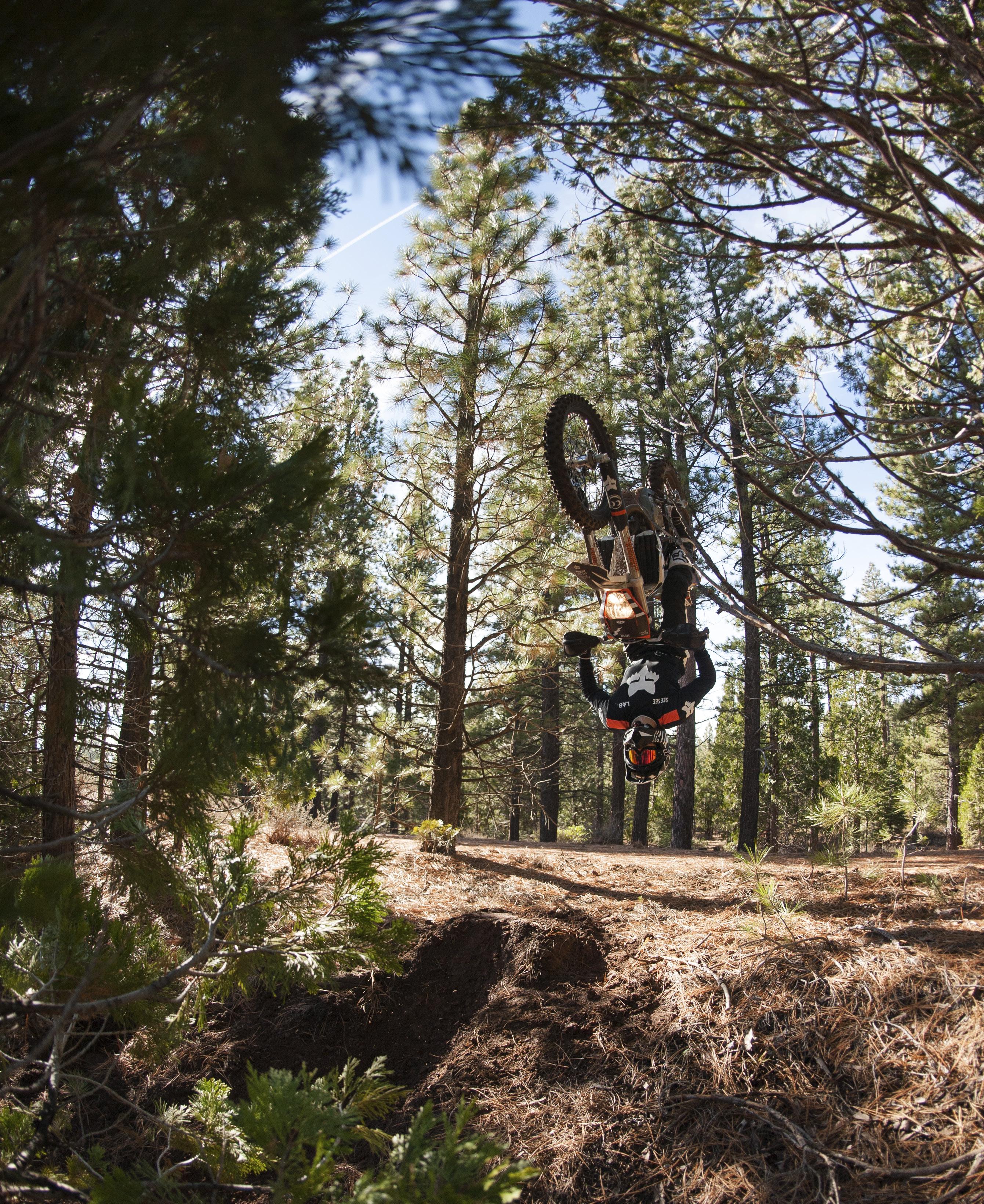
ten years down the road it will still look the same, if not better, with heavy use. Could one of those motocross gods wear a See See product and look just as good?
When See See does anything, we simply start from scratch and add bits of necessity, some truths, and try to make it as classic as possible. We won’t ever be known for our 2.0 technology.
When we first started talking with Fox about the potential of working together, my first notion was to think about what is missing. What had changed about the way MX gear looked and felt? A leather jacket came to mind. Not just any
leather jacket, a Langlitz leather jacket. When making a leather jacket, you can do it any way you want – make it pink, stitch a bunch of smaller leather pieces together, add a hood to it – but the bottom line is it looks better if it is simply just a leather jacket. Pretty much the mind’s eye of a leather jacket is the best version, just like the leather jacket Portland’s Langlitz have been making since 1947.
I closed my eyes and guess who showed up? Yup, you guessed it, Mr Arizona Honda XR250. From about 1972 to 1992 MX gear changed only very slightly, colours aside. It was designed around a
The See See x Fox Moto-X Lab range includes shirts, leather-reinforced pants, caps, coach jackets, T-shirts, Greek fishermen, turtles, wait... What?





few small factors. It needed to be tough, it needed to be comfortable, it needed to protect the rider and look good. I started to think about all the guys that had stood out to me over the years. They all wore my idea of classic MX gear. At the same time, I had shredded every set of new gear I had but one: my old KoHo pants and Viking polyester jersey.

With a little bit of hesitancy I brought those pants and jersey with me to my first meeting at Fox. I had them stashed in my bag as a plan B in case my rambling led to confusion. It was a matter of ten minutes before I decided to pull out
the pants and jersey. The reaction wasn’t what I expected. Fox’s head guys, who have been around the industry for well over 20 years, both said, ‘Those are rad.’

We agreed that the look was right. Additionally, we wanted to add something new, our personal touches. Every detail had to be right – leather sides and rear section, metal belt clasp, ripstop nylon, locking zipper, and yes, a smartphone pocket (one 2.0 feature is OK). As full circle as it gets, we teamed up with Langlitz for the leather. The jersey would be super-breathable future material but with classic design, including
a collar and cuffs to keep dirt out, also made from future materials. It was our goal to make something that smashed together both the ideals of See See Motorcycles and Fox Racing, the design elements from the past and cutting-edge product elements of the present. Taking something ORIGINAL to the FUTURE. The limited-edition collaboration is some of the best quality and most comfortable gear I’ve worn and we hope it will last decades and still look great, if not better, with age. We know the gods of motocross would approve, and if Ken Roczen wears the gear at some point we’ll be even happier.

‘IT WAS OUR GOAL TO SMASH TOGETHER THE IDEALS OF SEE SEE MOTORCYCLES AND FOX RACING’
>
COLLAB-A-DAB-A-DOO
Bike companies have concept models, fashion has collabs
The collaboration is a marketing tool that shows no sign of running out of steam. Companies A and B join forces and give a little of their life force to each other. The small company can be more radical, the bigger company has the reach and distribution; the young designer is too edgy to employ (and doesn’t want the job anyway), but creates a buzz for the mainstream brand and enhances both reputations. Some collabs are baffling, others truly inspired and leave punters gagging for more. Moto-X Lab is Fox’s in-house experimentation unit that can wade in unchartered waters to see what floats, without compromising the core company. If it doesn’t work, it was an experiment. If it does, it’s a new direction. Win-win. GI


To finish first, first you must finish.
The race: NORRA’s legendary Mexican 1000 in Baja.
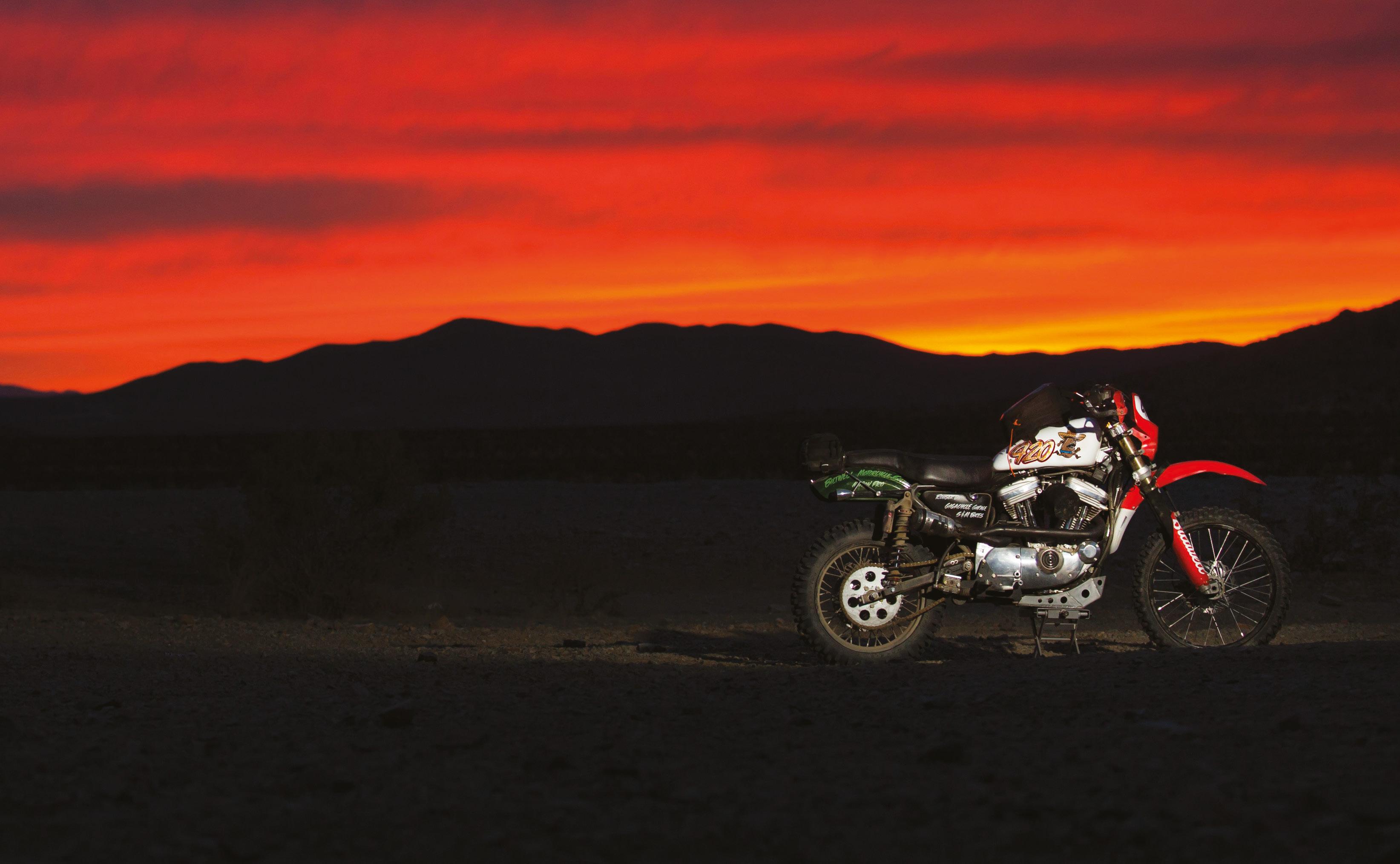
The machine: one humble Harley XL883, heavily fortified in the Biltwell shop.
The mission: to cross the finish line day five in one piece. How we and the Frijole 883 will fare is anyone’s guess.
Follow our misadventure at www.biltwellinc.com/wtf, or search #Frijole883 on Instagram.
WWW.BILTWELLINC.COM @BILTWELL


Close Enough Isn’t Enough
Words: Thor Drake Photos: Justin Vandenberg
Harley-Davidson don’t make a street tracker and See See Motorcycles aren’t happy about that…

> 37
IN THE USA there is a saying that goes, ‘Close enough for horseshoes and hand grenades’. As far as I can tell it’s a hillbilly term for telling someone, yes, they did get close, but also missed the mark. Harley-Davidson wasn’t throwing a hand grenade or playing horseshoes when they designed the Roadster – a 1200 Sportster with some performance parts – but they may as well have been. Yes, I’m a little late to the party of people begging, pleading, yelling at H-D to make something that reflects the number one thing they have been involved with for as long as America has raced motorcycles. I’m talking about a consumer-market tracker. And while I’m pleading, Milwaukee, can you make it around $12k and look just like this bike, or similar at the very least?
I love Harley-Davidson. Proof is in my garage where the following bikes live: a 1974 FLH (purple, bonestock Shovelhead); custom digger-style Ironhead; 1989 FXRT; Superhooligan championship-winning XG750 Street (aka ‘The Indian Giver’) and let’s not forget this here 2016 XL1200 Roadster. What I’m trying to say is, if I can build a street-legal tracker in my tiny little workshop with a few tools and a grinder, imagine what a massive motorcycle manufacturer could do with real resources, and actual skill. This is not to mention that they could actually pay someone to design it (if they can’t, I’ll do it for free, wink wink).

My target for the brand-new 2016 XL1200 Roadster was to build a tracker/hooligan racer out of a stock Sportster without cutting the frame: doing it the bolton way. Was it easy? Not really. Was it hard? Not really. The best part is, it will be even easier because I’ve laid out the map for you. So here it is H-D, and anyone else, eight steps from kinda hardest to easiest on how to build a fun street tracker/hooligan race bike.
Looking for trouble in a satin jacket. Thor takes his bolt-on tracker for a shakedown blast


Trackers are all about stance, fat rubber and minimal fuss. Could Harley sell this in their showrooms?
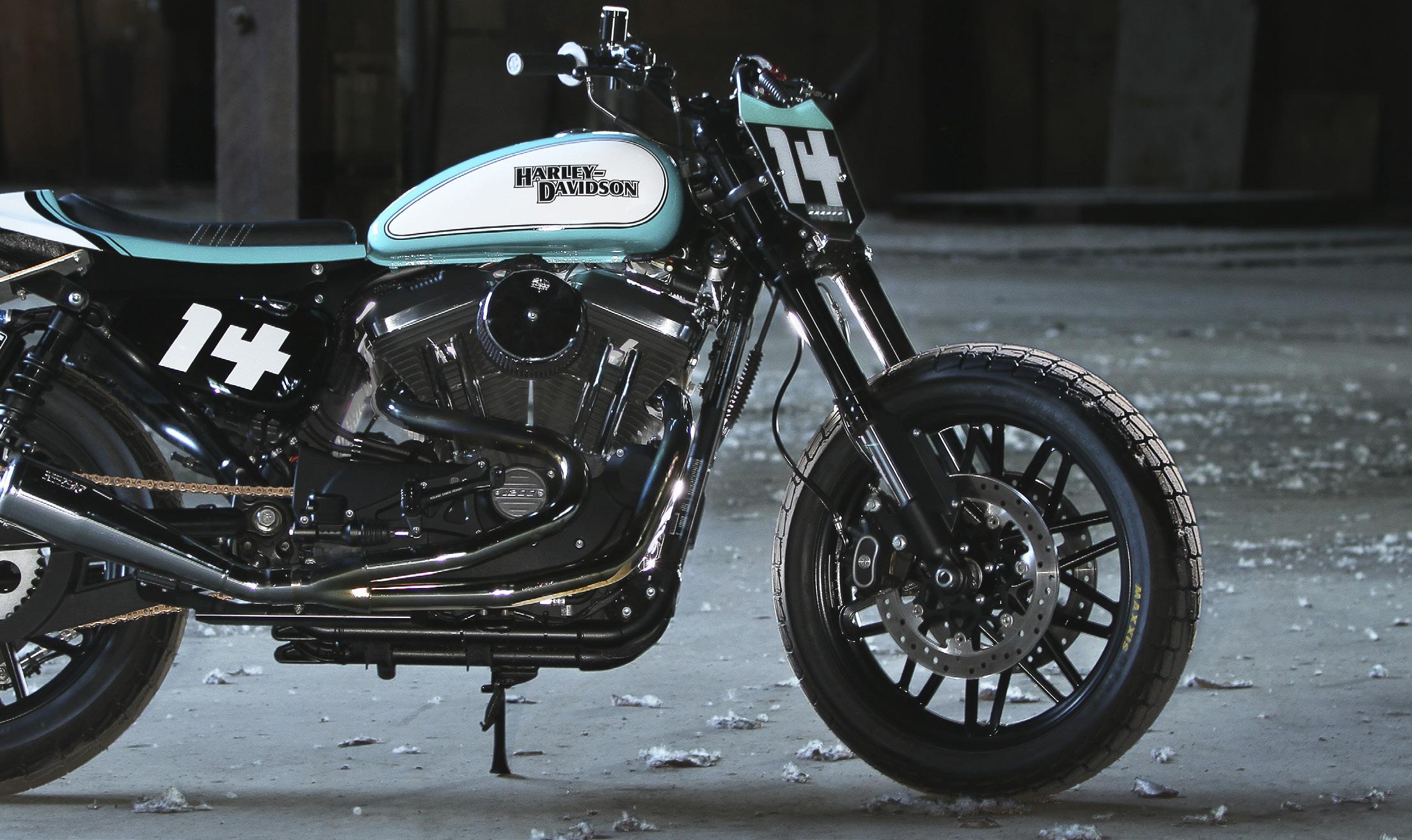
1. WHEELS

The stock front is a 19in, so that’s really easy. Just fit a proper track tyre – a few companies make DOTapproved race tyres now, so there’s no problem with legality. Stock rear wheel is an 18in, so bolt it to the workshop wall and use it as hosepipe tidy. Order another front wheel, the stock mags are super-light and strong. Pop in the correct-size bearings to fit the stock axle, then make (or commission) two aluminium spacers/hub bosses that bolt to the stock brake rotor bolt pattern. These will be used to mount your quickchange sprocket and rotor’s bolt-on adapters (available form GPS-flattrack.com among others). There are many options for sprockets and rotors once this has been done. I went with 520 chain spacing.
2. SPACING, SPROCKET, REAR BRAKE
We’re converting to chain, so line up your new 520 chain and measure your axle spacers, make sure to use a standard-size rear disc so you can buy the correct brake hanger and not have to make a custom one. This sounds complicated, but most flat track parts are built with specific sizes. Buy a suitable front sprocket, there are a couple of size options. Find a brake caliper, I went with the Brembo 38mm twin-piston that can be found on old Ducatis.

>>
4. GAS TANK
This is kinda my secret ingredient. Here’s a hint, it was made by H-D but most people removed them because they were ugly. You can order a weld-in EFI plate from Lowbrow Customs that allows you to use the stock fuel pump in a pre-EFI tank. Believe it or not, it was really easy.
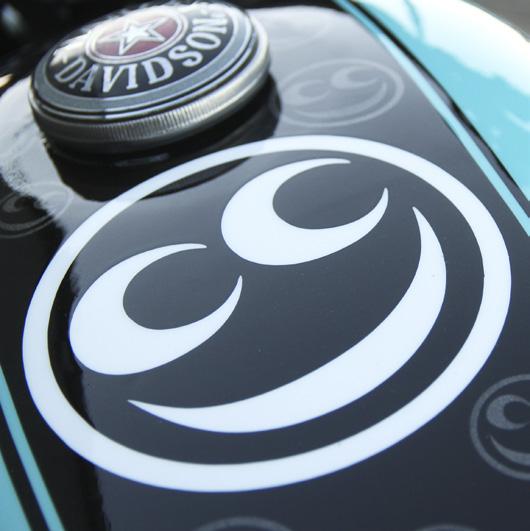
3. SEAT, FENDER STRUTS
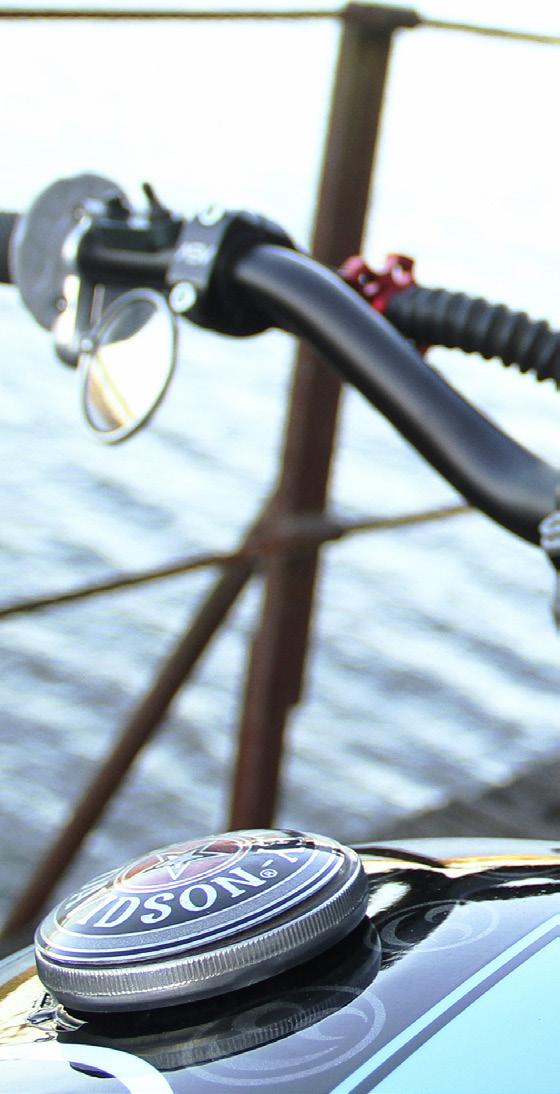
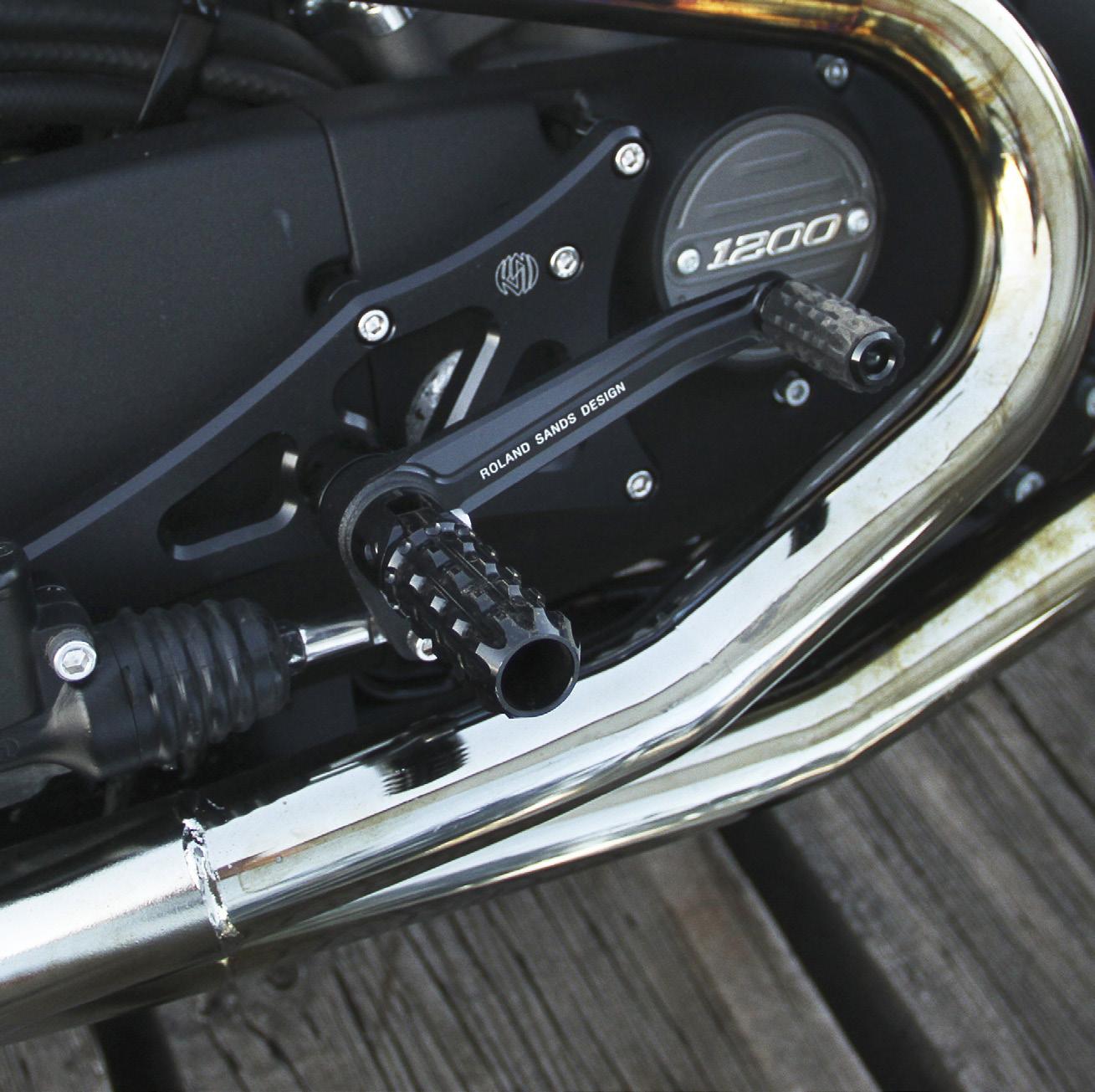
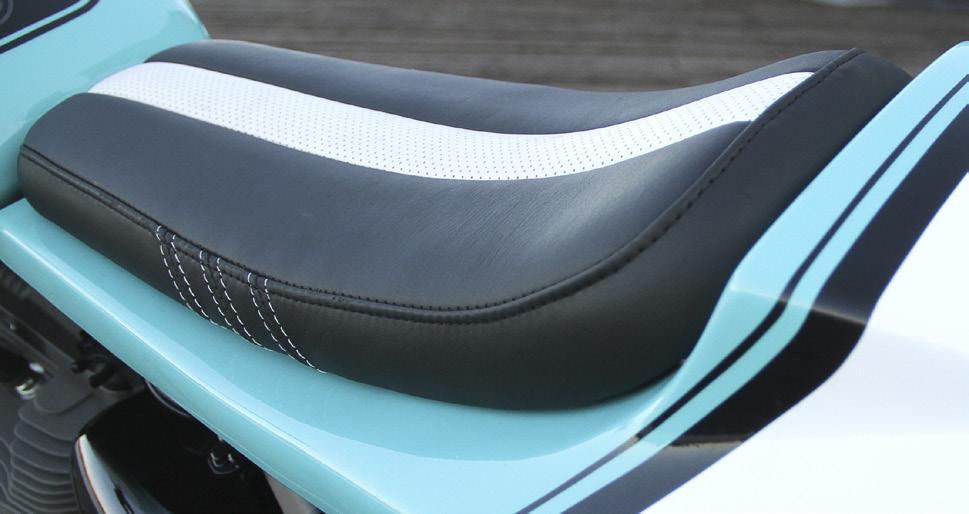
I didn’t want to spend any more than I had to, so I built a nifty little seat mount. It bolts right onto the stock mounting inserts. The mount was way more complicated than the seat. The mount looks like a gladiator helmet, or urinal, depending on how you look at it. I ordered a Gopher Glass Knight-style seat and cushion pan (don’t ever try to make your own fibreglass bodywork unless you love being itchy). The rear fender struts come off fairly easy with a grinder and save about 45lbs in weight. Ginger at New Church Moto whipped up a wonderful cushion and cover.
5. MIDCONTROLS
Roland Sands Design makes a perfect set. Be ready to spend $600 (plus shipping). The stock master cylinder works fine and if you finagle the stock brake line that works too. If I were to go back and do anything different, it would be to get a better master cylinder. The feel of the stock one is weird.
Appendix
1. CAN bus – Controller Area Network bus. According to BMW’s site… ‘this tried and tested vehicle electronics with Single Wire System (SWS) provides a great many advantages. It reduces cabling, and its CAN technology integrates all control units in one network, simplifying the comprehensive diagnostic process... it does away with conventional safety fuses as the system automatically switches off any components in case of malfunction. Other advantages of this intelligent electrical system include weight reduction in the cable harness, increased interference immunity and full diagnostic capability.’ Bus is an electrical term for method of transportation of information.The downside of CAN bus is it’s much harder for the home mechanic to tinker and customise with non-OEM-approved parts. 2. Plug-in, programmable fuel management module.
Repositioning the forward-mounted footpegs is crucial for street tracker ergonomics and style
Only American bike manufacturers persevere with one-inch handlebars. See See do not
6. HANDLEBARS
My opinion, and I’ll stand by it, one-inch bars suck. Take all the stock stuff off your handlebars. Buy a Biltwell throttle housing and tube for ⅞in bars, buy a better MX-style clutch lever; a Buell-style clutch cable; some heavy-duty MX bars and bar mounts. H-D’s modern CAN bus1 system is way over complicated, so call your local electrician to fool the stock switches somehow and bypass your starter button with some power straight to the relay. Here is an easy one for H-D to fix and an opportunity to sell you a dongle option.

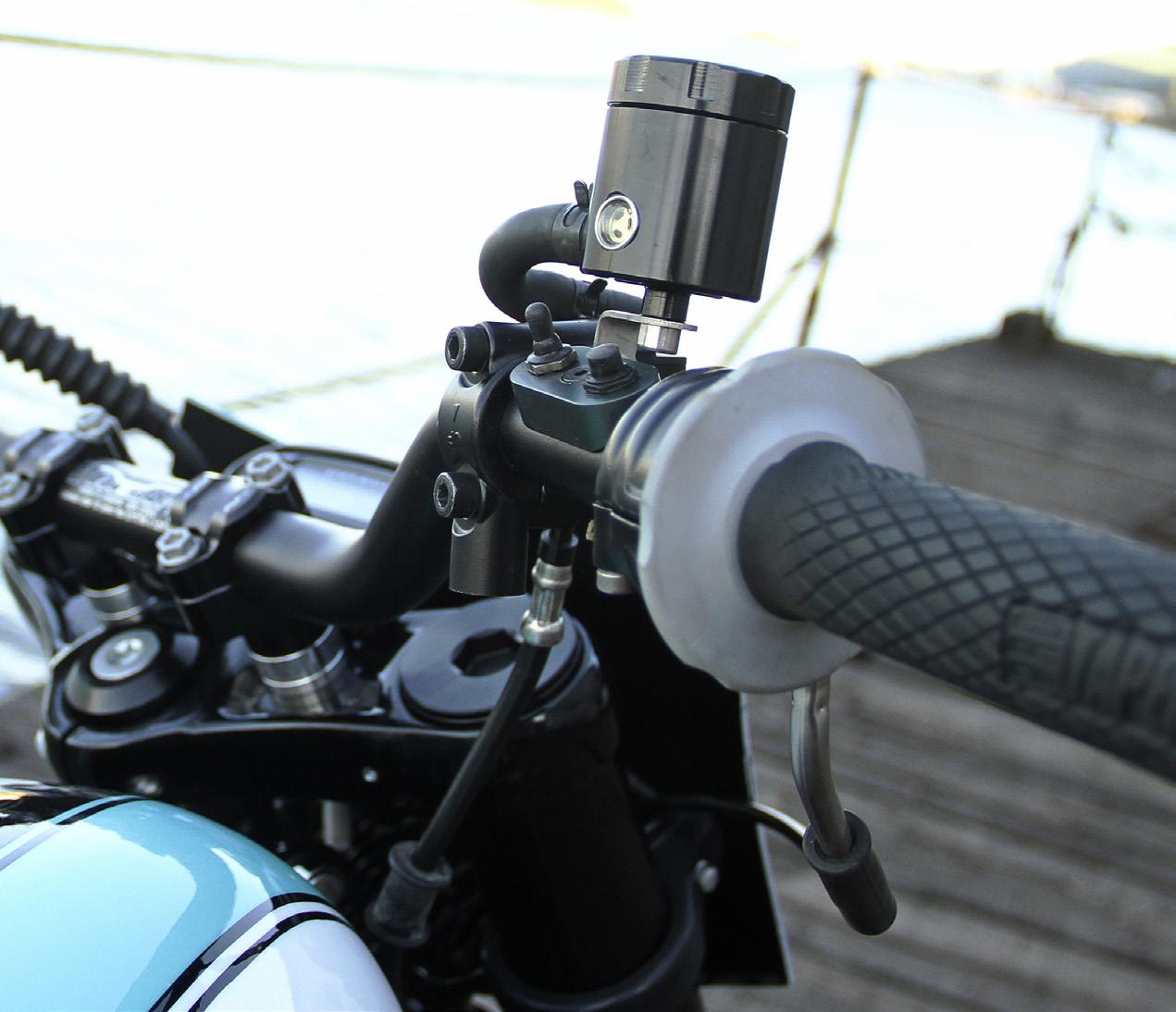

The stock controls screw everything up. This is going to be a headache but you’ll get through it. I used wire-in bar mini switches that See See actually make.
I needed a front brake so went with a stock Triumph master cylinder that I had lying around from another build.
7. DASH, LIGHTS, EXHAUST, AIR CLEANER

You’re on the home stretch. The speedo was replaced with a Trailtech Endurance II, that plugs into power, but that’s it. Lighting was an LED light bar behind the front number plate and a little, twin-brightness LED strip for the tail light, fixed to my seat mounting urinal. Exhaust is budget dependent – Vance & Hines got me all set up. The 2-1 makes a good, rich sound and adds a few horsepower. I also went with the V&H air filter, but there’s a catch, you’ll now have to add a V&H Fuelpak 2 or similar to tune the bike for more air flow.
8. THE FINISHING TOUCHES
Fox shocks are a good investment, not 100% necessary if you don’t have the budget, but your back will thank you. Fox make a few options, give them a call to see what you need. The stock USD front forks are OK, definitely could use a little tune, but overall they’re fine. I added some tube guards to the stock front fender mounts. My front number plate is mounted using a piece of PVC mounted with C-clamps around the forks. I made the mounts out of an old cutting board using a hole saw.
>
So there you have it, eight simple-ish steps. Did I hit the mark? Or was I close enough only for horseshoes and hand grenades?
I’ve raced the See See Roadster a few times and it’s heavy and hard to turn on small tracks, but it does fairly well on bigger tracks. The bike is almost street legal, and one of the most fun bikes to rip around country roads. To be 100% legal it needs turn signals, a front fender and maybe a rear fender that goes further down. All parts that, if the Motor Company

made their version, should be easily removable, if desired, by the owner.
These modifications actually removed a lot of overdesigned, over-complicated parts. 3 I think with some guidance H-D could make something close fairly easily, based on existing models, even with adding in the EPA 4 bullshit that 90% of motorcyclists remove or purposefully break, depending on how honest you are. Harley-Davidson, I am yelling, screaming, pleading... make something like this!
3. Harley build a bike that will survive 60,000 miles or more in the ham-fisted hands of a mechanical halfwit who changes their motor’s oil less often than their home’s central heating system. Other manufacturers sell dainty and delicate devices, often for more money than Harley, but H-D can’t get away with it. There’d be a backlash and damaging PR, but there is middle ground for sure. They also have to deal with clutter-inducing Euro 4 regulations. 4. Environmental Protection Agency, the US Government’s health and environment guardians.
Appendix
Models PROVEN PERFORMANCE






Air Cleaner Kit for HD
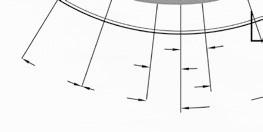





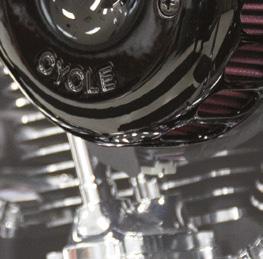
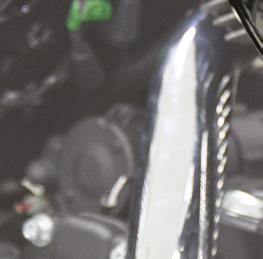








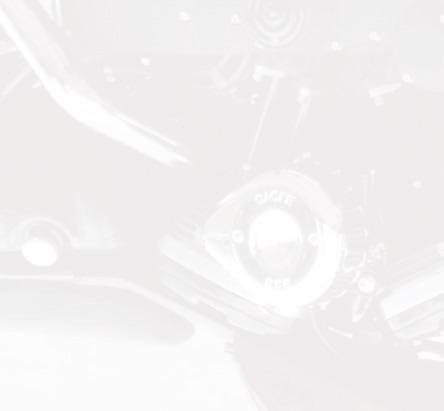




Created in 1975, the trademarked S&S Teardrop Air Cleaner has long been the iconic shape of v-twin performance. Adding to that legacy, the new Mini Teardrop is a compact version designed around our Stealth high flow air cleaner system and the perfect fit for your custom.














Flow
only to



















Made in the USA • sscycle.com Follow us online
• High
Air Cleaner • Available in Chrome or Gloss Black • Also available as cover
retrofit to existing Stealth Air Cleaners S&S Mini Teardrop
®
// FULL SIZE TEARDROP MINI TEARDROP

ALIEN Oliver Brindley is an 18-year-old Englishman who left home to follow his dream of becoming a pro flat track champion. Ollie tells the story of his first full year of AFT Singles
Photos: American Flat Track, Flattrakfotos, Ian Osborne, Ian Jubb

I’VE ALWAYS DREAMT of being a professional motorcycle racer. I decided I wanted to be a flat track racer at my first sight of an AMA pro national, the 2012 Springfield TT and Mile doubleheader. I was there for the Amateur Nationals and turned 13 the same week.
Jump forward four years and it was a strange feeling knowing that in 2017 I was going to take on my first full season of racing in the USA, but I was looking forward to the chance to ride every weekend. I started off with shorter trips to and from the States until we had everything sorted out. It helped me get used to being away from home.
Getting my work visa took some time. Without it I couldn’t race professionally in the USA. I had to make a couple of trips to the US Embassy in London, a 350-mile round trip, to prove I was worthy of holding a work visa. If they’d have turned me down, my racing career would have been over before it began. It wasn’t easy.
DAYTONA
We bought a Kawasaki 450 from Bryan Smith, the reigning champ going into 2017, and used my own Kawasaki 450 as a back-up bike. My dad, Derek, arranged with Bryan that Twins racer Ryan Wells would deliver it to Savannah, Georgia, the half-mile track that hosts pre-Daytona races. My dad runs a family-owned engineering firm in England, so he would come to as many races as he could, but he wouldn’t be there for the whole season.
While in Florida, we found an old RV online and drove our hire car across the state to
> 45
(clockwise from top) In his amateur days, OB124 at the Superprestigio in Barcelona, Spain; close finish at the Sac Mile in May ’17; OB (green sleeves, red/black lid) avoiding the carnage and in the mix with champions Marquez #93, Mees #1 and Chareyre #4 at the Superprestigio, 2014; You don’t develop cheekbones like that eating roadside junk food; (overleaf) pinned on pea gravel at Lima, OH



‘I LEARNT HOW FAST THINGS CAN CHANGE AT A PRO RACE’

buy it. It needed love, and still needs some, but it was ready to become my home for the season and it served its purpose well for the year. Mates of my dad volunteered to fly out and help me at races. Nigel Turton, Paul Mansell and Karl Hilsdon all did stints with me; all helpful (and quirky) in their ways, even if only Paul, other than my dad, had any kind of previous experience as a race mechanic.
I’d made my pro debut at the end of the 2015 season, the Las Vegas indoor round that was followed by the Superprestigio of the Americas the next day, but, as always, there were nerves as I turned up at the track. There is something about turning pro young, with little experience, everything going over your head, stuff that you gamble, where you can lose, all these things can be the difference between making the main and not.
In Vegas in 2015, I qualified fastest in the GNC2 class – this was before AFT restructured to Twins and Singles – but went into the single-chance heat with too much aggression and didn’t make the spot needed to transfer to the main. I learnt a lesson about how fast things can change at a pro race.
Vegas was very different to Daytona 2017. Being the opening round means everyone has had half a year off and is raring to go, but I had a strong start to the season, starting with last pick in the main event. I’d qualified 18th out of 66 riders, making the main at the first round, so I knew I could relax and think about racing rather than surviving. In the main I made 14 passes to finish fifth on a unique TT track. It gave me confidence, although I knew the clay halfmiles and miles were where the competition was going to be toughest.
MILES
Riding my first few miles was a dream come true. I’ve never had a feeling quite like it. The experience is so fast yet so graceful and steady. It took a while to get into it but the more time I had on these tracks the slower it all felt. The first practice at any Mile is the best experience I’ve ever had on a bike. The track is loose, super-smooth and consistent, so you would slide all the way around the wide, long corners. The hardest part for me was getting used to running in harder and waiting a second or two to turn for the apex of the long corners, rather than coming in lower in the turn and having a couple of shots at turning it.
PIT LIFE
I had my dad, Derek, walking around in his Jesus sandals and a checked shirt tucked into a pair of cord shorts. You could say he stood out among the Yanks. I never felt unwelcome, but when I first started my year in the States I still didn’t know that many people. I made friends early in the year and they are good mates now – people like Casey Cahoon, the Vanderlaans, Parker Norris and a road racing friend
who does a few flat track races, Xavier Zayat. I’ve met so many good people being out there.
Johnny Lewis is the one in AFT paddock I’ve known the longest. I met him at Springfield in 2012 when I went over for the Amateur Nationals. I spent time at his Florida JL10 training facility before the 2017 season started. He still checks that everything is going OK and if he sees me doing something that isn’t working he tells me. Even the small stuff helps me realise what I did wrong from another point of view.
For some riders, I’m just another rider on the track to battle with, although a few set me as a target to beat. I’m not so much an underdog any more. I might be on their territory, but I’ve had just the same experiences at this point in my career.
Flat track is full of characters. My dad, who was a world class sidecar road racer, reckons, ‘It’s just how road racing was in the ’80s, with 25% of the field being team-backed riders and the rest are privateers working out of vans.’ He is a huge fan of flat track for its true roots. On a lot of tracks you can still run well without spending lots on bikes. When we’re out on track you know you need to be performing, but those roots help keep riders down to earth and having fun. A pair of funny characters would be Jesse Janisch and Morgen Mischler, who always seem to be having fun. Big-team owners like Dave Zanotti, Johnny Goad and Bill Werner are wise men of little words. They watch the track and weather all day and seem to be stewing ideas for what will be better later in the night and how things are going. My respect is big.
INJURIES
I broke two bones in my left foot mountain biking right after Daytona. Luckily, it wasn’t too painful so I could scavenge some points at the next two races. I sprained my right ankle in qualifying at the Kentucky Mile and didn’t ride the main, but I did ride the heats.
OUTLAWS
Between races I was mostly travelling. If I wasn’t on my way to the next AFT race I was heading to the closest outlaw race. I had a calendar on the wall of the RV with every single race that was in my area to give me as many options as possible. I raced just as many outlaw races as I did nationals last year. Outlaw races are nothing illegal, just events not sanctioned by the AMA. Lots of them have good prize purses, which attracts the top riders from the area or even further away, and I was following the money around, so I didn’t have to give my family ‘the call’ as often. An example of how it would work is: I was in Michigan with top motor tuner Ron Hamp for an engine refresh, from where I drove over the border into London, Ontario, for a Flat Track Canada race. I raced there on Saturday night, finishing fourth in the Open Expert main, then got on the road for midnight to head back to Michigan for a race at Hastings. I drove through
>>

the night in time to sign up on Sunday morning and made two second places in the Pro classes. I didn’t call my family for a little bit after a successful weekend, just texts.
RV LIFE
I stand by eating well, even when I’m living in the RV. Anyone that came along to help me lost weight while they were in America, which is pretty unusual for British people. I don’t eat much meat because I can’t save it and its expensive, the same goes for dairy. We had loads of laughs in the Team OBR Funmover, especially when Nigel Turton was involved. There are times I look back and laugh to myself. We had a toilet blockage one day and Nigel ended up using an 18in tyre lever to poke away the blockage and save the day. The back end of the RV overhangs quite badly and we left our mark on the tarmac exiting gas stations in around 24 different states in America. Also, the RV’s previous owner decided that straight-through pipes and a K&N would add a few BHP, no doubt it did. It also added decibels and a whole lot of inconvenience driving through trailer parks and leaving Wal-Mart car parks at 3am.
PROGRESSION
Qualifying is intense, but the races are much more important. Getting a good pick in your heat race is useful, but race pace means much more – to me anyway. Some tracks, you realise that if you slow down and stop sliding you go faster. Some of my cool-down laps have been the fastest of the session.
I became more relaxed before I went out to qualify. The Springfield TT and short track rounds were great events on well-prepped technical tracks. In 2017, the Singles class didn’t race at the Springfield Mile, we raced the day before instead. I ran out of luck in May’s TT race when I was taken down in the semi by another rider, so I missed the main event.
I knew September’s short track would be my thing.
I grew up racing the British short tracks with the DTRA. I went into the race with confidence to make a sixth-place finish. I knew I could’ve finished better but I rode well, so I was happy.
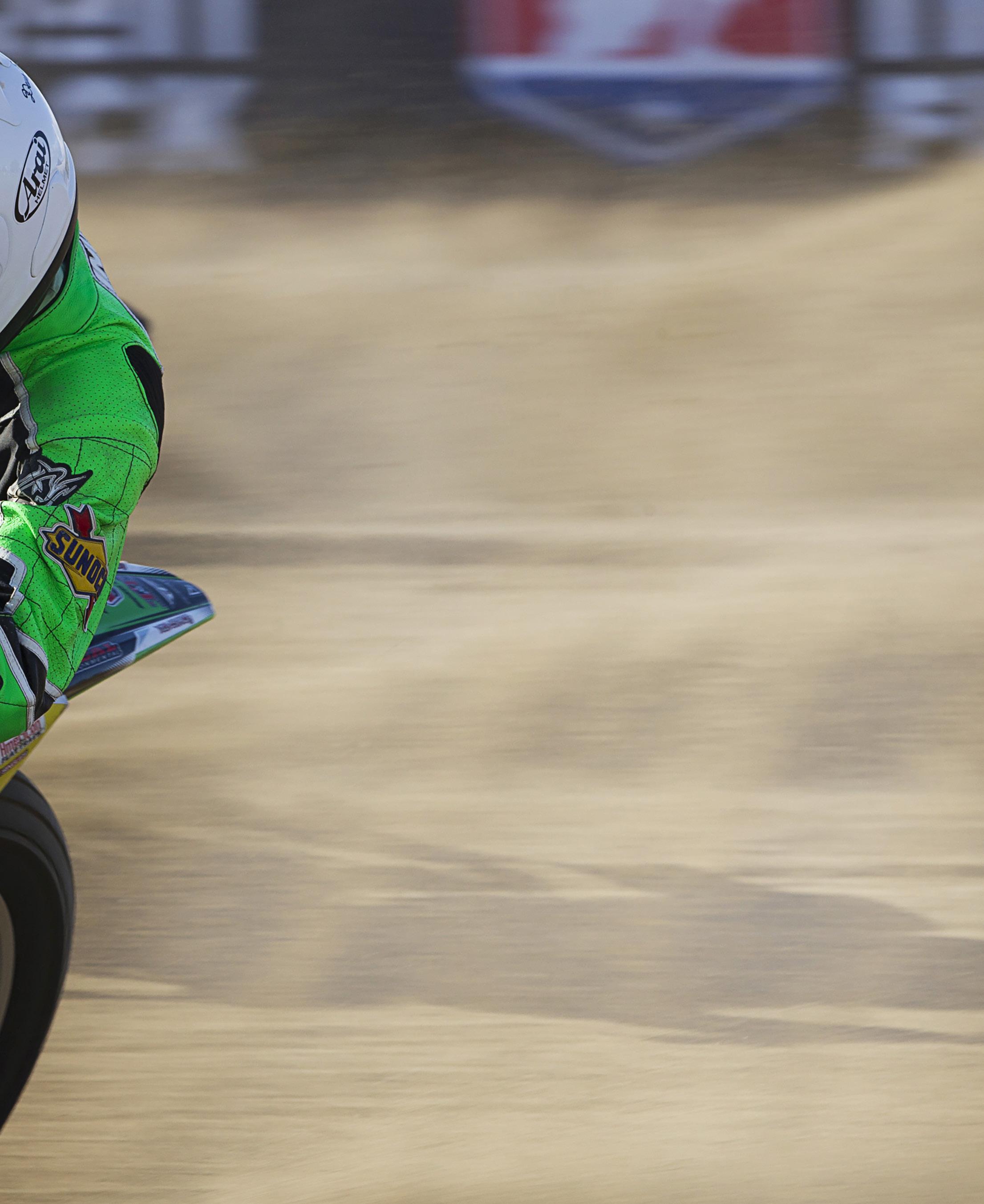
By the end of the season I was feeling better than ever. I failed to qualify for the main four times out of 18 rounds [Shayna Texter, who finished third overall, missed the main six times]. I was seventh on a very technical track in Dallas, Texas, and sixth at the season finale in Perris with the second-fastest lap in the main event. I was joint eighth on points out of 65 riders who scored championship points in the 2017 season.
MENTAL HEALTH
The toughest part about the season was leaving my family at home. Facetime is just not the same. Although it gets me down at times, I love the sport and think of all the years I’ve dreamt of being able to do what I’m doing. Mental health is the biggest thing in this sport. How I do on the track depends on how I feel when I zip my leathers up. If I wake up smiling and feeling excited, I’ll ride well. This seems to be related to diet, exercise and sleep, but when I don’t feel my best I have to blank it all out and concentrate. This is my target and what it takes to be a champion. I know my ability and speed and feel I improved during the 2017 season. My self-belief, and knowing I have the same chances as anyone else, increased. It’s not the bike, it’s not the mechanic or anyone else, it’s just me. I know I’m as fast as anyone out there and I’m just finding a way to pull all the strings at the right time. This season I noticed I was happier when I put the strong, relentless rides in, but didn’t quite get the position I wanted, rather than when I could have ridden better but still got a decent result. I’m looking for consistency rather than a one-off hot lap. I need to stay cool, aim more for the top, but most of all keep a smart and calculated approach to racing.
‘IT’S NOT THE BIKE, IT’S NOT THE MECHANIC OR ANYONE ELSE, IT’S JUST ME’
Strip it down. Your life, and your bike. The new Scout® Bobber from Indian Motorcycle® gives you more of what you need and nothing that you don’t. The Scout® Bobber takes a minimalist approach to aggressive street style, proving that less is truly more. A slammed stance, chopped fenders, blacked-out styling and 100 barely-tamed horsepower make this bike more of a tool than an extravagance. Build your own at indianmotorcycle.com







©2017
Indian Motorcycle International, LLC. Always wear your helmet. Never drink and ride.
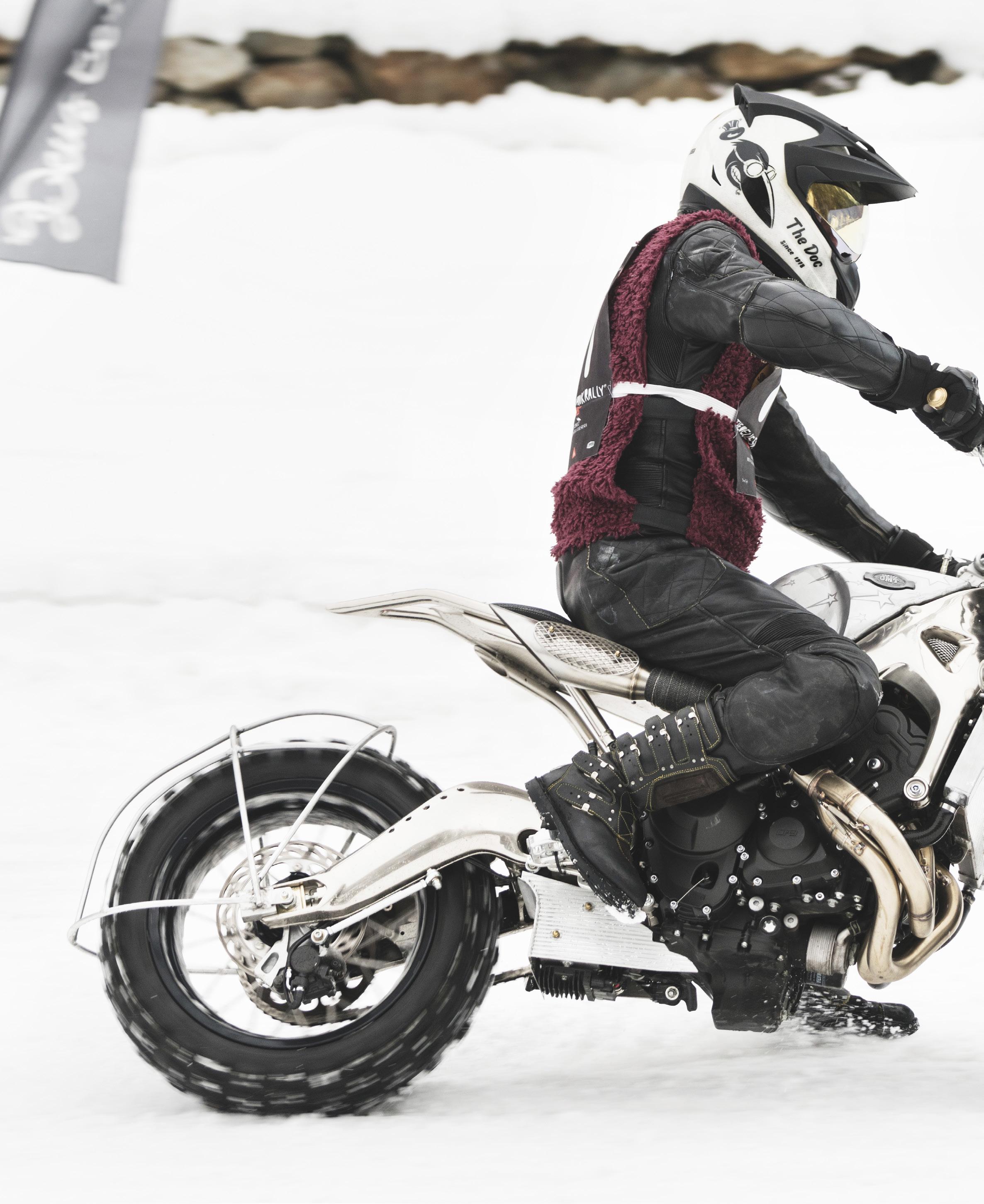
star dust
This XSR900 fell to earth to challenge your perceptions of what’s hip
 Words: Gary Inman Photos: Tom Bing
Words: Gary Inman Photos: Tom Bing
THE RETRO WORLD is one of diminishing returns. The past has been mined until the seam offers next to nothing new. Now, when you hear the word hipster, especially when associated with motorcycling, the image of a smartly dressed guy or gal, head to toe in heritage brands, riding an updated classic or a modern retro, is all that fills your head. You’ve been conditioned by repetition to think that is what a hipster is, but the term has been beaten into meaninglessness. True hipsters are early adopters, they give a movement traction, before moving on. They’re plugged into the grapevine, picking up the vibes, they’re not followers, and they are certainly not to be sneered at: the wealthy London Guardsmen of the late 1940s and early ’50s who dressed in Edwardian style; the early Teds of 1954 and ’55; the modernists of the late 1950s, who gave birth to mod... But they’re only hip for a while, then the subculture reaches the mainstream and the originators are already gone. I realise language mutates over time, but this misuse of hipster needles me. The dude in boxfresh Redwings paying for a Triumph Thruxton on a PCP deal is part of the herd not hip, and there’s nothing wrong with that. The heritage style is one that suits a lot of people. It will dominate for a long time. But hip it ain’t. OMT Garage’s Stardust is a machine that could not be more hipster, but few may categorise it as so. Marco Troiano has mashed styles and techniques to make something fresh from a brand new Yamaha XSR900. It forms part of Yamaha’s Faster Sons programme, you know, different customisers from around the world modify current models from their Sport-Heritage range.
> 53
‘OMT GARAGE have mashed different styles and techniques to make something fresh from a brand new Yamaha XSR900’

Get A Grip
We’ll be honest, we weren’t mad about the metal grips, but Marco wanted to shake things up using different styles
Fuelproof
OMT Garage threw the kitchen sink at their Faster Sons build, creating many new parts including the alloy tank
Fat And Tubeless
Borrani tubeless rims are laced with pencil-thick spokes
Get The Point Seat rails end in a spike sharp enough to have your eye out. It’s more of a dom-frame than a sub-frame
Superfly Screen
Is it a tribal mask or Kendo swordsman’s face shield? Metallic praying mantis head?
Big Brake
Single front disc and caliper were uprated using Italian Discacciati components
Guard Be Gone
OMT Garage made a cool-looking front guard, as specified by SnowQuake’s rules, but it got mangled

Grip Not Slip
The ADV riders’ favourite, Continental TKC80s were fitted with hundreds of Koldcutter racing screws
>
‘Yamaha Italy asked us to not build the usual scrambler,’ says Marco, proving Yamaha have a grip on hip. ‘Usual’ is the key word in that sentence. When was usual ever hip?

‘This was the first time that we had modified a Japanese motorcycle,’ Marco explains. ‘We normally work on Italian or German motorcycles.’
OMT Garage is a family business, dating back to 1978. Originally, Marco’s father concentrated on repairing trucks. Marco and brother Mario grew up in the business and at the end of the last century incorporated bikes and have built an enviable reputation in Italy.
‘The bike is named Stardust because it was built during nights under the stars, in three months,’ says Marco. He made most of the custom parts himself, including the alloy fuel tank, steel three-into-one exhaust, bars and controls. He even made the leather and Alcantara



OMT Garage refer to Stardust as a scrambler, not a ‘usual’ scrambler. Though it has elements, it’s hard to stretch the description that far. It’s a class act and, like so many Faster Sons customs, built to turn heads
seat and modified the frame and swingarm. The engine is standard, except for the addition of an alloy airbox, but he has removed the traction control and ABS rider aids, ‘Like the old stlye,’ smiles Marco. The 2017 Yamaha makes 136 horsepower (similar to the last GSX-R1100s). Then Marco brought Stardust to SnowQuake in the Italian Alps to race. I’d seen him at last year’s event, full-lock on a liquid-cooled Vertemati, which was being raced this year by Moto3 racer Tony Arbolino. I wasn’t a bit surprised to discover that Marco had raced in the Italian national supermoto championship from 1998 until he became a father in 2007. Neither was it too much of a surprise when Marco and Stardust won SnowQuake’s Inappropriate Road Bike class.
This XSR900 challenges conventions and you might not like it for those reasons, and that’s fine. You’re just not hip enough…
Bars, triples clamps, pipe, seat, sub-frame and so much more were all made by OMT Garage at the workshop, a few miles north of Milan. A deep understanding of racebikes melds with almost theatrical bling









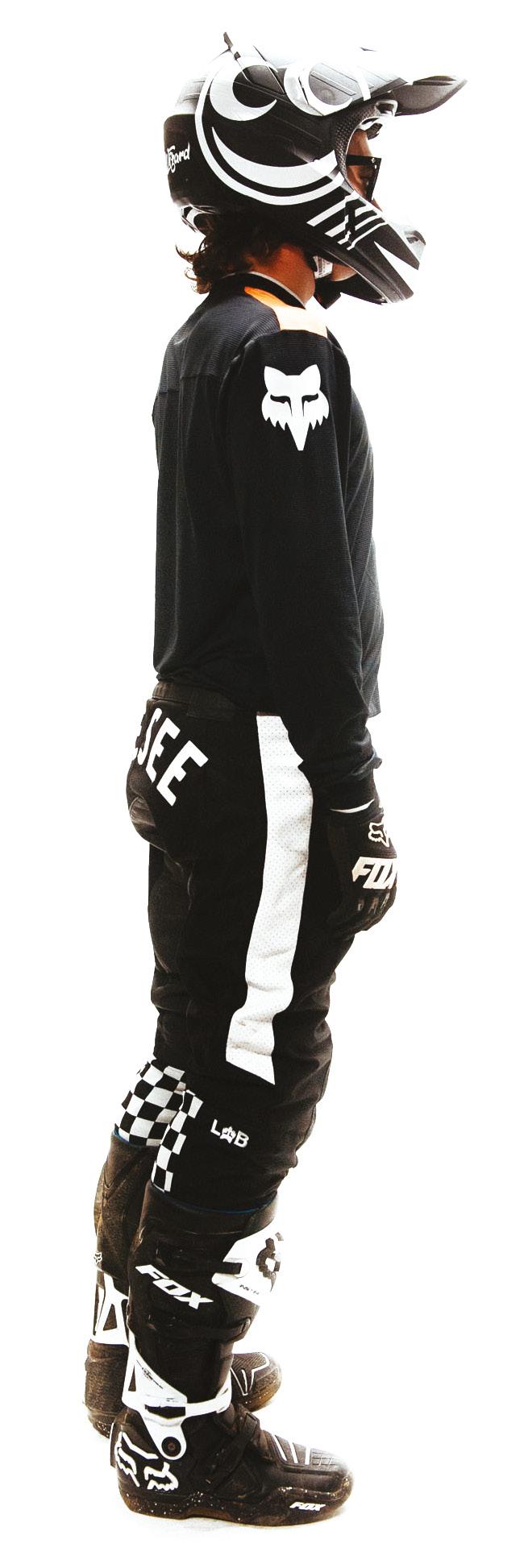
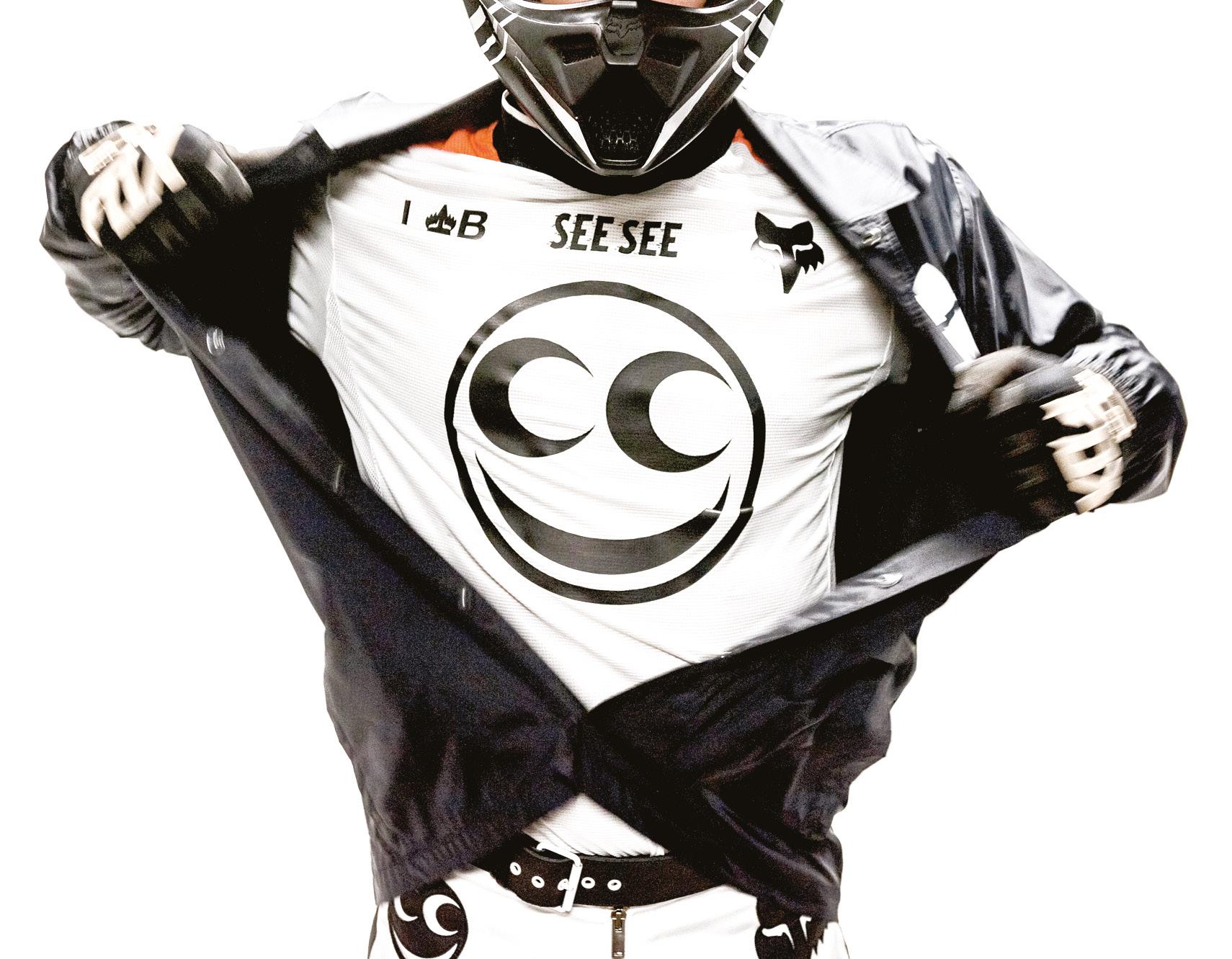





‘Andrew and Scruff in the dirt, fixing a 50-year-old Brit bike. Again. In the background, one of ‘Team Orange’, an ADV rider on a modern KTM Adventure, blasts past. But the classic riders will have their revenge in Red Rock…’ Words: Hayden Roberts Photos: Scott Toepfer 61 >
HALLOWEEN LEFT A dirty trick this year. Scott Toepfer arrived at the shop with his newly acquired BSA – a fresh restore, allegedly. ‘It won’t start, but you’ve got a couple weeks,’ the photographer and Sideburn contributor told me. After a complete teardown and rebuild, Scott’s BSA would round out our trio of bikes for this year’s LAB2V: Los Angeles –Barstow – Las Vegas ride.
Thanksgiving rolls through and next thing we were at the Hotel Palmdale, the start, with two BSA Hornets and my ’67 Triumph Bonneville TT. The first casualty of the ride was Andrew’s 1970 Ford Econoline, which left him stranded out on the edge of the Mojave. He was pissing up a Joshua tree when the alternator gave up. Andrew and I did last year’s ride on these same Hornets. Andrew’s is named The Backdoor Man due to the ’60s metalflake petrol tank he found on eBay. We built a bike around it, pleated leather seat, gold hubs and all.
Day one
After a couple hours’ sleep we made it to tech inspection, picked up our roll chart, GPS route and entry sticker. Off we went. Not the earliest of starts, so we headed into the desert behind 500 or so modern bikes, into direct sun and 1000 wheels’ worth of dust on a single track skirting the hills of Palmdale. Tracking the GPS? No chance. I’d grabbed some stray tarp and fashioned a visor with duct tape. It was all I could do to not lead everyone off a cliff. Adapt and overcome, as they say. Ten miles in, Scott lost the AutoZone headlight he’d mounted to pass tech, in turn blowing a fuse. Without a spare, we shoved some safety wire in the fuse holder, which held the 100 miles to lunch.
A little about the LAB2V. It started in the late ’60s as a desert race from Barstow to Vegas. It ran on and off into the late-’80s when eventually the Sierra Club1 got it shut down. They claimed riders were using the desert tortoises for traction, or something like that, I forget the details. Sometime in the early-2000s it was revived and is now billed as the world’s biggest off-road ride, taking place every Thanksgiving weekend. No longer is it a
race, entrants are capped and speed limits enforced in preservation areas. The course changes every year, it covers between 450 and 500 miles over the two days and you hit everything – fire roads, dry lake beds, hill climbs, rocky river bottoms and sand... a fair bit of sand.
At the first gas stop a couple more Triumphs joined our group. The Jerkyls Andy and Scruff, Australian flattrackers and friends of Sideburn, who bought a couple of bikes off Craigslist and flew over to do this ride. Scruff let me know the 500 Triumph he was on was advertised as being ‘tuned by Hayden Roberts’. I’d admit to it if it made it to Vegas.
The ride from this gas stop to lunch never fails to amaze me. For all the untouched land, the organisers always seem to lead you through the city dump where you spend ten to 15 miles dodging couches, microwaves and nail boards that seem intentionally placed to cause damage. Survive that and you have hours of open desert until lunch.
After a quick sandwich, I led the group west through Hodge Road. We were a bit further west than I’d considered and we wandered through what had become a family holiday artillery range. We’re off the roll-chart now and I was the Pied Piper. With every late-braking turn and shaleriddled peak we traversed I could feel the glares from the rest of the group getting more intense.
‘I know the way, honestly. There’s a bar just the other side of those hills.’ I know this part of the course pretty well. Slash-X, a bar and staging area for many of our desert rides, was not too far in the distance. No, really.

The Backdoor Man, Andrew’s BSA, blew a tube and we were out of spares, we’d given ours to guys stranded on the trail. ‘Just zip-tie the tire to the rim, it’ll get you to Slash-X.’ And no, I wasn’t taking the piss.
Barstow
We made it to the hotel and pulled out the tools, time to assess the damage. Andy Jerkyl’s 650 Desertmaster (a rare variant of the Trackmaster frame) was unloaded from the chase truck with a sheared woodruff key and heavy grooves in a tore-up mainshaft. ‘We can weld it and it’ll hold or try JB weld,’ I suggested. ‘Your call.’
Appendix 1 A California-based environmental organisation founded in 1892.
‘We wandered through what had become a family artillery range. We’re off the roll-chart now’


>
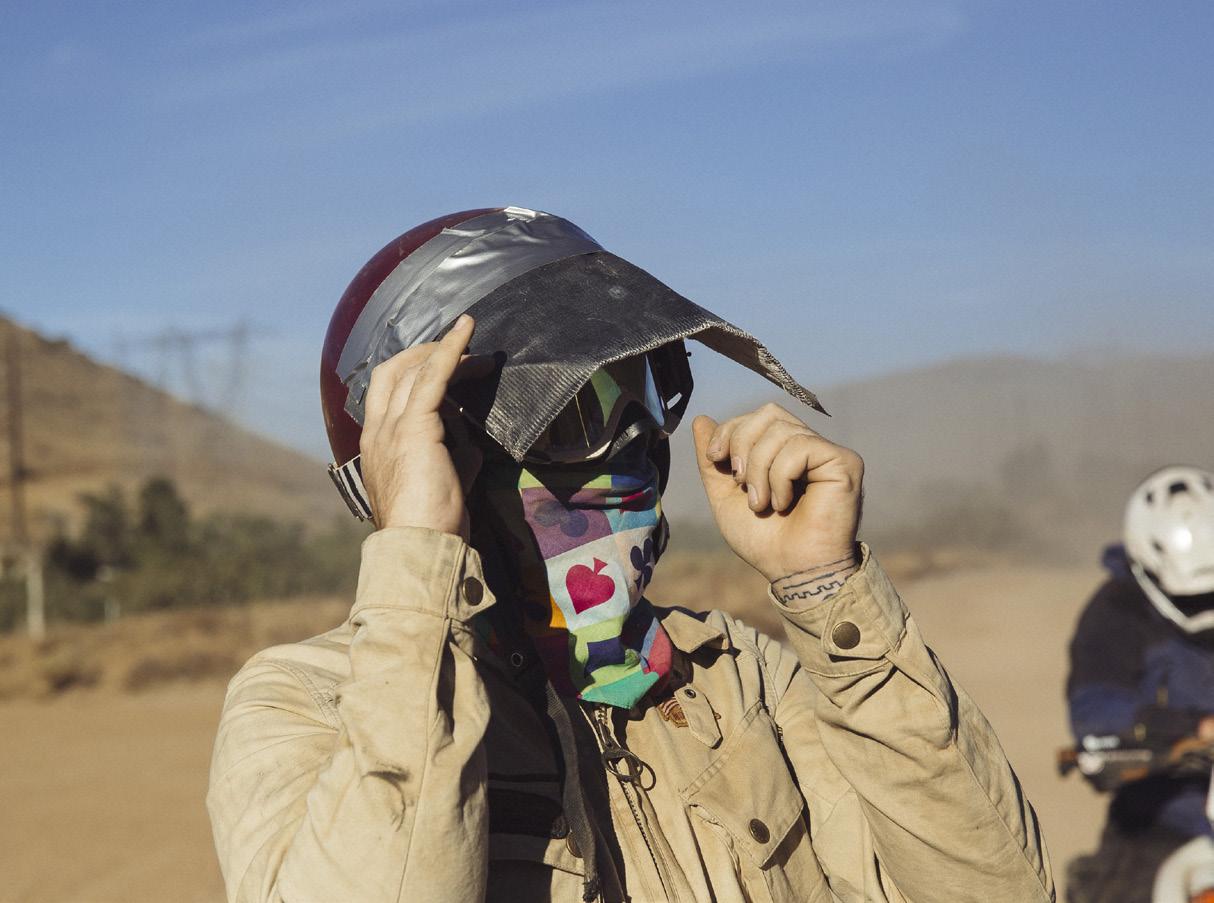
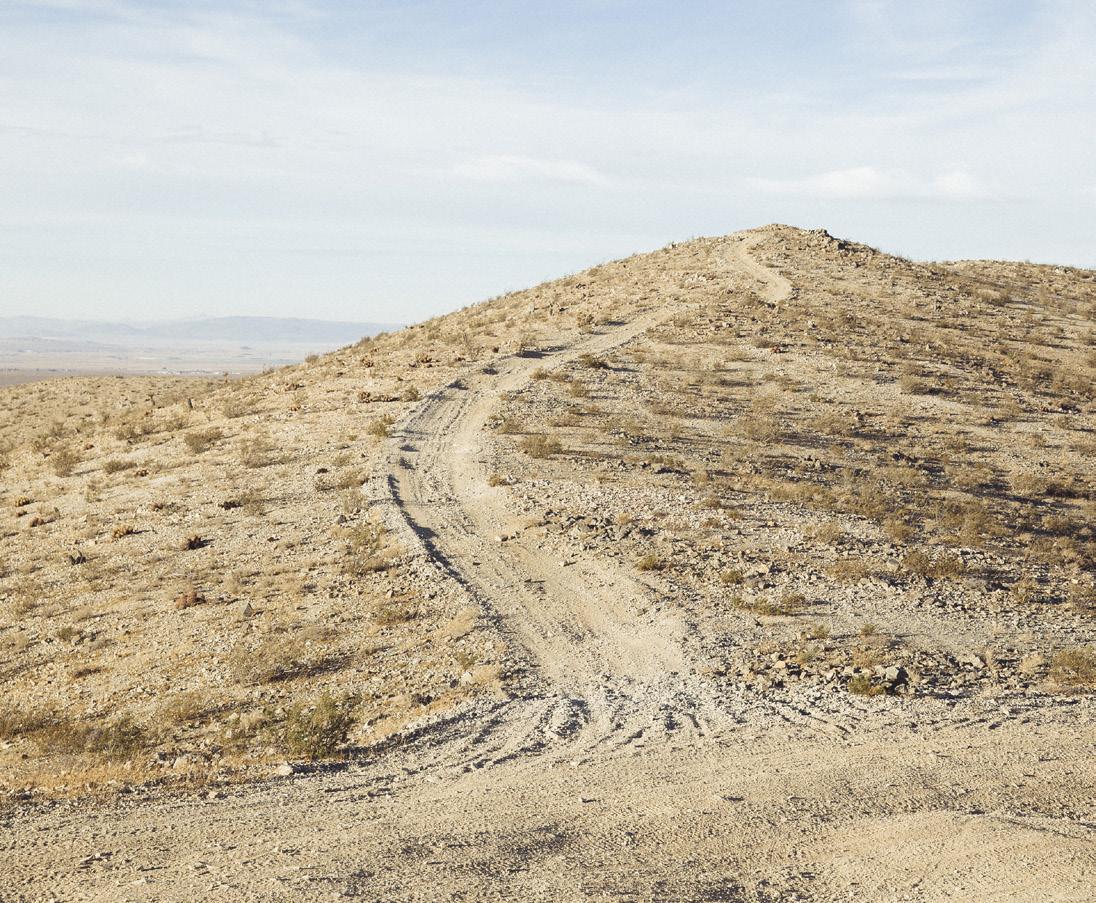



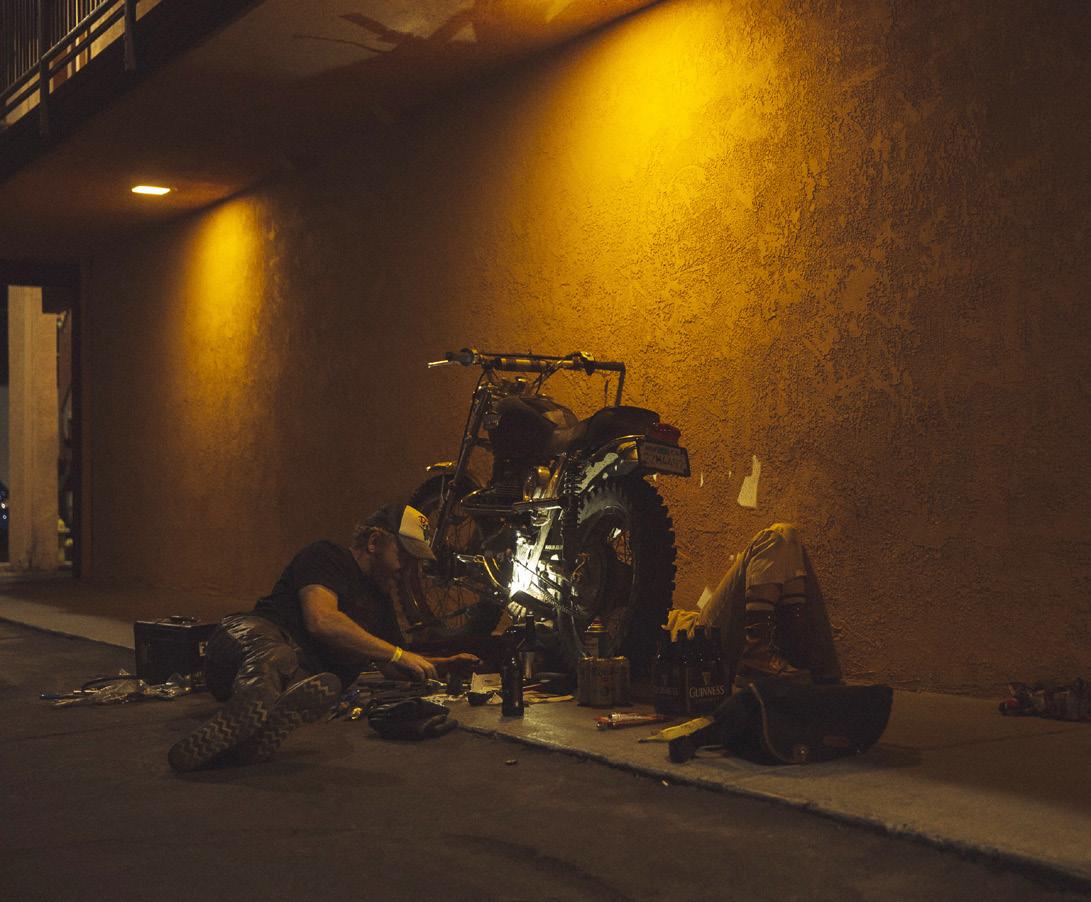
(left to right) If your yard sale was low on attendance it’s because I nicked your sign to make a visor, sorry; Mountain? Mole hill?; Andy Jerkyl; ‘You promised us a bar!’; Scruff’s not impressed, hand on hip says it all; Scott’s BSA had been hibernating in a NY basement a couple weeks earlier; Scruff’s 500 was the smallest bike in the group; The bikes are usually fixed in the rooms but the weather was nice this year; Horses for courses, but everyone remembers the donkeys that ran the Grand National
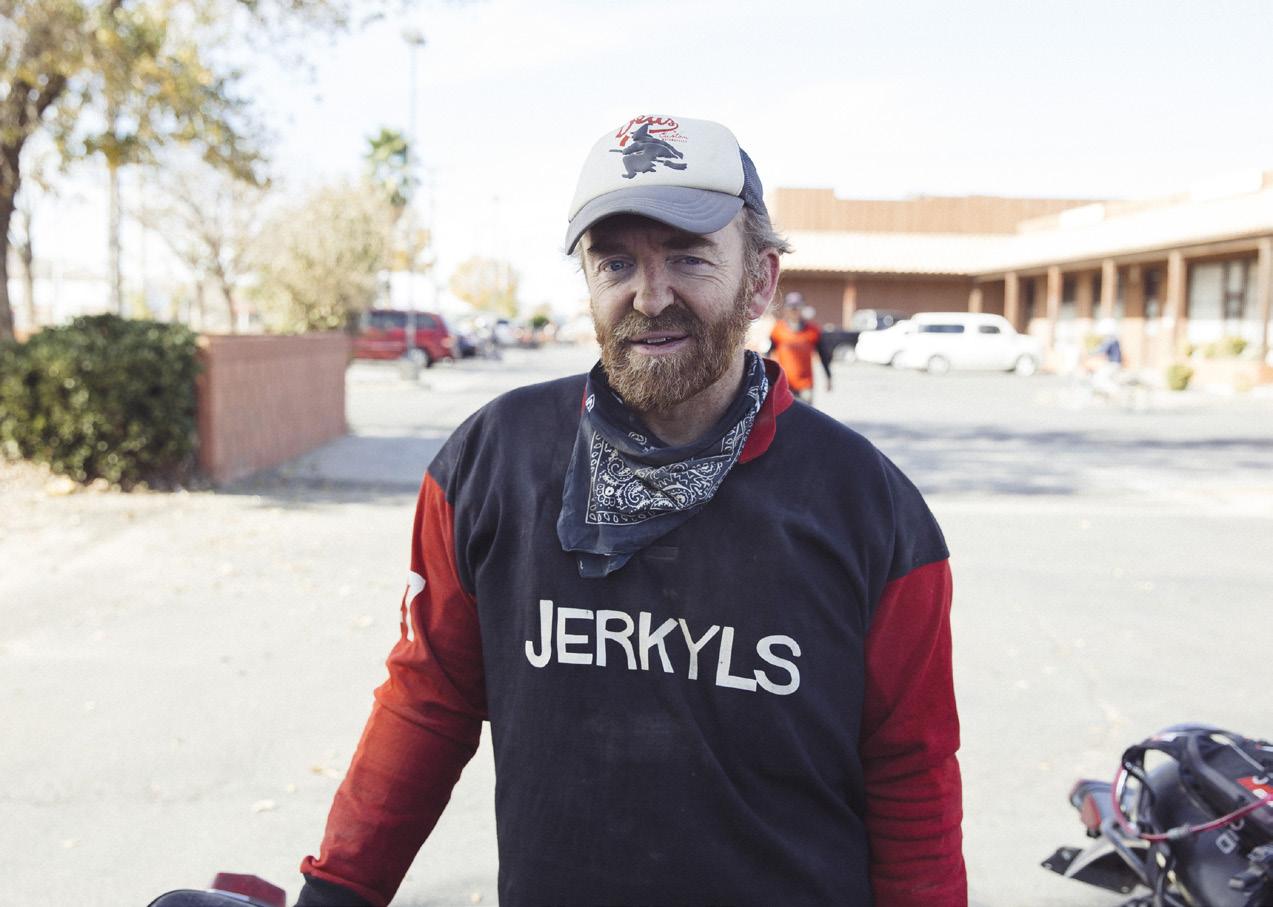
DESERT PROOFING
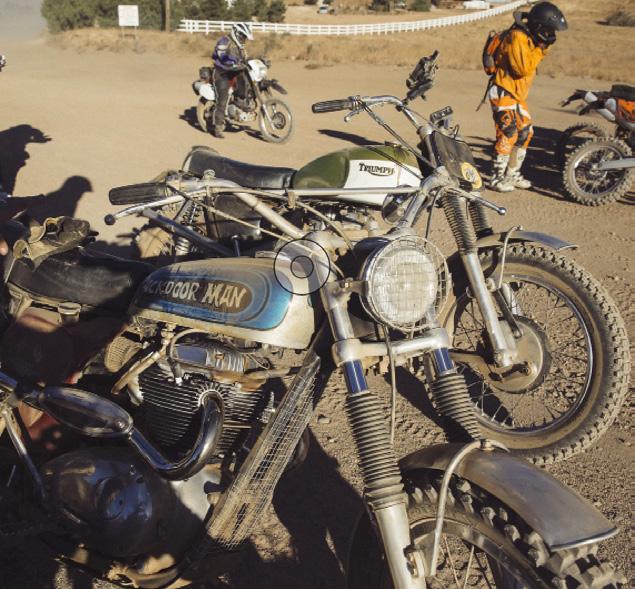




The Triumph I’ve been riding for the past couple years started life as a 1967 Bonneville TT Special. I rebuilt it with Megacycle cams, balanced the crank and fitted a five-speed gearbox from a late-’70s model. It runs batteryless with electronic ignition. A Ceriani front end with Progressive springs handles much better than the stock set up. I switched out the front hub with a half-width one from a BSA Gold Star. They’re lighter and stop better than the Triumph ones. I fitted Works Performance shocks with an inch more travel than stock, a Bates desert seat and strengthened folding footpegs. A big air cleaner and a skid pan are essential for any desert riding. I just try to build them as light and simple as possible. I usually use the TR6 models, the single carb head and heavier flywheel is more suited to off-road riding, however this bike’s been bulletproof. In two years of desert riding its only broken a clutch lever, snapped while loading it into a truck. HR

>
Andy went with the JB, the thought of welding the clutch hub to the gearbox of his 12-hour-old bike didn’t seem all that appealing. Meanwhile, Andrew rolled into the local repair shop, zip-tied tyre and all. The shop assistant, somewhat bemused, asked if he could take a photo.
Day two
All the bikes in our group were underway. Buck, a friend of ours from Ventura, had joined up with us during the previous evening’s repair seminar. He was riding a 1965 Triumph TR6 we’d finished building the weekend before, it looked too clean and hadn’t even been broken in yet.
The first part of day two is always a drag. It’s usually a lot colder and involves 40 miles of sandy whoops, but not for our group. At this point the ride had become more of a greatest hits from years past.
I knew there was a trail that ran north of the train tracks not more than 100ft from the designated route, a glorious high-speed fire road with dips and slaloms. We were racing along in the interrupted shadows of Union Pacific freight trains, Andy’s Desertmaster tucked in behind me. I guessed the JB weld was holding. The centre gas tank mounting bolt on Scott’s bike had sheared and he’d resorted to an ever-expanding collection of bungees to secure the tank.
We picked up the marker ribbons at Razor Road. Straight away The Backdoor Man got another flat. Luckily, Scruff the mobile tyre changer was on hand. It seems that the hotter, grimier and more uncomfortable it is, the more the Australians enjoy it.
The world’s largest thermometer appeared on the horizon: Baker, California. We set up camp in a defunct motel parking lot and topped up on oil, gas and tea. The Desertmaster had made it three hours before ending up in the chase truck. Three hours: that’s what you can expect outta rigging your clutch hub with liquid metal.
There are lots of fast fire roads from Baker and we were all running street gearing. You can really get cooking and start passing the modern dirt bikes. They always doubletake when a group of old parallel twins goes blaring past. We chased the dust clouds that tie the road to the sky all the way to Sandy Valley. These bikes and I are
transplants from colder climates. A weary gang from the West Midlands all putting along at a decent clip.
We skipped the lunch stop. There’s a mandatory checkin and a couple of bikes that were legal 400 miles ago weren’t so much anymore. Also, we were making good time and wanted to get into Red Rock Canyon before the adventure bikes.
The first question you’ll be asked at the finish line: did you go through Red Rock? It’s a canyon on the south end of Vegas. A hard right off the main road leads you into a couple miles of loose gravel and jagged rock. You dive down into the Rock Garden, a quarter-mile-long ancient riverbed laced with loose stones and boulders the size of hippopotamuses. From the far end it looks impassable. You just have to pick the right line.
As the old 1950s ads proclaimed, ‘It’s easy on a Triumph!’ And it really is, you’ve got all the torque you need combined with a low centre of gravity and, in a pinch, both your feet can reach the ground. We picked our way through the rocks and around downed R1200GS BMWs and decal-covered KTMs. Once clear of the melee we shoved our bikes between some trees and walked back to watch the carnage unfold. If you write on the roll chart ‘very difficult/for experienced riders only’ you quickly get 200 novices trying to prove their salt. We sat and watched guys whiskey throttle up the canyon walls, topple over and scream at each other for stalling, hands on hips and heads shaking in defeat, some give up and turn around… the bail-out option came calling.
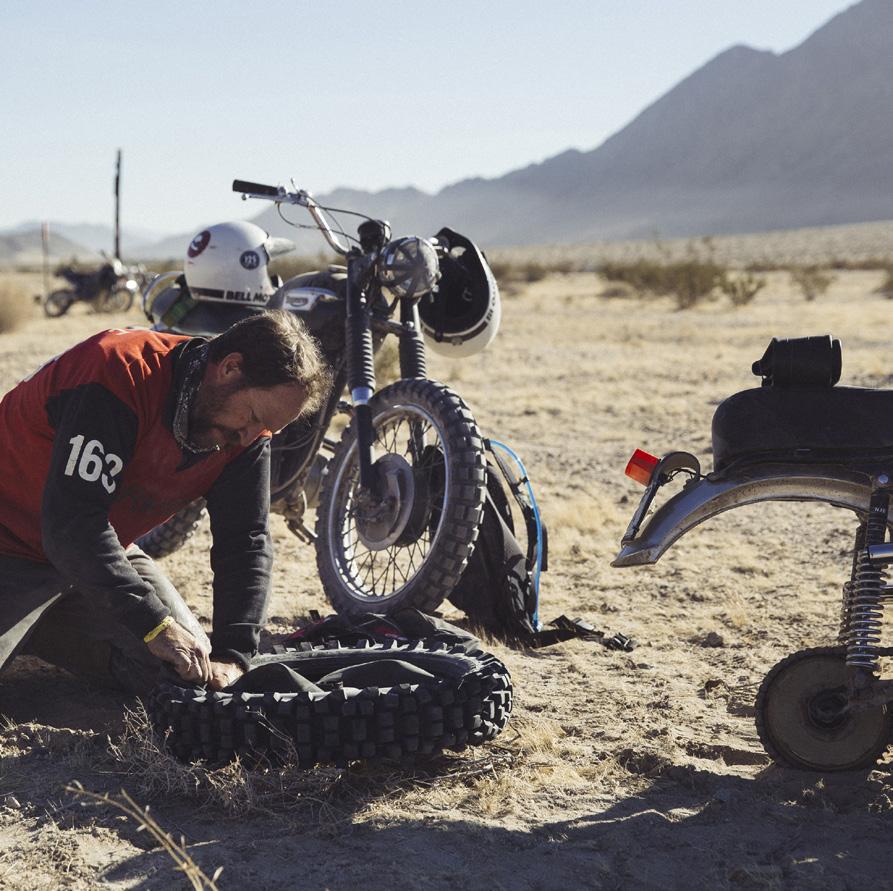
Scott pulled into view, with Buck close behind. They’d got caught up and Scott’s BSA clutch was on its last legs. No time to let it cool, there were 400 guys with itchy wrists heading this way. Being the gentleman he is, Scott whipped that Hornet all the way up to our little parking area. Much cheers and applause.
The ride down the canyon was the highlight for me. You descend from around 4400ft to 2000 on steep switchbacks. The dirt glows red as the sun ducks behind the mountains. From here you roll into the Orleans parking lot where showgirls and a cold beer await.
And there we were, the BSAs, the two 650 Triumphs and the 500 Triumph Scruff had bought off Craigslist all huddled together, a vintage island in a sea of orange.
‘You made it through Red Rock… on those?!’
‘A couple of bikes that were legal 400 miles ago weren’t anymore’
The road out of Red Rock Canyon. Tarmac from here to the lights of the strip. (below) Survivors have cold brews with Hayden’s wife, Joy, and the team’s emotional-support dog

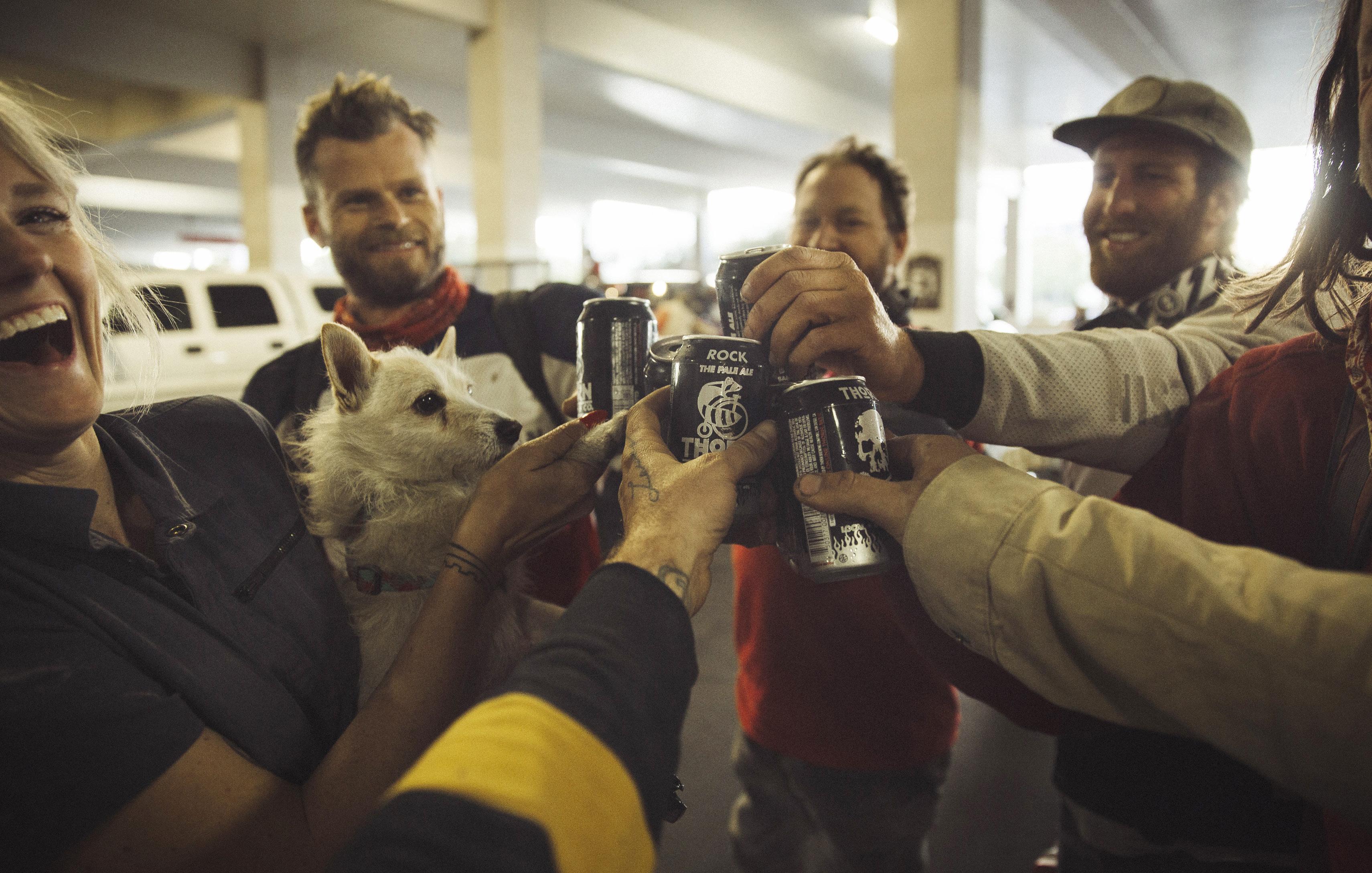
>
SCOTT’S 1967 HORNET
While most of my friends had done the ride many times, it was my first time gathering the stones to try LA-Barstow-Vegas. Many of those same friends have also learned that I don’t make motorcycle choices based on reliability or raceworthiness. Hell, I’ve driven more miles than I can count just to race a bike that wouldn’t even start when I got there. So to add to the LAB2V challenge I thought I’d give it a go aboard my recently acquired 1967 BSA Hornet.
With perhaps 50 horsepower, roughly 380lbs of weight and packing all of three to four inches of suspension travel, I thought I had a feeling of what I was getting myself into, but the expression I kept hearing slowly began to make more sense… ‘75% of the way on a BSA’.
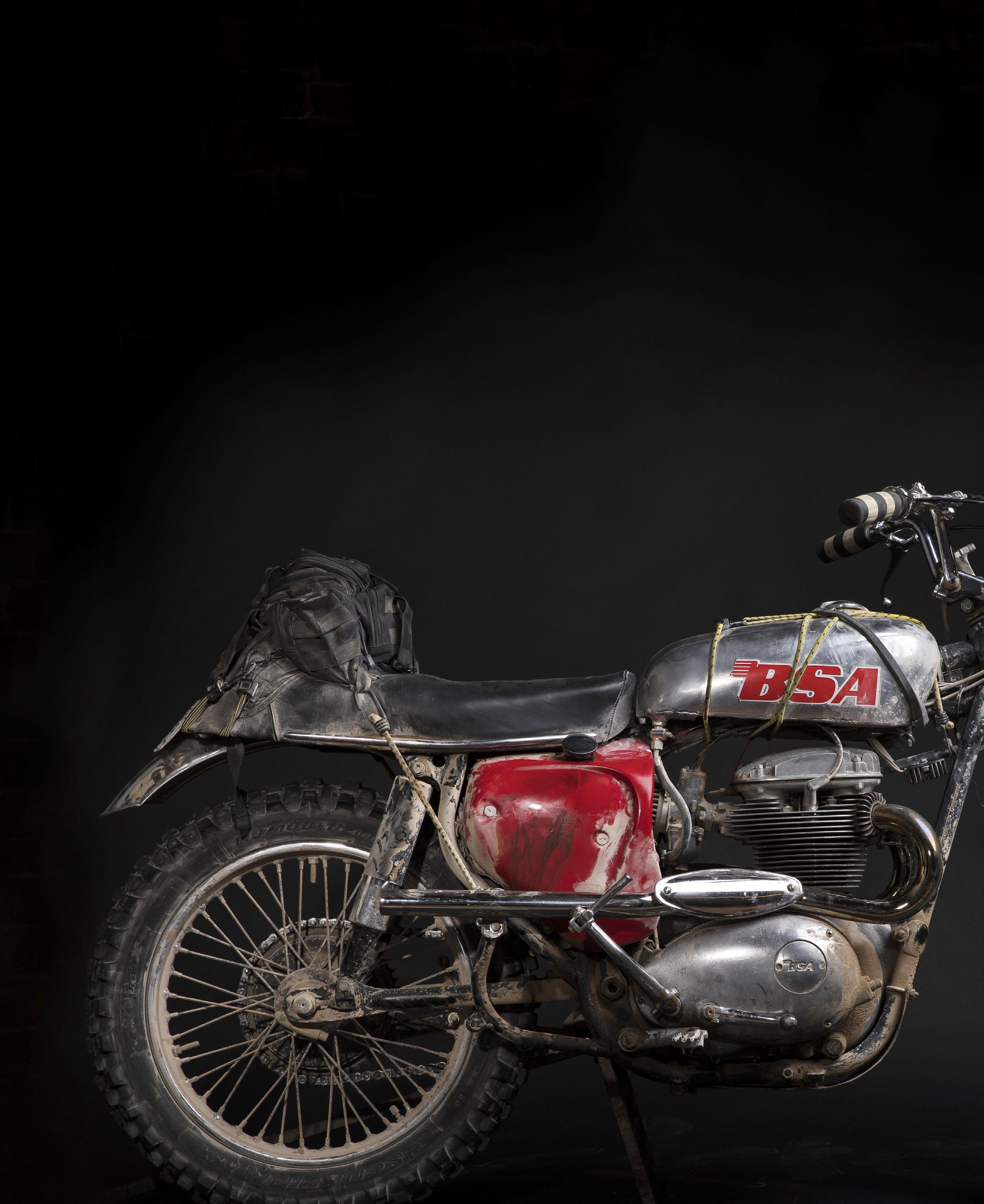
After mounting up some desert
knobbies, wiring lights and fitting mufflers with wire mesh spark arrestors, I passed tech inspection in the dark. I was ready to roll. The excitement and nerves overpowered doubts of whether or not my GPS would work, or if we had enough water and gas to make it to the next stop.
Hayden describes most of my mishaps. Yes, 15 minutes into day one, the cast aluminium bracket holding my headlight snapped. At least I got it out of the way early. I officially needed to finish before dark.
The first day went like this: fall behind old guys on fast straights and then pass old guys in the dirt. Get gas, get lost, get stuck in sand, tell newcomers who’d joined our group I was ‘fine’ and then find the road to the next gas stop. When it was fun, it was FUN. When there was no service
and no help, it was a characterbuilding experience in a grittingyour-sand-filled-teeth kind of way.
Day two started with high hopes, but within ten minutes my gas tank mount snapped. It was a weak link we’d been watching since the beginning. My ‘support’ team stopped just long enough to dump a pile of bungees at my feet before heading north. I used all of them, and jumped on I-15 to catch up.
During all of our preparation, we’d had the Red Rock Canyon section in the back of our minds. We tried to save our motors and clutches for this last hurdle, and while most of the guys made it without problem, I did not. I was stuck at the bottom of the ravine with very little clutch left. I walked, scooted, pushed and got a few boosts as the bike
Words & photo: Scott Toepfer
managed to climb foot by foot closer to the top.
The ‘hard way’ was really HARD here. Watching $20k adventure bikes topple over and their pilots look up and ask for help picking them up was the only salve for the sting of my embarrassment. I wasn’t the only one begging for relief and a cold beverage at this section and we all shared some laughs.
I believe seven vintage bikes crossed the finish line of the 34th LAB2V Rally. I was promised showgirls and photo ops, but instead I got a parking garage full of new and old friends and cold drinks. This will forever be the most fun I’ve had in a parking lot.
As I drove back to Ventura, the high from completing the run faded and I made a list of my BSA’s mechanical casualties:
Broken gas tank mount
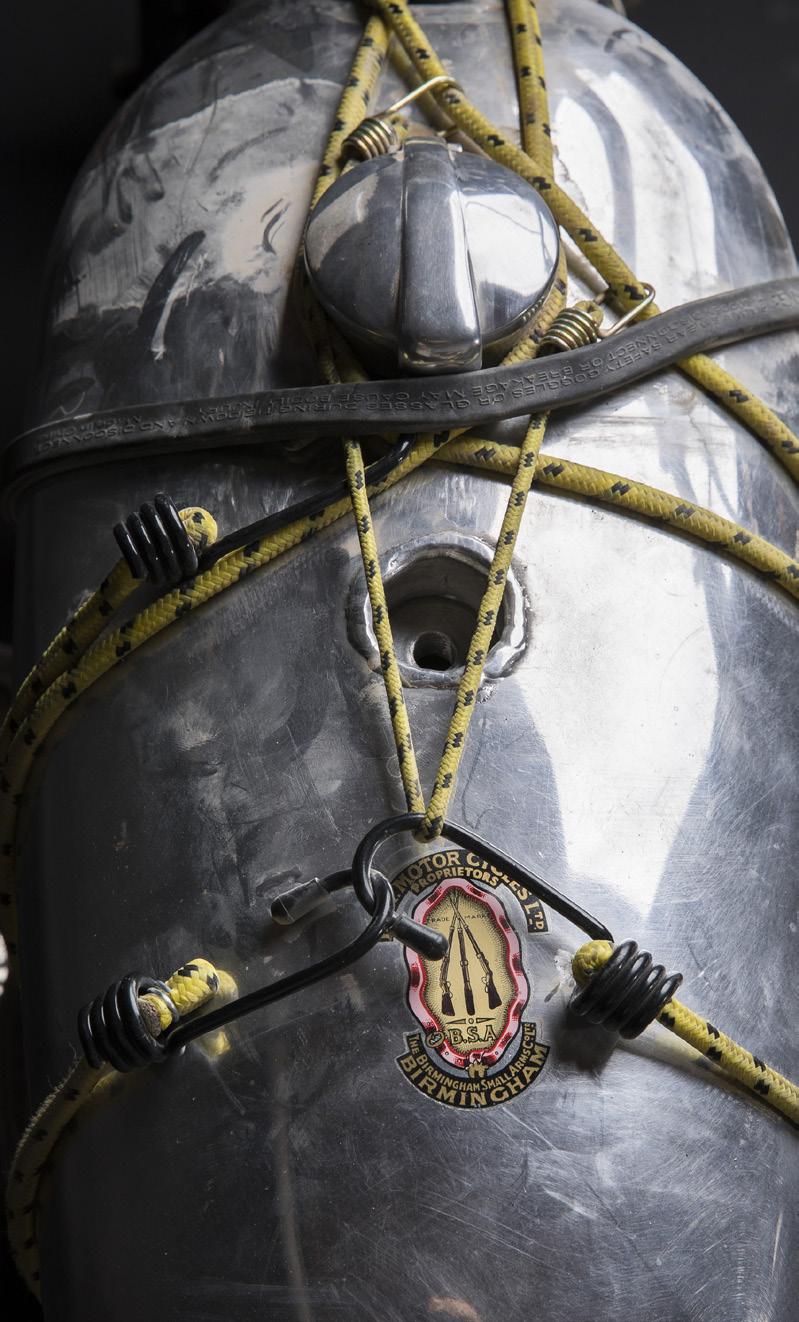
The hastily rebuilt 1967 BSA just as it finished the 500-mile LAB2V. But finish it did



Broken oil tank mount
Broken foot pegs
Fried clutch
Broken brake cable Bent levers
Broken brake pedal
Replaced foot peg mount
Broken headlight mount
Torn seat
Broken front fender mount
Blown fork seals Bent handlebars
In retrospect, I’d definitely attempt this ride again on this bike again. I’ve got a better lay of the land and know what to expect. I’ve also made tools that will work in these scenarios and learned a lot about the bike itself. My competitive nature wants me to have a fast, light, highperformance bike, but I really do think that the ride would need to be significantly more challenging to match the engagement that a vintage rally requires. I love this old bike.
While I would’ve been happy to sell it if it hadn’t finished, it has finished, and now I’m attached to this dirty, broken piece of English manufacturing.
Here’s to many more adventures!



Interview: Gary Inman Illustrations and captions: Sami Graystone TheEnglishartisttalks bikes, blood, pain and inspiration 71
Sami Graystone could have ridden off the page of a Tarantino script. As a schoolgirl she helped out in the family slaughterhouse, in adulthood she sold brassieres by day and played in her two-piece, dark, raucous folk band. Statuesque in double-denim and a Biltwell Gringo, she rides choppers, baby, and currently walks with a limp from a lifechanging crash. Then there’s the art. This art. Time to flesh out the script. ACTION!

‘I’m a Yorkshire lass living in Wales. I come from a proud, working-class family from Hull and spent my early years either trackside as Dad and his brothers raced stock cars, or helping out at the family butchers and slaughterhouse, delivering meat, pressing
‘I’ve always been good at drawing, as a shy, deep-thinking kid it was a form of expression and escapism. Through high school it turned out to be a helpful tool, making people laugh by drawing silly caricatures of teachers. From the age of 14 I used to go round shops I liked in Hull and ask if I could do artwork for them, in return I’d get cool clothes, clothes I couldn’t afford otherwise, it was a sweet deal.’
Sami has been on our radar for a while. A while back, there weren’t many young women riding bikes in West Yorkshire (where I grew up), especially not ones riding Yamaha FZR400s in skintight jeans.
‘My family are petrolheads, anything with an engine is not safe in our hands, it’d either get taken apart or smashed to pieces. And bikes have always fascinated me. They were always around while I was growing up. My brother got into dirt bikes and then sports bikes, but I knew they weren’t really my thing.
‘As soon as I got a bit of money from a university loan, I knew what I was going to spend it on. I got my licence and my first ever bike, a Yamaha SR125. I went everywhere in England on it and commuted the 50mile round trip from Huddersfield to Leeds every day, no matter what the weather, wearing a million layers to stop me getting hypothermia. I loved it.’
Sami’s art used to be mainly commissionbased, servicing the skate and DIY music scenes of West Yorkshire, before branching into the international chopper scene in recent years, but a serious crash forced several fundamental changes in her life.
‘In September 2016 a car pulled out on me while I was riding my Kawasaki 650 chopper.
‘I spent my early years either trackside as Dad and his brothers raced stock cars, or helping out at the slaughterhouse’
(left to right, from top)
‘The Reaper’

For one of my first and most successful Meat Hook products, the Reaper Raglan
‘Devjo’ Jodie Devaney, on Audrey, a beautiful customised Honda CX500. She’s a regular on the speedway track, competing in DirtQuake. I love her to bits
‘Live fast lid’ A recent shot of me customising a Biltwell Gringo

‘Tamara’ A colour pencil portrait of inspirational moto babe, Tamara Raye
‘Hatton’ Colour pencil sketch of our Chris tearing up the track


‘Eye-candy stickers’

For the Meat Hook, inspired by imagery from the ’70s/early ’80s >

I sustained a fractured skull, deep lacerations down my left side, my pelvis was shattered and separated from my spine. I was in a wheelchair for a while and then on crutches for what felt like forever, recovery has been very up and down. I still have days where I can hardly walk and the pain sometimes is unbearable, but on the whole I’m doing really well. I used to ride every day and being unable to do so was extremely frustrating, so I got back in the saddle around nine months after my accident. I needed to do it, even though the doctors didn’t agree, I just wanted to see if it still felt as good – and it did!’
Before the accident, Sami was building her own brand, The Meat Hook. ‘I started it in 2013 as a way of me doing something with my own artwork rather than just doing commissions. I started off by selling prints, with the money I made from them I bought stickers. I then volunteered my time at a local print house while working part-time elsewhere to pay the bills. In return for my time I was taught how to screen print. Then, with the money I’d made from stickers, I made T-shirts. I put my heart and soul into the company and eventually it became a successful little clothing brand.
‘Unfortunately, due to the [crash], it became harder to focus on the company and it lost momentum. I made the difficult decision to end The Meat Hook at the end of 2017.’
With work being out of the question while she underwent her lengthy recovery, changing priorities and new outlooks on life threw the whole pack of cards in the air.
‘I’ve gone from not having enough hours in the day to having all the time in the world and my artwork has turned a corner recently. I used to work a lot in pen and ink as it went hand in hand with the screen printing and logo design that I was doing for much of my commissions. Having so much time has meant that I can delve back into processes like colouring pencils and paint. I can enjoy the process of art again rather than having to watch the clock, seeing it as a business, time is money and all that.’
Sami upped sticks from the north of England to the south of Wales, recently moving in with her boyfriend – the tattooist, DTRA flat track racer, chopper builder and driving force of the FTH brand, Chris Hatton.
‘I find it important to have some social interaction as an artist. I’ve spent many years working from home and it can be really lonely and hard to motivate yourself. I used to work in a shared studio in Leeds, but now I

(opposite)
‘Cocaine orgasm’ For Ash Barrow. She’s building a chop around an XS650 engine.
Another moto sister who has my heart forever
(this page, left to right, from top)

‘Bunny Girls Bonnet’

Customised Gringo done using just rattle cans and pencils
‘Panhead Paula’ Another found image I couldn’t resist drawing
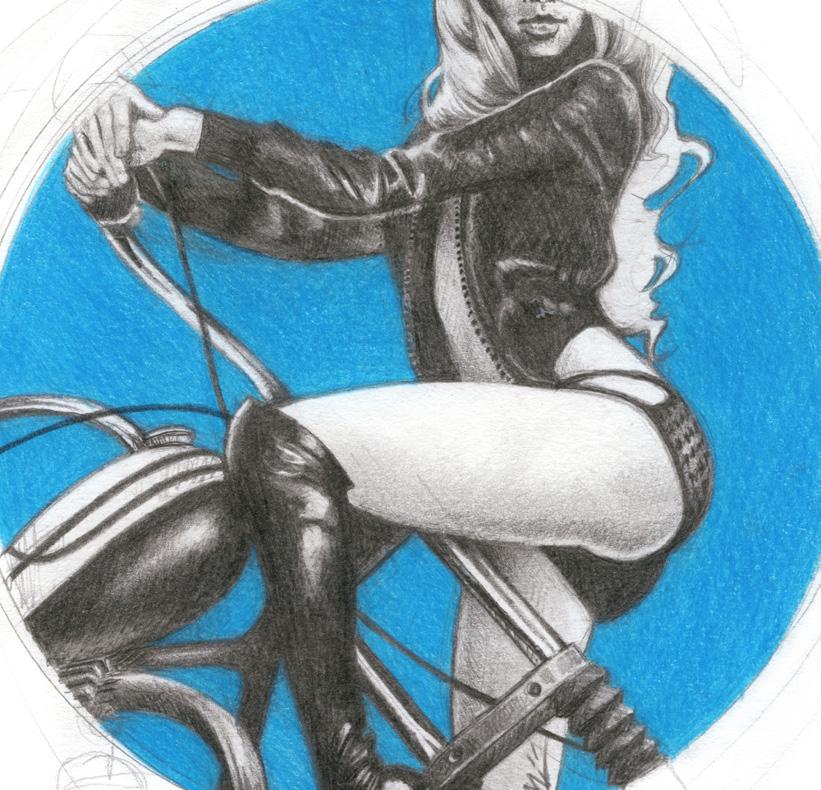
‘Loose Lips lid’ Practising using acrylic on one of my own helmets
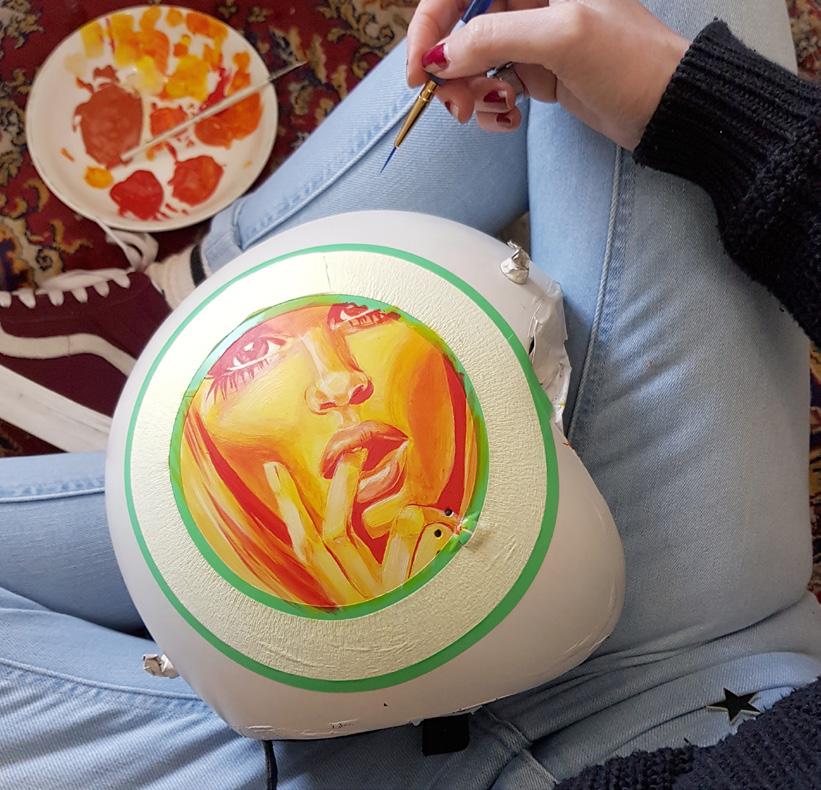
‘Thigh High’ Again, found it, couldn’t resist
‘Candy Bubble’ Fell in love with this beauty in a Chemical Candy Customs helmet. Reflections and transparencies, I love ’em

‘Sketching’

A photo by Tom Bing of me sketching away
 Jonny Wilson >
Jonny Wilson >
find myself spending a lot of time working at a desk within Chris’s tattoo studio, Physical Graffiti in Cardiff. I still do a lot of work at home too, but it’s good to have that mix.’
Then there’s the band. ‘Yes! My best friend Rose Love and I are Zealous Doxy. Rose plays the banjo and we both sing. We had both been in much heavier bands and missed singing and playing, so we got together with no intention of ever performing. Within a couple of sessions we had some rad songs and decided to perform and have since recorded an EP, toured America with the Pine Hill Haints and Europe with X Ray Cat Trio. Next up is another recording.’
But it’s not all positive. When asked how difficult it is to earn a full-time living as an artist in the UK, Sami admits, ‘In my experience, nearly impossible.’
So the 32-year-old is adapting to survive (and avoid ever going back into the bra-selling business). ‘I’m looking forward to teaming up with Chris and FTH. We’re going to run the company together. We have so much planned, I can’t wait. With my personal artwork I plan on exhibiting and painting a lot more tanks,
(right) Photo by Dimitri Coste of me riding flat track thanks to a DTRA x VC London training day at Rye House

(below left) ‘TC Deathcat’ T-shirt design for TC when his super slick flathead was nominated for the People’s Champ award at Born Free. It was so rad to be a part of such a cool project. The UK scene really pulled together on this

helmets and murals and continue to work in colouring pencil, too.’
Some will assume motorcycles are the cause of so much pain and disruption in her recent life, but Sami clearly doesn’t see it like that.
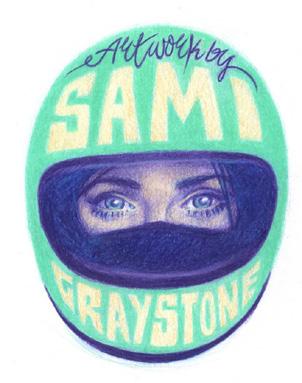
‘I’m at a very exciting stage of recovery where I can start to rebuild my life, start getting my strength back, if all goes well I will hopefully be racing dirt track soon, taking lots of road rides and living life to the full.
‘The bike scene has expanded so much since I started riding. There is a rad scene right now in the UK and the world, some really amazing people who I’m fortunate enough to call friends. It is an exciting time, there are more events happening, more opportunities and more good times to be had on two wheels. I’ve always tried my hardest to create a life which I buzz off, as a result of that, my own life inspires me, everything I see, feel, smell and hear is reflected in my artwork.
‘I was always a lone wolf and I can’t say that many people, other than my family, have influenced me. I just do my own little thing.’
Zed and me, my beloved Kawasaki Z750 built by Aaron McGraw. I fell in love with her ratty, chop/ bob style and mean stance. Zed is currently in recovery like me, we both took a massive hit, but thanks to Chris she and I will be back on the road soon, both slightly more wonky than before. It will be an emotional day
 Kevin McGonnell
Kevin McGonnell

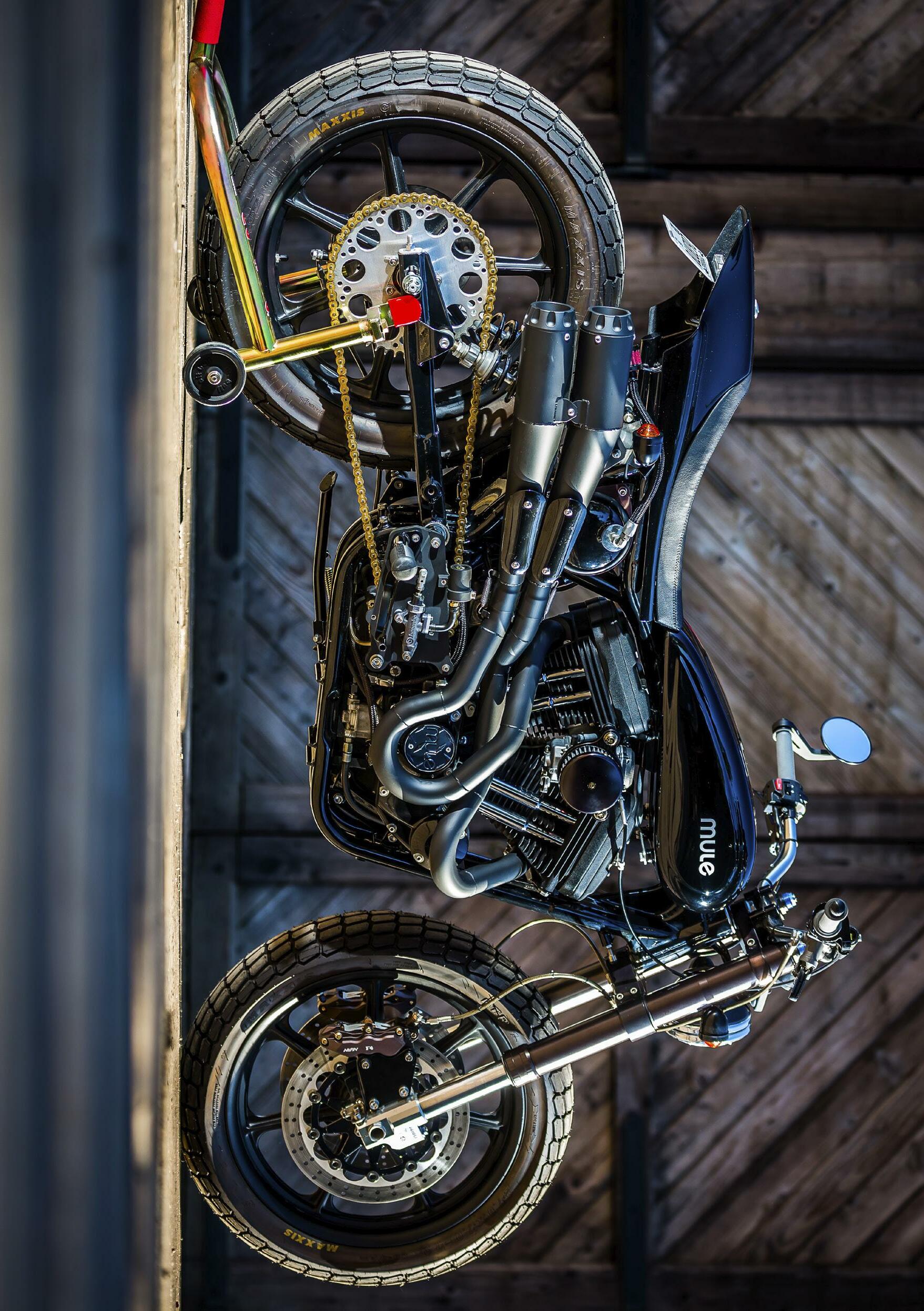

nine years one show
Chris Hornbecker
Year 1
That’s me, Thor, and the bike that started all of this. The photographer was initially just setting up a photo booth, but we liked the photos so much I decided to start a series of books
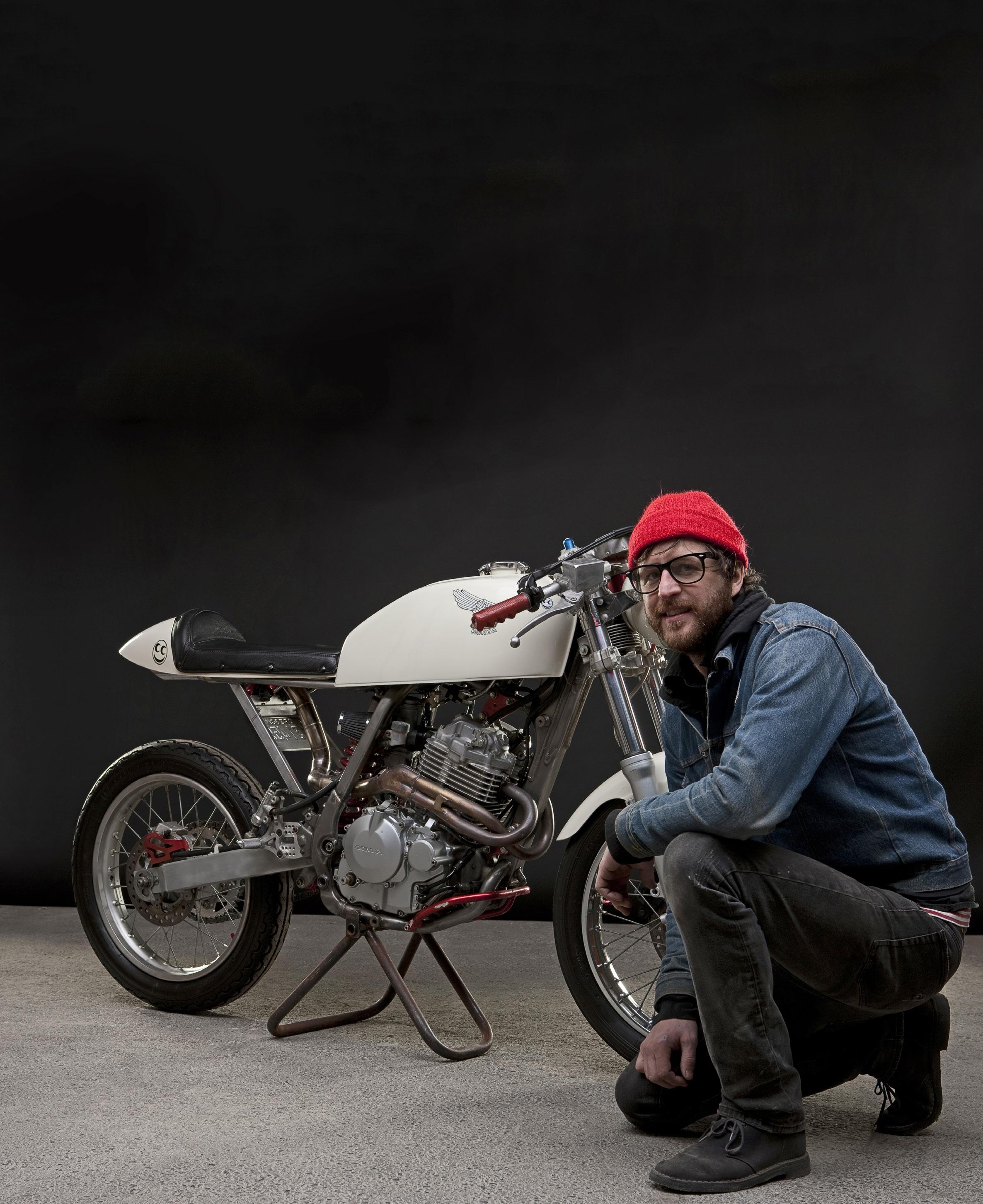
Words: JP Patrick Captions: Thor Drake
The best lil’ motorcycle show in America, maybe even the world. We celebrate nine years of The One Moto Show
79
Year 2
Ray Gordon shot this photo of Dirty Adam and I feel it embodies the spirit of motorcycling at the time.

A kind of screw you to the old guard and mashing up all types of motorcycles
IT WAS MANY years ago that I first became aware of Thor Drake and The1Show through Ray Gordon, a helluva photographer and an even better human being. I had come across Ray’s ‘Throttled’ photography (which was, and still is, the shit) and wanted to feature it on my site, selvedgeyard.com. So we did a little interview and from there our bromance blossomed. Little did I know that years later Ray would capture on film the day I married my beautiful bride.
Ray didn’t have to twist my arm to get me out to his hometown of Portland from the East Coast. I’d spent time in the Pacific North West over the years and have always felt akin to the independent, creative, spirited types that dwell there. And the weed in them parts doesn’t exactly suck either – ask the Blazers1
I like to get on the scene early for the load-in, to discreetly feel out the bikes, vibes, and take a few pics.
I was struck by the diversity of the bikes and their builders, and the unity of spirit among everyone who was there. Everyone came (from around the world) to have a good time, and no one had that ‘Fuck your bike sucks, man’ self-righteousness that can sometimes spoil these things. No judgement, everyone supported one another’s thing. No sneers, it was all smiles and beers.
That day I met so many cool people from all walks of life, and there wasn’t a shitty one in the bunch. I had never felt so at home and welcomed any other time that I can remember. There was such a beautiful mix of bikes and folks, it felt like the Shel Silverstein 2 of bike shows. We were all freakin’ at the freaker’s ball, and we loved it.
A bunch of us that just met that day shut down The One Moto Show that first night. A rag-tag group that formed a brotherhood that remains to this day.
Year 3
This was Michael Czysz’s grandfather’s Bultaco, shot by Jon Humphries. Michael had it built into his wall at his headquarters where he designed the first ever electric superbike. He passed away of the big C a couple years ago. A big hattip to him and his vision. RIP
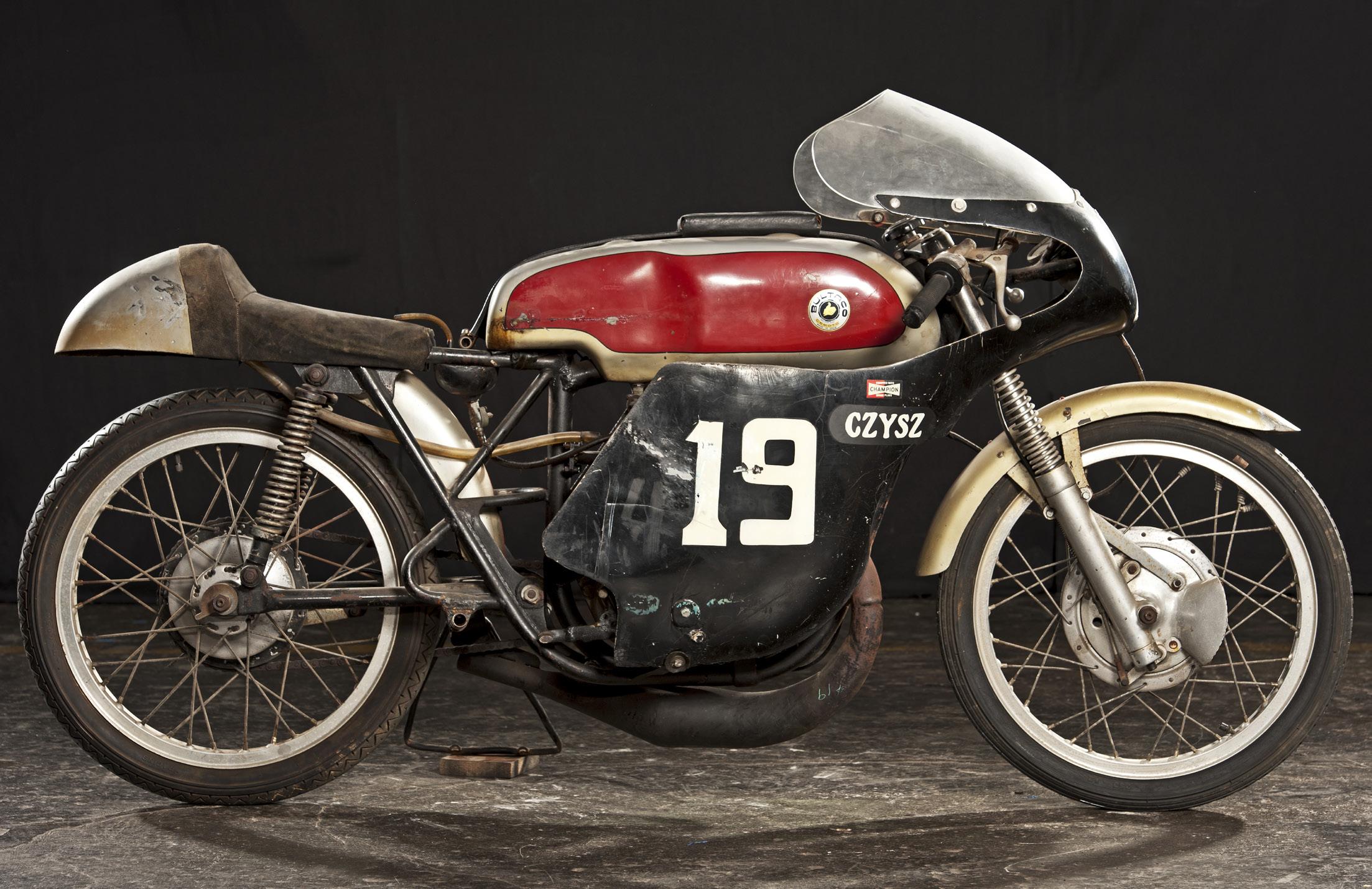

Year 4
Michael Woolaway shot by Scott Toepfer. Mike, aka Woolie of Deus Ex Machina and Woolie’s Workshop fame, had just got off the plane and Scott was shooting all the portraits in Polaroid. He messed this one up but I still really like it. Woolie is an elusive character and this photo is proof of that
>>>
Appendix 1.
The local NBA team, the Portland Trail Blazers, with a recent history of drug impropriety. 2. American author and singer-songwriter who penned ‘Freakin’ at the Freaker’s Ball’.

Year 5
Skip Aksland delivered his legendary Champion-framed Yamaha TZ750 to the show himself in the worst snowstorm Portland has seen in a decade. It was also restored by his former mechanic. Priceless

>
Max Dworkin
We spilled out onto the street and with all the people gone we could see it was blasted with beer cans and cigarette butts. We laughed at the mess. Thor joked about us swinging by in the morning to help clean up if we had nothing better to do. I wasn’t going to let my new buddy Thor down. The next morning he rolled up the gate, saw me standing there, and we did just that.
I left The One Moto Show bummed that it was over, but I would fly out from the East Coast to do it again and again, knowing it was something special, and to see Thor, Tori, Ray and their crew. I look forward to it every year.
Venues have changed, the scene has grown, bigtimey corporate sponsors have jumped on board. The One Show still remains true to what it started out as: a balls-out, everybody’s welcome, come as you are celebration of artistry, anarchy, alchemy and authenticity under the guise of the world’s best lil’ motorcycle show.
Year 7
This is Gary Nixon’s original bike, shot by a good friend, Jeff Hehlen. It’s actually owned by a fella who has a bagel shop not far from See See. The things that come out of the woodwork for The One Moto Show!

Year 6
When Dustin Aksland (son of Skip) shot Sosa Metalworks’ amazing hand-crafted bike I had never heard of Sosa. I’m not sure if anyone had. They took the motorcycle industry by firestorm and they are the nicest guys you’ll ever meet

Year 8
Another amazing relic that lives right here in Oregon is this survivor Indian boardtracker that was photographed by Gregor Helenda.
The bike is all original
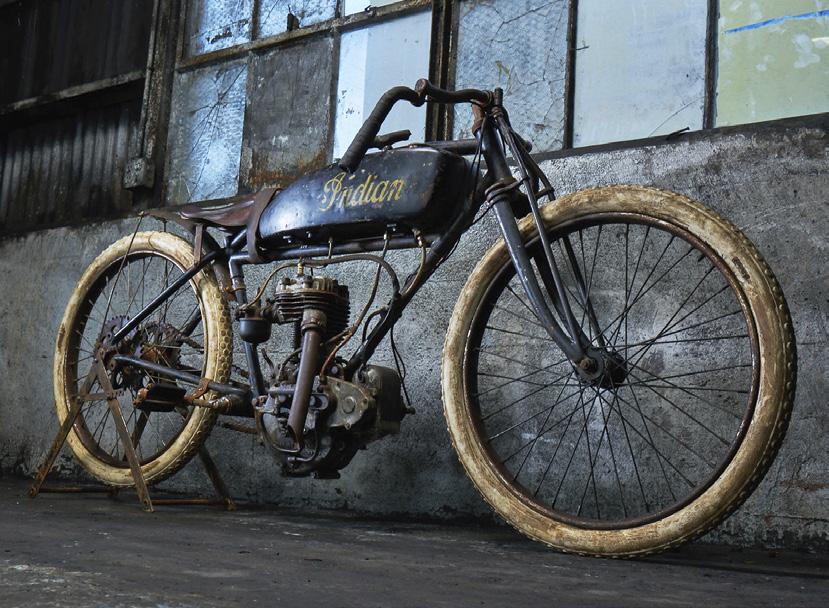
22


AKIRA
It’s over 30 years since Akira, the landmark dystopian epic, was released into the wild. Dave Bevan comes fresh to the Japanese manga classic
TO TELL YOU the truth, Akira in its entirety had, until a few weeks ago, completely escaped my cinematic radar, which is mainly chock full of terrible ’60s biker B-movies mainly. Being 11 years shy of its 15 certificate when it was initially released in 1988, I guess that’s understandable, although I distinctly remember it being one of those defining cultural calling cards from my school days, which separated the switched-on kids from the rest of the plebs, by virtue of having been exposed to its ultracool animated ultra-violence and colourful language, or not, as the case may be.
Until recently I was firmly in the pleb camp. 30 years is pretty late to the party admittedly, and while I’m here confessing my anime ignorance, let me also throw out there that I was, initially at least, happy to maintain my obliviousness to the world of Japanese cult cartoons. I assumed that they weren’t my bag and my heart didn’t particularly skip any beats when Sideburn asked me to watch and review Akira. Who wants to give two hours of their lives (non-refundable) to a bunch of blinky-eyed, squeaky-voiced cartoon characters shouting at one another in poorly dubbed English and blowing each other up repeatedly? It didn’t take long to realise my error.
The opening sequence takes you careening down a neon-lit highway in Neo Toyko (Tokyo set in the then implausibly futuristic 2019), before panning sharply
out to show the sprawling, bustling metropolis, only for the whole electric mess to suddenly fall victim to an A-bomb mushroom cloud and the nuclear fallout that follows. It’s mesmerising.
The plot, based on Katsuhiro Otomo’s original manga, is dense and incredibly involved, and far too detailed to get into here, save to say it centres around the post-apocalyptic, crime-riddled alleys and highways of Neo Tokyo and a couple of local ne’er-do-well bōsōzoku biker gangs: The Capsules (complete with excellently garish pill back-patches), led by one of the film’s central (anti-) heroes Shōtarō Kaneda, and their rivals The Clowns, who wage two-wheeled war on each other in the face of city-wide crime waves, rising civil unrest and protests, governmental corruption, terrorist resistance groups and a really weird storyline involving creepy supernatural psychic espers, military conspiracy theories and deeply buried ancient gods being re-awoken from their archaic, chemical slumber.
As involved and engaging as the plot is (and it really is, it kept this self-confessed anti-manga ingrate on the edge of his seat throughout) it plays second fiddle to the visual spectacle that is the incredible animation.
In order to fully realise Otomo’s 2000-page epic, Akira reportedly cost 1.1bn Japanese Yen to make (£7.25m/$9.75m) setting out its stall to break the usual mould of limited-budget production values and cut-cornered animation that had been commonplace
87 >
Opening illustration: Raid71
(above) Apocalypse Now, Neo Tokyo. (above right) The Capsules running their rivals, The Clowns, outta town. The night bike chase scenes are extraordinary. (facing page) Military coups, bent politicians, evil giant melting robot teddybears... just another day in Neo Tokyo. (below) Kaneda's bike (inspired in part by Syd Mead's Tron bikes) is a classic of anime design






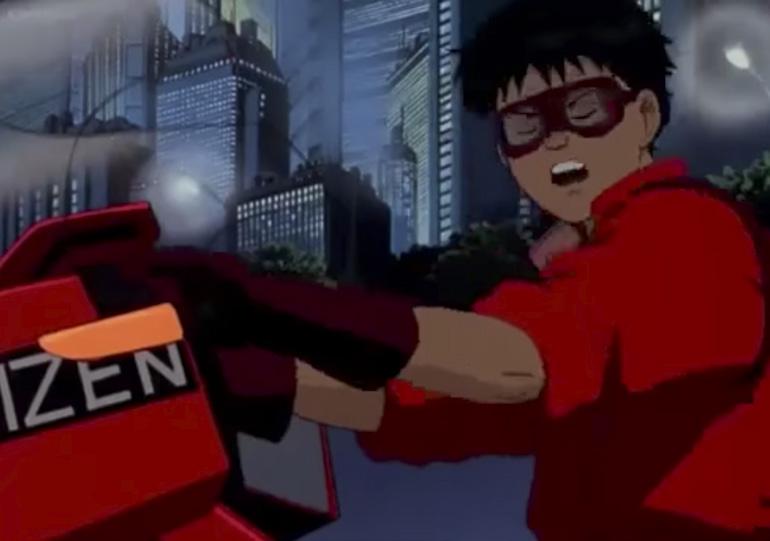



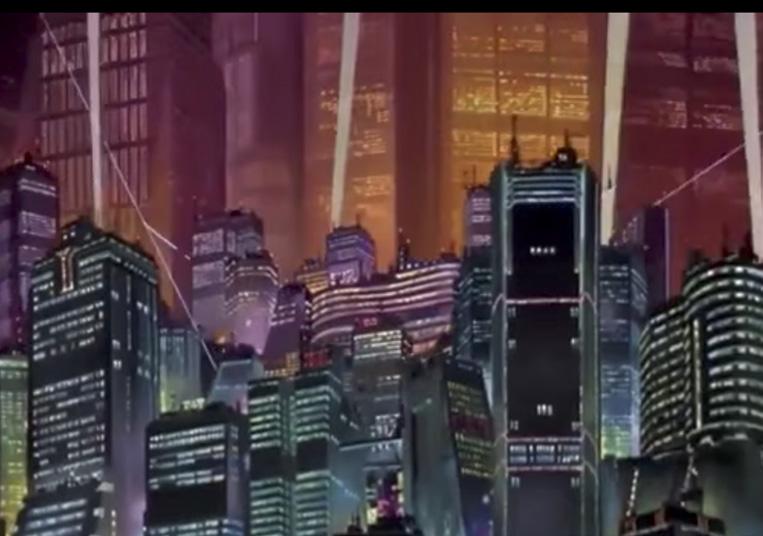



among other anime productions up until then. A huge cast of highly skilled artists and animators drew and coloured over 160,000 animation cells to ensure fluid motion throughout the action and fledgling computer-generated imagery gives an incredible sense of movement, light, shadow and depth, coming off as both classic film noir-esque and genuinely futuristic in the same breath. Throughout, I was reminded of Mitsuo Yanagimachi’s 1976 black and white bōsōzoku documentary Godspeed You! Black Emperor (see SB30) in just how important the use of light and dark is to the ambience of both films, in particular the bikers’ trailing head/taillight beams and the neon/ambient city lights they race through. I’ve yet to see luminosity depicted quite as deftly in any other animation as it is throughout Akira.
Mead (by Otomo’s own admission), albeit skinnier and more streetwise, whereas the more thuggish Clown bikes are a futuristic head-on collision of classic ’60s B-movie ape-hangered brawlers and wild ’80s bōsōzoku chariots. The animated fight/chase scenes throughout Neo Toyko’s neon-lit tunnels, with their potent mix of high-speed/slow-mo action and brutal thrills and spills delighted the outlaw bike nerd in me no end and are more than worth the price of admission on their own.
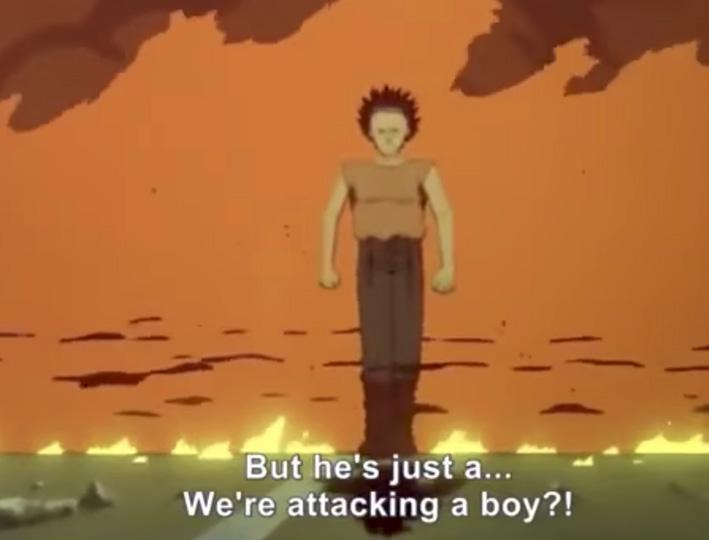
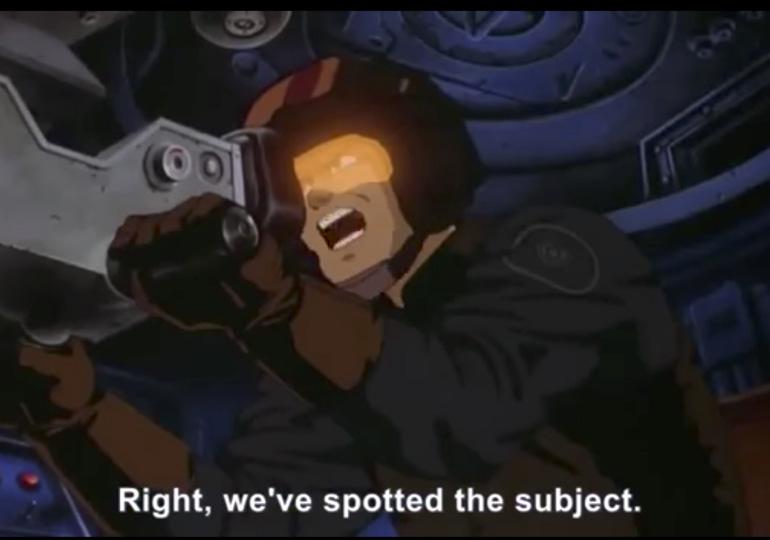



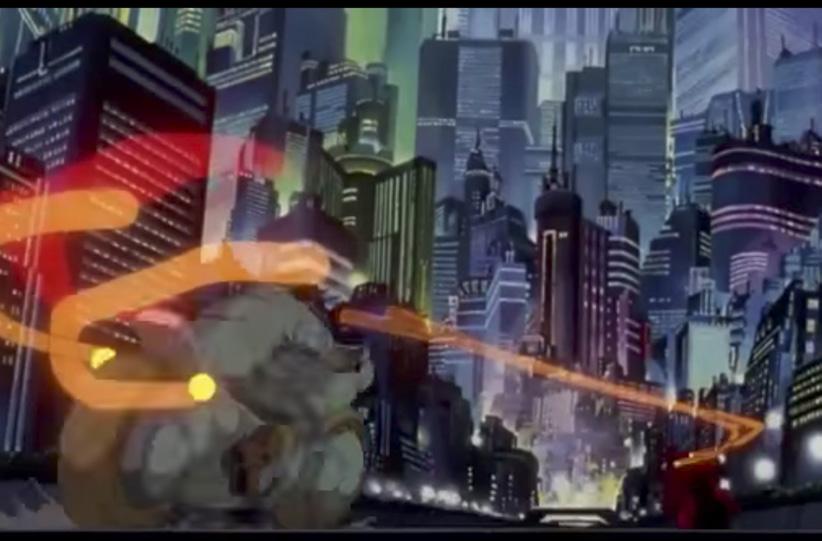
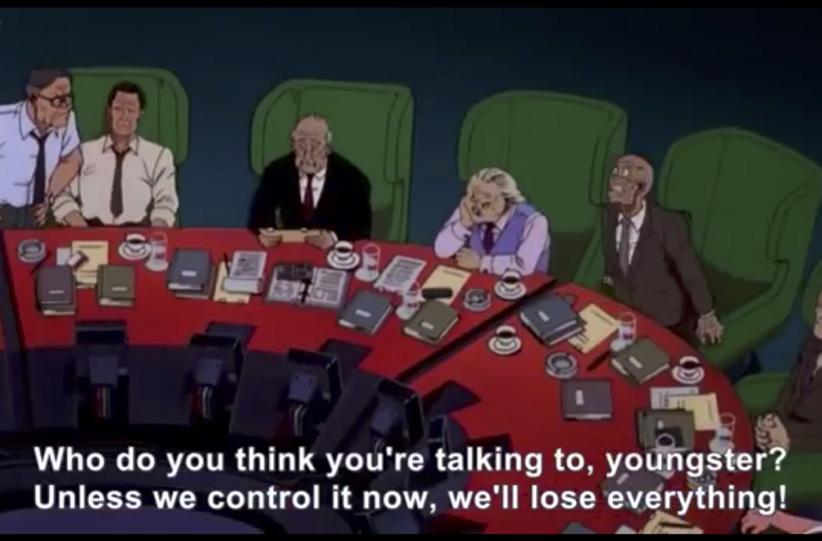


As is the beautiful and atmospheric soundtrack, composed and scored by Japanese polymath Shoji Yamashiro (real name Tsutomu Ōhashi) and his musical collective Geinoh Yamashirogumi, which, as with the rest of the film, proved a revelation to me, perhaps because I was somewhat cynically expecting a high-octane synth stab-fest. What I found instead was a subtle blend of repetitive, raga-like ethnic drums and drones, interjected with periods of chanting and ranting, which builds to such levels of dynamic tension throughout the film it had me rushing out to buy the recent 30th anniversary edition of the soundtrack.
The Capsules’ and Clowns’ rides are a classic mishmash of desperate influences and design and make perfect foils to their human counterparts. Kaneda, Tetsuo and the other Capsules’ bikes owe more than a nod to the futuristic rides in Tron, designed by Syd >
(right) Don't get Tetsuo angry... you wouldn't like Tetsuo when he's angry. (below right) Akira, the olde god is awakened. (bottom right) wheelieing towards the holeshot








The action builds continuously throughout the movie until the last 40 minutes or so, that deliver one bombastic, screaming, exploding crescendo after another, to the point it’s all a bit overwhelming. It’s interesting to note that Otomo struggled to finish his sprawling epic and sought the advice of quasimythical Chilean director/poet/tarot-head Alejandro Jodorowsky to assist with wrapping things up, which makes sense as Akira certainly bears something of the psychedelic grotesque grandeur of Jodorowsky’s Holy Mountain or El Topo.

I’m not entirely sure the ending is a success in terms of succinctness, mainly because I’m not entirely sure what actually happens, as I got lost in the dense action. It is a moot point by then however, because to feel somewhat dazed and confused by the post-apocalyptic beating Akira serves up is the only reasonable conclusion this epic needs.

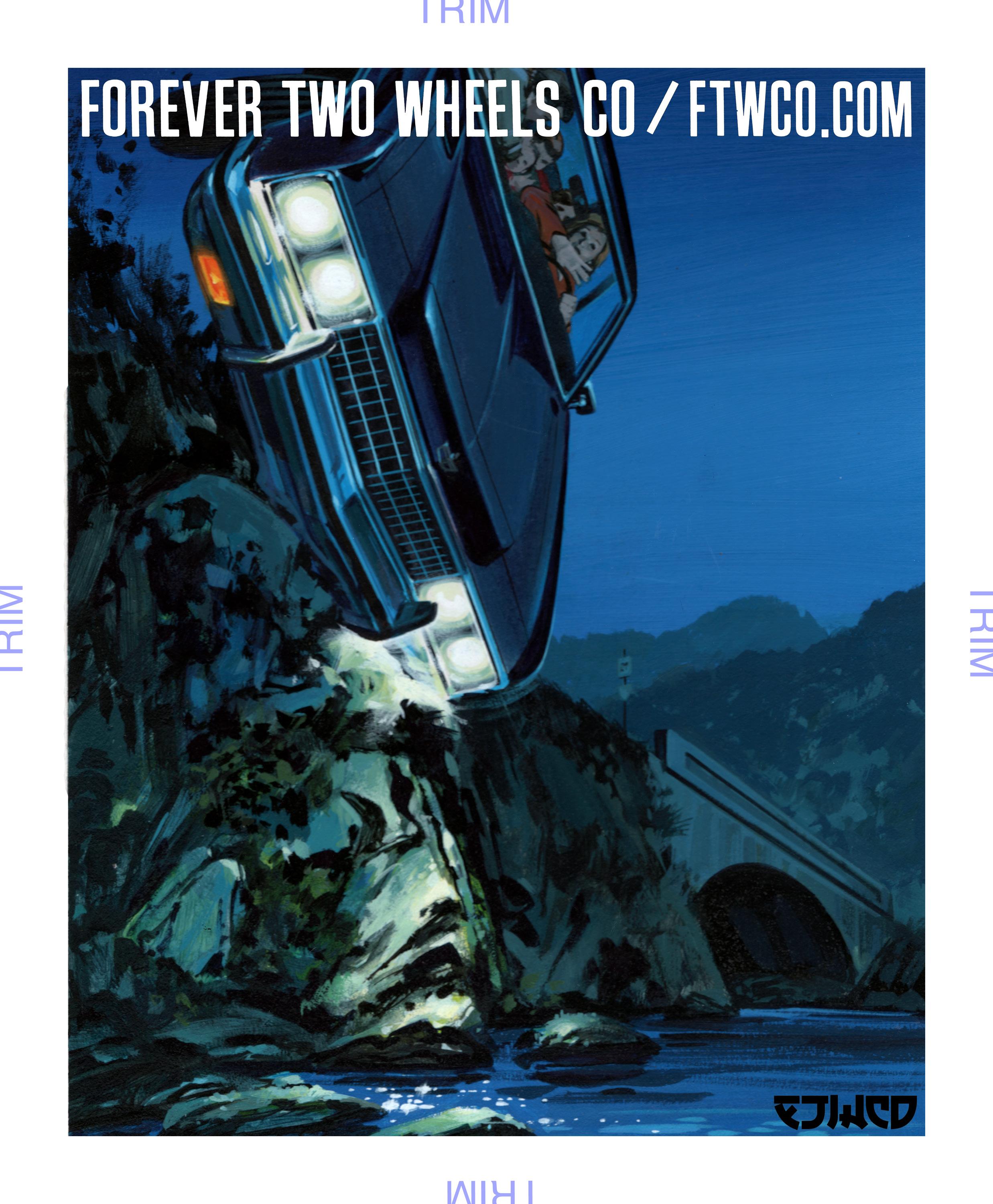
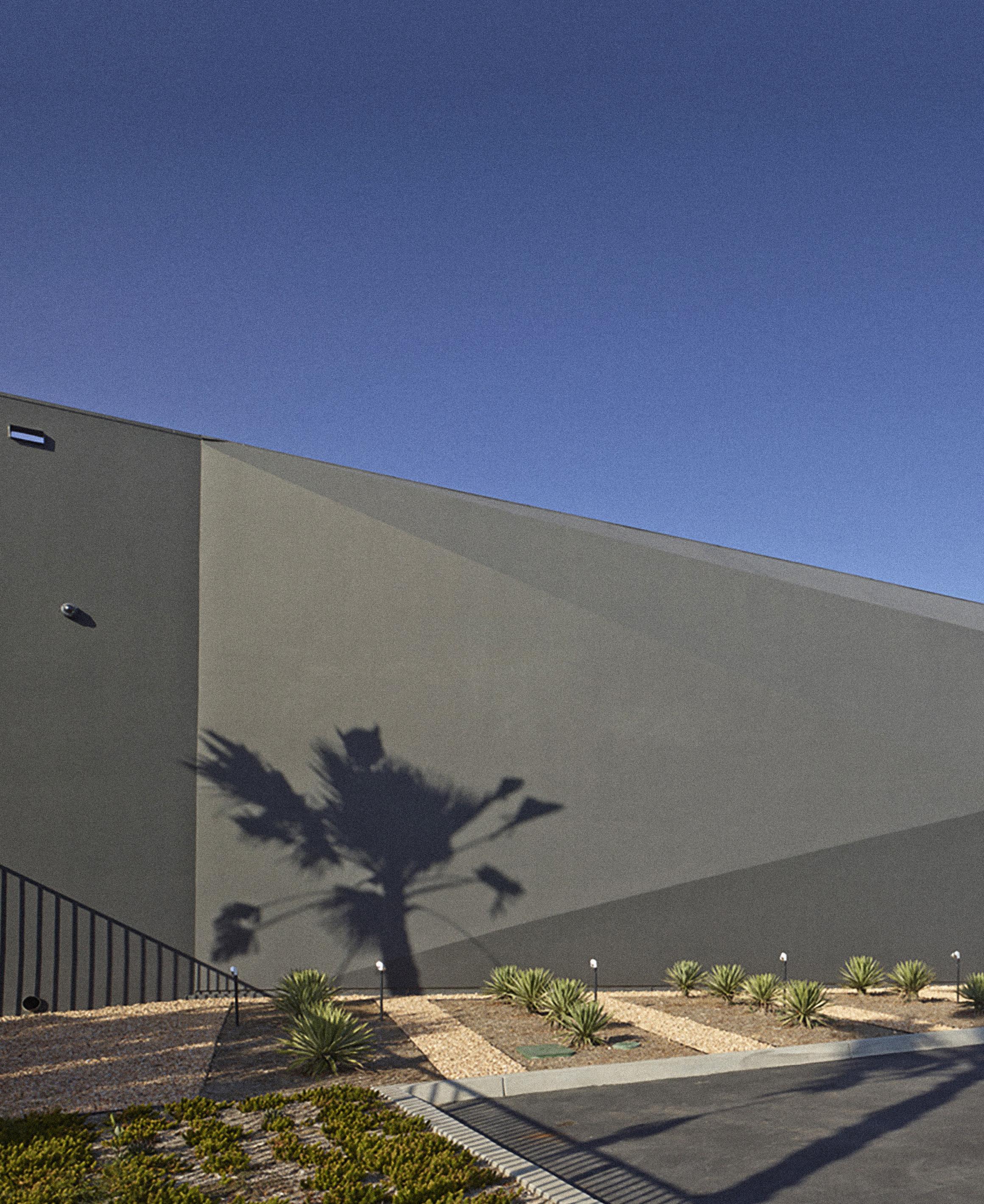
brandextension
Home is where the heart is.Welcome to Fox Head Inc HQ

> 93
Words: Gary Inman
Photos: Clive Wilkinson
’VE WORKED IN some grim dumps. For a year or so I sat at a computer-aided design workstation drawing components for the heavy machinery that agitated human excrement in British sewage works. The site visits were not relished, but if you ever need a scum skimmer designing…
Not only that, I had a gorgeous Italian Lambretta GP200, that I’d just restored, stolen from outside that office. It wasn’t a high point of my life. I’ve been employed in places where the management tried to inject their soulless sinkhole with some Silicon Valley glamour by installing table football and painting a wall orange. Nice try, bean counters.
Then there’s the global mothership of Fox Head Inc, an exercise in pure California turned up to 11. It’s a fantasy dropped into the sprawling identikit industrial landscape of Irvine, Orange County, the heart of the SoCal motorcycle industry the company helped create.
The first thing you see as you roll into the car park is the red entrance, a sculptural, facetted projection that was conceptualised by head of design for Fox, David Durham, to resemble the nose guard of a Fox moto helmet. In my mind it also doubles up as a yonic opening in the graphite grey, windowless expanse of exterior wall (excuse me, I’ve been away from home for a few days). Walk through it and there’s a spacious and sparse entrance lobby, with a Fox flagship-style store behind the 20-metre-long receptionist’s
desk. You have to detour to enter the retail area, there’s certainly no ‘exit through the gift shop’ vibe.
‘I like your bike,’ breezes the observant receptionist. I smile, in a very British manner, not used to young women taking any notice of me and my luke warm breeze of helmet hair. People are happy to be here, or good at pretending.
Through a church windowshaped, zebra-striped corridor is ‘Main Street’. It’s the size, and has the feel, of a small shopping mall. Meeting rooms, which look exactly like airport shops, surround an atrium. One is for moto, another for ladies ranges, another for mountain bike clothing and
products. Meetings are going on in them as I walk past.
Main Street runs down the centre of the building. It splits two humanoid-heavy work areas. People work in cubicles (you can’t avoid the cubicle even in Fox Fantasy world). In the workfloor on the right, between desks, there are dozens of hanging racks on castors holding hundreds of items of clothing – new designs, samples, failed ideas, future best sellers. There are helmets, boots and gloves too. People work in what I take to be a contented hush.

On the other side of Main Street there is a two-storey admin-heavy area of accounts and sales and a

boardroom glazed with scarlet Perspex. It’s where an Italian archvillain would have made plans in a 1965 movie. There are ‘break out’ areas with astroturf and expensive chairs in primary colours. There’s a slight feeling of Teletubbyland. Moto-X Lab, the special branch that collaborated with See See to create their range (and Sideburn to produce the special One Motorcycle Show edition of the

magazine) is the only department that appears to be self-contained. It’s where top-secret collabs gestate. If outsiders glimpse the Lab’s mood boards or sample rails they must stare directly into the face of the on-site Medusa until their eyeballs turn to marble. It seems harsh, but it works.
At the end of Main Street is a large, airy, communal kitchen and dining area that wouldn’t be out of
place on a Saturday morning TV cooking show. Opposite is a flight of tall stairs that forms seating for presentations or corporate film premieres. Outside is a garden area, with palm trees and a minimotocross track for the company fleet of Honda CRF100s. There’s a pattern of paving areas and astroturf. Because the patio is so large, it’s not until it’s pointed out that I see the pavers and grass spell out the words DREAM ON, a corporate maxim and successful ad slogan for Fox.
The HQ was opened in early 2013, three and a half years before I visited, but it still feels brand new. There were no obvious chipped corners or broken innovations. No one has felt so disenfranchised that they’ve scratched graffiti into the walls with a flick knife (like they had in the office where I was last a full-time employee, just weeks after it was refurbed).
The building’s designers, Clive Wilkinson Architects, say it was ‘designed to challenge preconceptions about how office space works’. I don’t honestly believe you can do that and still get work done. Sure, you can fit fireman’s poles to get between floors if you like, and install a nice place to eat a packed lunch, but really, offices are still spreadsheets, getting people to pay their bills and designing stuff to sell. Get those fundamentals wrong and your business is going to the big break-out area in the sky. Instead, the Fox HQ seems to foster a pride in the brand. If you go to work in a place like this you’re going to be infected with a hearty dose of can-do attitude. Bad management can squeeze that out of a workforce quicker than a Kodiak bear with a tube of Colgate, but combine good management and an inspiring office and the combination is potent.
More than anything, Fox Head HQ is selling a lifestyle and I gobbled it up like a consumerist gannet with eyes bigger than its belly. Burp!
>>
‘IT’S WHERE AN ITALIAN ARCHVILLAIN WOULD HAVE MADE PLANS IN A 1965 MOVIE’




 (top) More than three years in and everything still feels crisp and fresh, none of your bile-fuelled grudge-graffiti here. (above) Main Street, Fox Town, where meeting rooms double up as dummy shops; (below) communal canteen and hang-out spot; (right) nose guard reception area
(top) More than three years in and everything still feels crisp and fresh, none of your bile-fuelled grudge-graffiti here. (above) Main Street, Fox Town, where meeting rooms double up as dummy shops; (below) communal canteen and hang-out spot; (right) nose guard reception area


The Pink ’n’ Purple Peak Eater


Still pining for the loss of Pikes Peak’s last unpaved sections, our man Travis goes in search of a good ol’ dirty hill climb Words: Travis Newbold Photos: Jon Wallace/Brapp Snapps
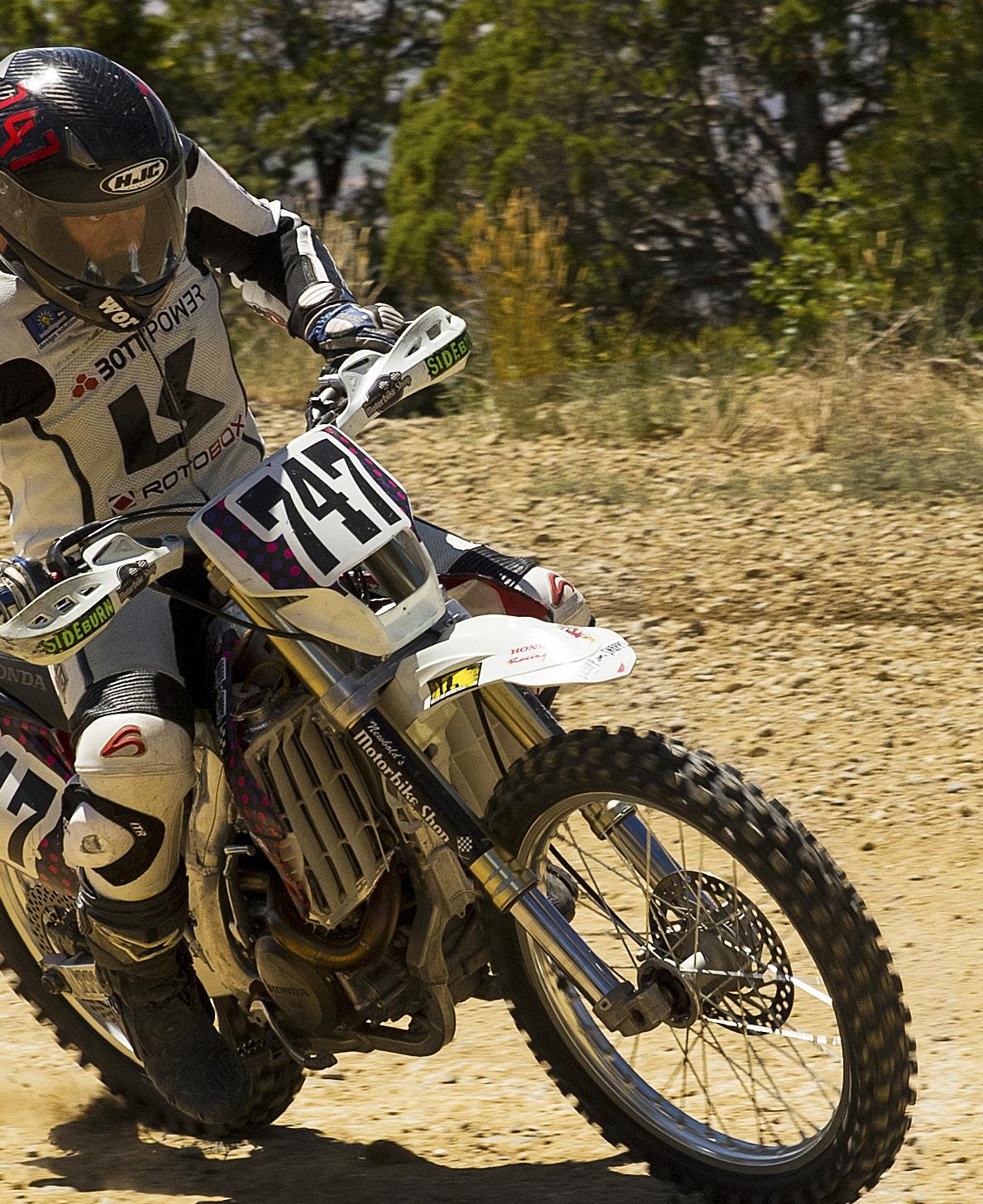
> 99
You know how Hendrix could play a guitar with his teeth just to show off? Travis does the same with rear tyres (below) When two runs become one. Our hero made it hard for himself, when he failed to start the CRF450 for his first run (right) Snaking through the pines and boulders, burning a few litres of dinosaur juice and spitting a handful of rocks from one place to another in the hope of a good time. Don’t deny Travis this simple pleasure
IFEEL DEPRIVED of my liberties: not the gun laws, freedom of speech, or some ancestor’s holy spirit, but precious rights that the moto-gods granted me; the freedom of racing a motorcycle on a closed public road, not a man-made racetrack, an actual public road with real-life unmovable kerbs, trees and mailboxes. You see, here in the good ol’ US of A, we have no Ulster, no Isle of Man, nor any other real road race circuits. We have the Pikes Peak hill climb, but since it’s now completely paved over – a forced action of the ominous Sierra Club – it has become another victim of the soul-snatching corporate marketing train wreck we call progress.
But, in the middle of the Rocky Mountains, there is still one place where a working-man motorcycle racer can throw a leg over a dirt bike and run competitive times with the high-dollar, open-wheeled, hill-climb race cars on a traffic-free closed road with enough exposure to make a base jumper blush. All of this is a glorious possibility because of the organic aspect of a sweet, loamy, loose, blue-grooved dirt road.
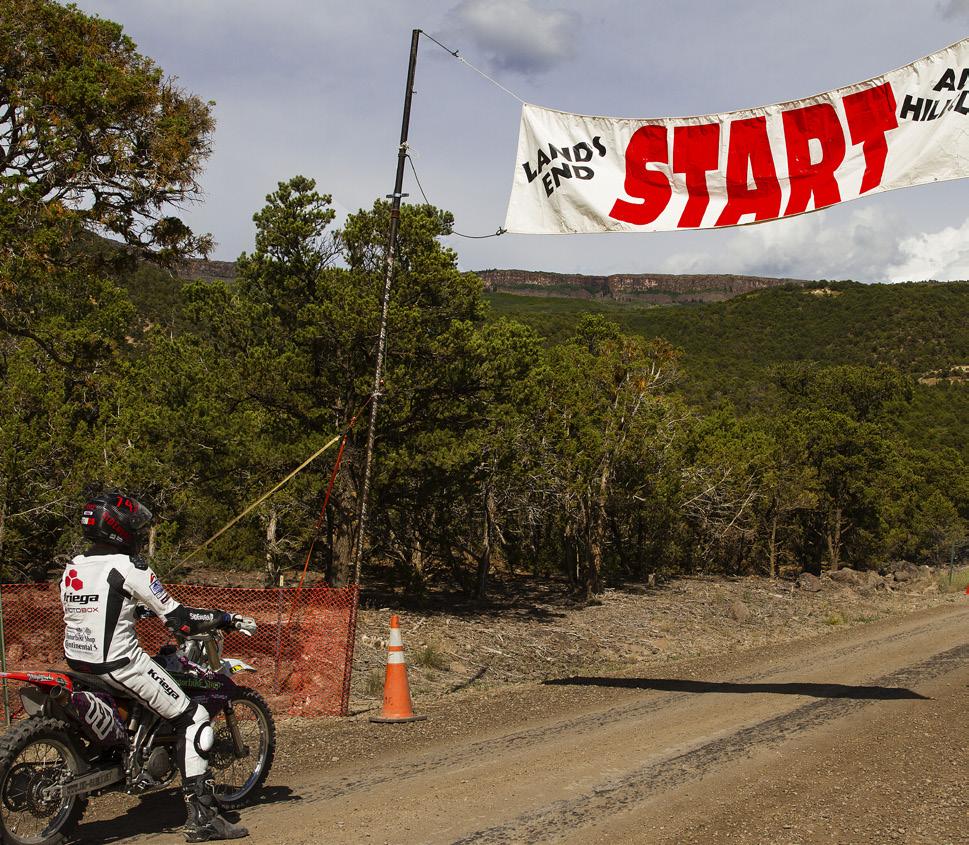
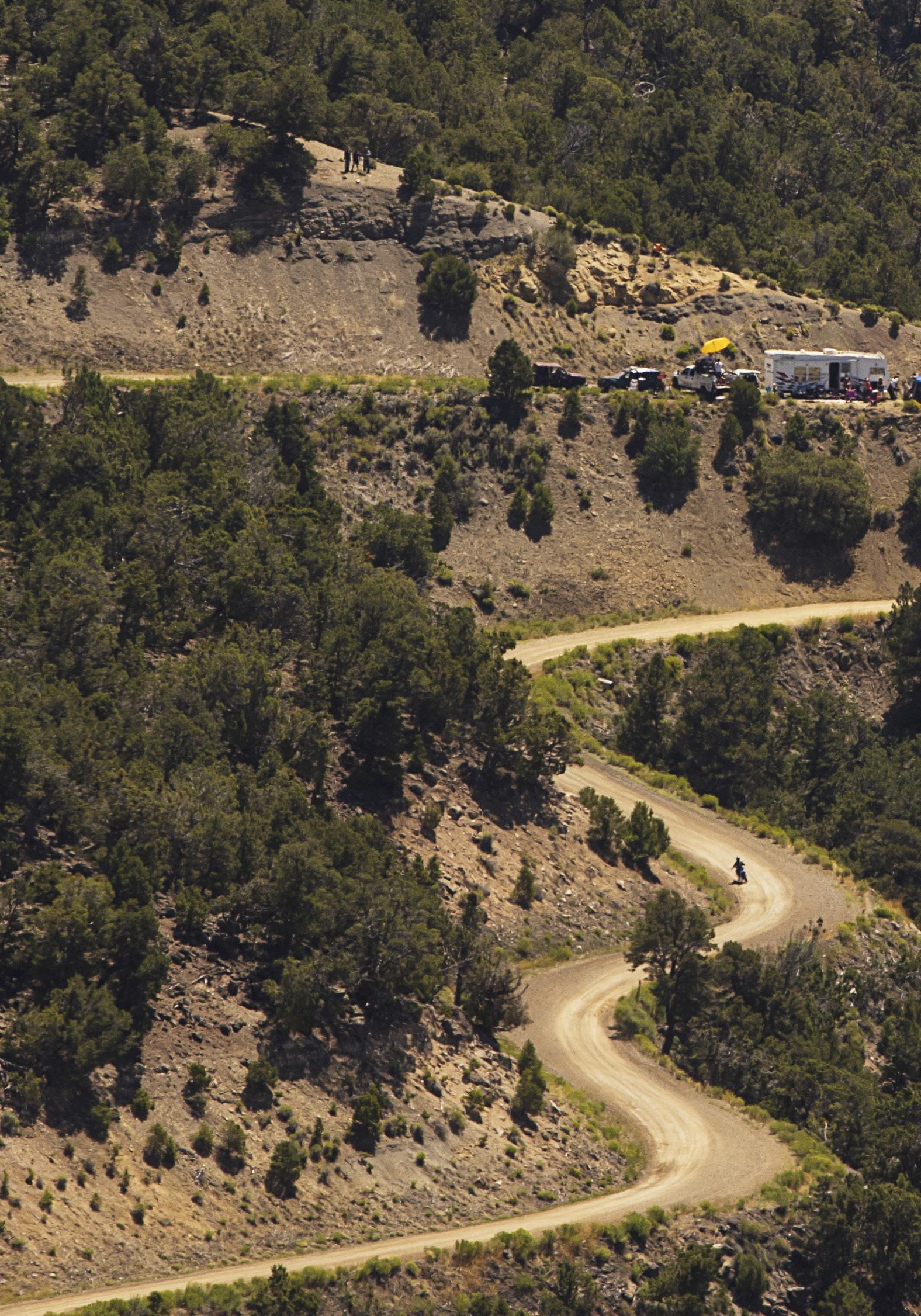
The race bikes are a motley mix of modern 450 MXers, all hopped-up or still sporting the tyre tits right off the showroom floor; some are old, put-out-to-pasture, 500cc two-stroke dirt bikes hanging onto one last high-compression Wiseco over-bore, ready to blow holes in engine cases like torpedoes through Pearl Harbor. My pink-to-purple, polka-dotted, mega mongrel, bony baloney pony Honda was built purposely to conquer Pikes Peak; it’s a Craigslist blown-up 2008 CRF450R engine in a freebie, junkyard 2005 CRF450X frame with every fleabag part a honky like me can scrounge from a dumpster. I did all the secret speed tuning that I know how and welded new aluminium motor mounts to the

and crankshaft were all on a level plane. For a good sliding bike, it all comes down to gyroscope effect.
I’m stoked with this bike. The first time I raced it was Pikes Peak International Hill Climb in 2012, and I won the 450 class, setting a new class record. Since that race, the dumpster-dive bike has spent a lot of time dropped down 5in and on 19in dirt-track shoes, sliding around in circles as good as I know how to ride her. It has also been known to cross-dress into some kinky spikes and laced wraps for ice racing. I recently built another set of suspension – only dropped 1in, with street-style valving – for AMA supermoto racing. Add knobby tyres and BAM! You get super sliding/riding. Yes sir, I’m stoked. This bike has pink and purple polka dots because it makes a certain part of me go pink-to-purple.
The hill climb scene in Colorado is deeply rooted. The Pikes Peak International Hill Climb may be the great big granddaddy of them all, but there have been some truly epic unheard of climbs up mountain roads all over Colorado for a long time. The final race of the hill climb season is the biggest at six miles long and is on a holy honking hairpin-turning road called Land’s End. Since Pikes Peak was paved over completely in 2012, all the old open-wheel dirt cars come here. I, having started
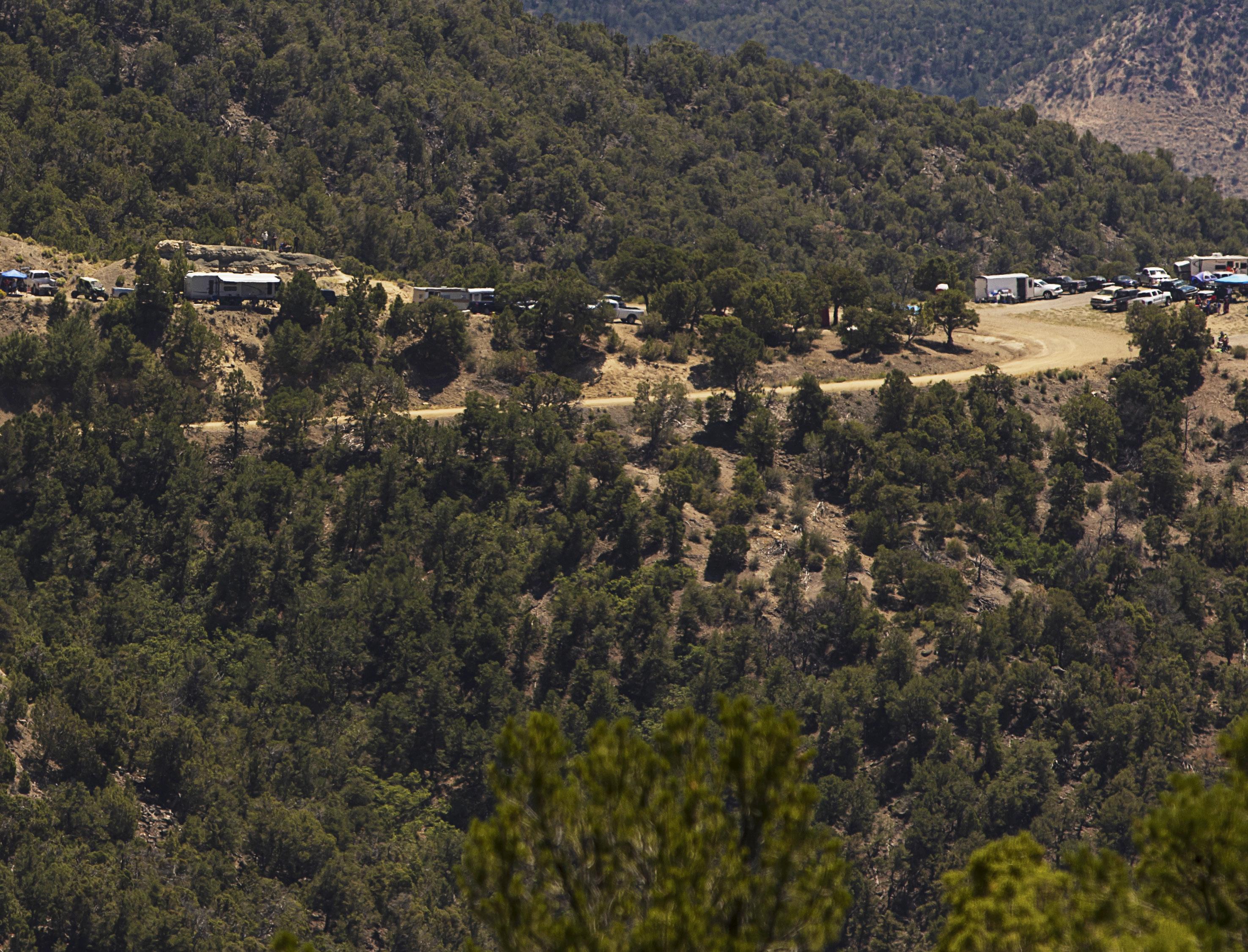
the ditch as a safe, fast line once again. Ah, DIRTBIKING!
The 2017 Land’s End Hill Climb was a competitive barnburner. The year before, I bested the record time of my protégé, Lord Mick, and he wanted it back. I had also stolen the other 2016 Colorado Hill Climb Series course records from a young champion now using some of my trick suspension. To make things even more interesting, add competitor Codie Vahsholtz, a third-generation Pikes Peak champion with whom I have done much battle before. This built-for-speed jockey is a few sacks of taters lighter than me and I always remind him so. Even as a rookie to Land’s End, he learned the course quickly and his practice runs were within seconds of my best times. I knew he would keep on improving exponentially.
In practice, I bested my previous year’s record time by a couple of seconds, which led to a Saturday night celebration: minibikes on a moonlit course, pre-running with no headlights, dead-engine downhill racing, then a campfire pot of the best damn homemade soup. With good friends Lord Mick, Ricky Racer of the West and Jon Wallace, the world-renowned race photographer, we decimated our whiskey bottle and ice chests of beer.
I woke up Sunday morning with the sun blazing into my van as I peeled my aching head from my crusty truckstop pillow. It was the damn whiskey. No, the poison
>
Built from discarded parts, assembled by a mad man, juiced with a 12v battery and relentlessly tweaked for improvement, Newbold is our Frankenstein’s monster (right) Buena vista with a hint of opposite lock. Brapp Snapps delivers landscape photography Sideburn style
potion Fireball (illegal in most civilised countries). Had it not been for my beloved percolating black-as-night coffee, the day may have been a total write-off. I sat next to my polka-dotted steed, nursing my swollen, grey mush back into my shrunken cranium. My bike would have to pull through for me on this glorious day of battle.
I was so confident in my pink-to-purple machine that I waited to warm it up right until all the other motorcycles were in staging. My smooth-operator confidence crashed right off the side of the mountain when the dirty old red-headed loaf of a Honda did not start first kick. Nor second, third or 28th. Nothing curdles a throbbing hangover like attempting to bump-start a wet turd while dressed in a cow skin. A futile attempt to drain the float bowl left me still kicking as the last motorcycle exhaust echoed off of the cliffs. So much for my first run.

Luckily, we get two race runs and the better of the two is tallied. ‘Hell, I’m good enough to win with only one run,’ I tried to tell myself in my best overinflated Sylvester Stallone ego.
Somehow, my gas jug had been invaded by the aqua gods of anti-combustion, so all I needed was some fresh, high-octane petrol. With the new fuel, my bike started easily, and with a bit of my own personal hydration, I was feeling better. Just as my confidence was re-boosted, word came through that hill climb ninja Codie Vahsholtz had dropped my best time by nearly ten seconds! What could I do but wolf down a few sardine sandwiches and spoon a few more grounds of coffee into the pot while I awaited our second run.
The afternoon sun was as hot and nasty as Woody Harrelson in a string bikini. I watched lizards scamper from boulder to boulder around my pit. I gave every corner and section of the six-mile course a run through my mushy head. I knew my strong sections, the sketchy sections and the sections I could find the speed to drop enough time to possibly finish first. This time I was more eager to have my bike warmed and ready to stage.
though. My tongue was hanging out and one eyelid was stuck open due to the lack of blinking. I crested one rise with caution as I had heard of an exposed rock flipping cars. I launched over the rock Roger De Coster style. ‘Ha! Silly cage racers,’ I thought, and then I saw one of the crashed cars right in my dead-ahead sights. Not a good

time for target fixation. I kept on the gas and kept on up the twisty gravel. Only a few more corners. Pushing hard for every split second, I came through the second-to-last corner a bit too hot but kept the back end lit, and as I crossed the finish line my chest burned as if I’d just run the entire course on foot while chain smoking a pack of filterless Pall Malls.
Cody, of course, managed to better his time, but somehow I managed to weasel my way and beat him by a mere second. And that is Colorado hill climb racing. Glory, freedom, whiskey and all.

Colorado hillclimbers always put on their best T-shirts and shorts for podium celebrations. Travis is on the top step, hovering between one hangover and the next. We don’t know how he does it
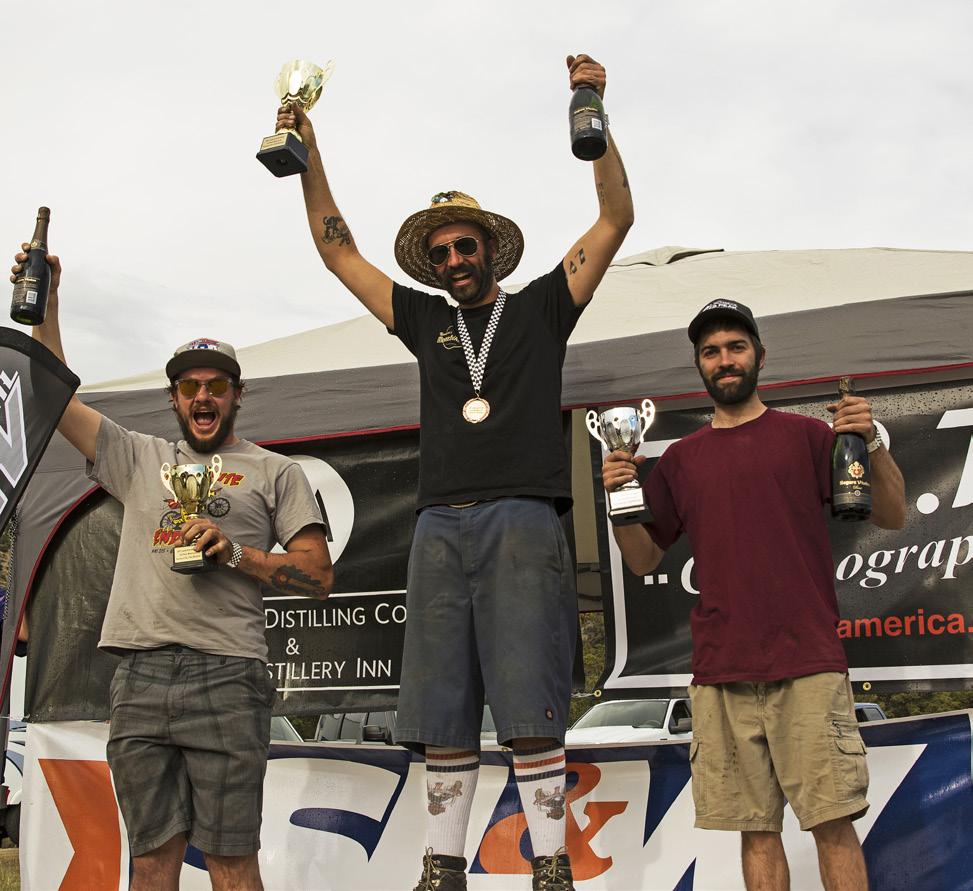
‘My tongue was hanging out and one eyelid was stuck open due to the lack of blinking’
>
Riding the course with a Coors in hand, pit bike grooving above Colorado’s clouds.
No wonder our pet moto poet craves his local, grassroots hillclimb scene so much


DEUS EX MACHINA, MILANO
In the five years since opening, Deus Milano has nurtured the Italian city’s growing motorcycle subculture. Alessandro Rossi explains how Photos: Courtesy of Deus Ex Machina
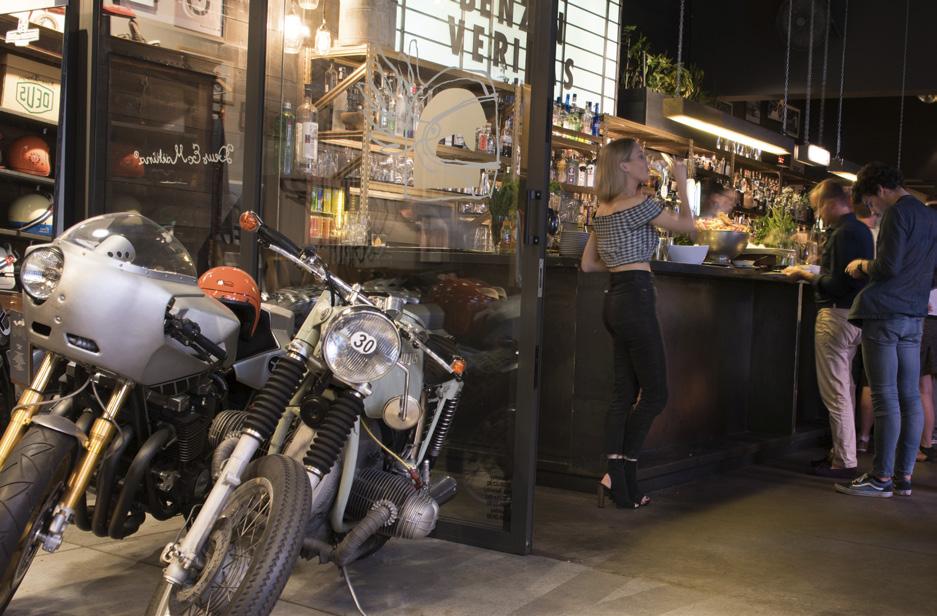
SHOP
When did Deus Milano open and is it a franchise?
Deus Milano opened in March 2013 with a Deus license for Italy, Spain and Switzerland and from that moment the activity has grown exponentially.
Was it difficult to convince Deus’s founders to trust you to open a flagship store?
On one hand, Dare Jennings and Carby Tuckwell are selective and protective with the Deus brand, on the other, Federico [Minoli], Filippo [Bassoli] and I have had a great feeling with them since the beginning and we have many points of contact: Federico was Ducati CEO for ten years with an Australian, Casey Stoner, as top rider and Carby and Filippo had the same car in their garage: a Caterham Seven.
Are you surprised there aren’t more flagship stores around the world?
As of today, the Deus brand comprises five flagship stores: Sydney, Milano, Bali, LA and Tokyo. We’re opening this year in Amsterdam and looking for partners to grow the Deus presence worldwide. We will grow with selective openings, a new flagship store needs a lot of thinking and work to become a new family member and the local partner is key to maintaining the Deus culture with local flavour.
Who are the founders of Deus Ex Machina Milano and what are their backgrounds?

There’s me. I always worked as CFO for large corporations. Federico Minoli, who’s a top manager with an entrepreneurial approach and long
Truth in petrol. The cafe’s cocktails put hair on your chest, ladies
experience with Ducati, Dainese, Bally, Escada, etc, and Filippo Bassoli, a great marketing and e-commerce expert. We were involved in Deus Milano before bringing key friends with complementary skills into the team: Luca Viglio (accountancy), Max Brun (motorcycles, Numero 1 founder with Carlo Talamo), Andrea Host (apparel and retail), Marco Donati (architect). The thing that binds the team is a passion for motorcycles.
A big part of the Deus Milano experience is the wonderful cafe, which is more of a restaurant. How does it fit the business plan?
Key to the success of Deus Milano has been the Deus Cafe partners Santiago Follonier and Giulio Baroni, who make the difference in the Milano food and drink experience. We started in a place with no traffic and no big ambition, but every month we’re

surprised at how the place is always crowded. We put into the Deus Cafe the same effort and attention to detail as when building a new motorcycle or a hand-made bicycle frame.
You hold events all the time, big and small. How and why are they important to Deus Milano’s success? Which do you enjoy the most?
I think events are the best way to fully experience Deus. Our events are inclusive and open to friends old and new who want to have fun. The most notable ones we’ve organised are the Deus Swank Rally, Eroica (classic bicycles) and SnowQuake. The most incredible is Slidetober in Bali, organised by Deus Indonesia. And the best is yet to come.
Is it difficult to balance having fun, spending on events and projects, and actually making money? Dare has invested hugely to build a great
(above) €24k gets you XJR13based Eau Rouge
brand and now we are improving the business. Building a profitable company is definitely easier than building a brand and for this reason I feel lucky to be working for Deus. Results will come and we will still have a lot of fun.
You and the other Italians have bought a stake of the parent company, can you tell us about that?
We have partnered with Dare, Carby, Barry [Davies] and a Deus Japan friend, joining forces to grow the business and keep investing to grow the brand.

Is there a company you think Deus can emulate? Quicksilver, for instance
I don’t think we have a comparable company or a model to follow. Deus is a new model that is starting to be studied in universities.
there a risk that
that
The motorcycle industry will evolve. Electric
things

freedom
than today, and Deus is a real experience
more than simply

is the future for Deus?

future
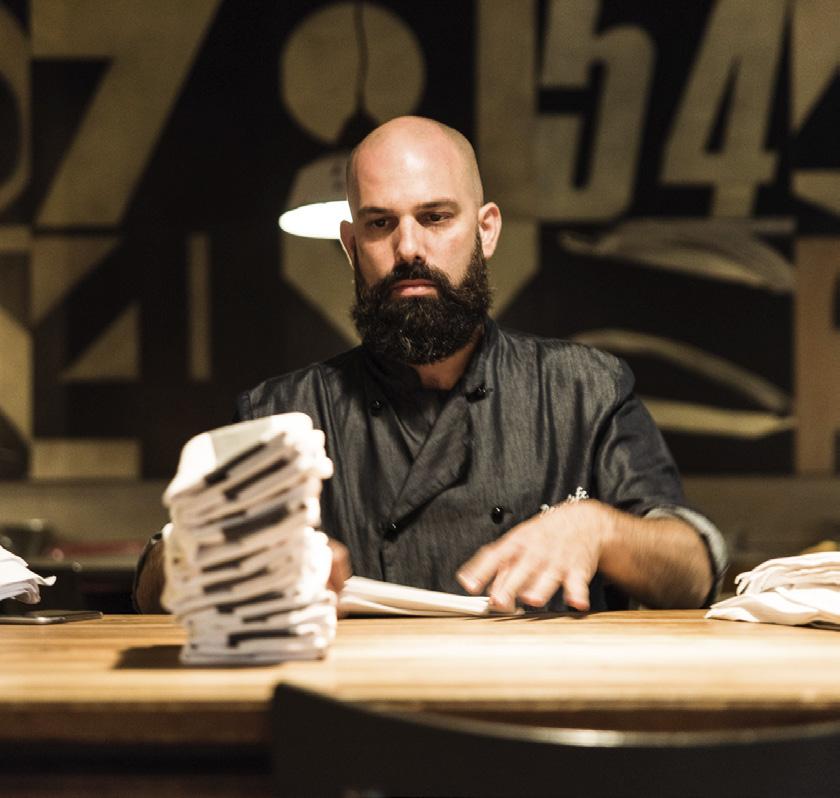
Is
motorcycling will go out of fashion and
will affect your business?
is coming, but these
are just the tools, the need for
will always be there, maybe more so
brand
a product company. What
The
is unpredictable, but I can swear it will be fun. 107 Bouts of napkin jenga can last for hours Even the shortest riders are well catered for at Deus Milano data DEUS EX MACHINA MILANO’S working week TOP 10 BRANDS IN ALPHABETICAL ORDER 1. Alpha Industries 2. Baracuta 3. Barbour 4. Blu Blanket 5. Deperlù 6. Deus Ex Machina 7. Edwin 8. Helvetica 9. Jape 10. New Balance ADDRESS VIA THAON DI REVEL 3, 20159 MILANO PHONE 02 8342 2610 EMAIL ITALY@DEUSCUSTOMS.COM WEB DEUSCUSTOMS.COM/FLAGSHIPS/ PORTAL-OF-POSSIBILITIES BEST SELLER Deus The Lips T-shirt €49 MOSTEXPENSIVE EauRouge (Yamaha1300) €24,000 LEASTEXPENSIVE DeusstickerFREE Sales and scouting for new partners 40% e-commerce strategy 20% Thinking about riding at Slidetober, SnowQuake, Eroica… 15% High-powered finance stuff 15% Instagram scrolling 10% ALE’S TIME BREAKDOWN
RaceWear
Trusted: the kit you just can’t do without
1 Bates ’70s racing jacket
I found a guy in London who imports vintage race leathers and bought this two-tone Bates jacket. Giulio Miglietta chain-stitched the numbers and nailed it, getting the same colour.
2 Nikon FG20
Before I got more involved with the racing I enjoyed taking photos at the events. Now I’m riding several classes the opportunities are rare these days, but I always bring it in case of injury or bike issues.

3 Leatherman
The usual universal tool for Harleys is a hammer, but with the need to ziptie a number board on you need a far more sophisticated range of tools.
4 Langlitz leather breeches
Another vintage find, perfectly broken in and loads of life still in them. Padding and zips in all the right places to make them actually useful.
5 Ruby Castel helmet
I had the genius idea of a trip to Paris on my girlfriend’s birthday. Without her. I went with two mates with the plan of buying the helmet and being back for dinner. 140mph in my old Porsche 944 the whole way, steering wheel obscured oil warning light that inevitably came on, resulting in blowing up the engine upon starting the return journey. Cue three alcoholbroken men and a flight home. I left thinking I was abandoning the car forever, but changed my mind a week later and paid to have it recovered on a flatbed truck. It ended up being a very expensive round trip...
6 Joe King helmet
Day to day I ride open face on the road, so on practice days when taking it a little more light-hearted, I wear this to hear and see more.
7 Halcyon goggles
I wear Ray-Bans on the road during the day, but then have nothing at night, which is not ideal at speed or in rain, so I got these and thought I’d use them to match the bike in the vintage spirit.
8 Alpinestars back protector
It’s not my first instinct to wear one, but I’m glad the DTRA mentioned it was a must, because it seems I’m crashing more often these days. In the DirtQuake Hooligan final I had an XG750 ride over my back, which broke three ribs. You could see a day-andnight line of bruising where the hard protection started and stopped and I can only assume it would have been a lot worse without it.

9 HLT T-shirt
Selfless shop promotion. It makes taking countless weekends off from work for races easier if I feel like I’m promoting it somehow. I also actually haven’t washed the one I got run over in as it has rad tyre print going across it.
10 Red Wing boots
I started out racing with Tech 8s on the Harley and RWs in vintage class, but on a practice day I managed to forget my T8s and only had the Red Wings I was wearing, and I ended up liking the flexibility and control that came with them. My friend Dan made the hot shoe. I wore through the first sole pretty quick, so he slapped on a 5mm-thick piece of armour plate.
11 Alpinestars Tech 8
These are from a brief period of green laning on a KTM. When I started using them on my Harley hooligan, I didn’t realise my right boot was basically on fire from melting on the exhaust. Turns out heat shields actually have a purpose.
1942 Harley WLA flathead
1943/2015 Knucklehead
1949 Harley Gennie Shovel
1965 Triumph 3TA/5TA
2002 Rotax 598
2002 Vespa 125
2003 Harley Sportster 1200
12 Swazi gloves
Bought while in Japan at the Yokohama Mooneyes show, found them in a bargain bucket. They tout a symbol that may have meant peace for thousands of years, but an angry little Austrian bloke changed that. A censoring piece of duct tape has sorted that particular ticket to Offendsomeone Town.
13 Federal knee pads
These are actually more of an ACL support and protection, but back in my BMX days it’s what we chose as a middle ground between massive vertstyle pads and nothing.
Photos: Paul France
Name James Smith Age 31
Job Co-owner and tattoo artist at Hard Luck Tattoo Hometown Kingston, SW London Bikes
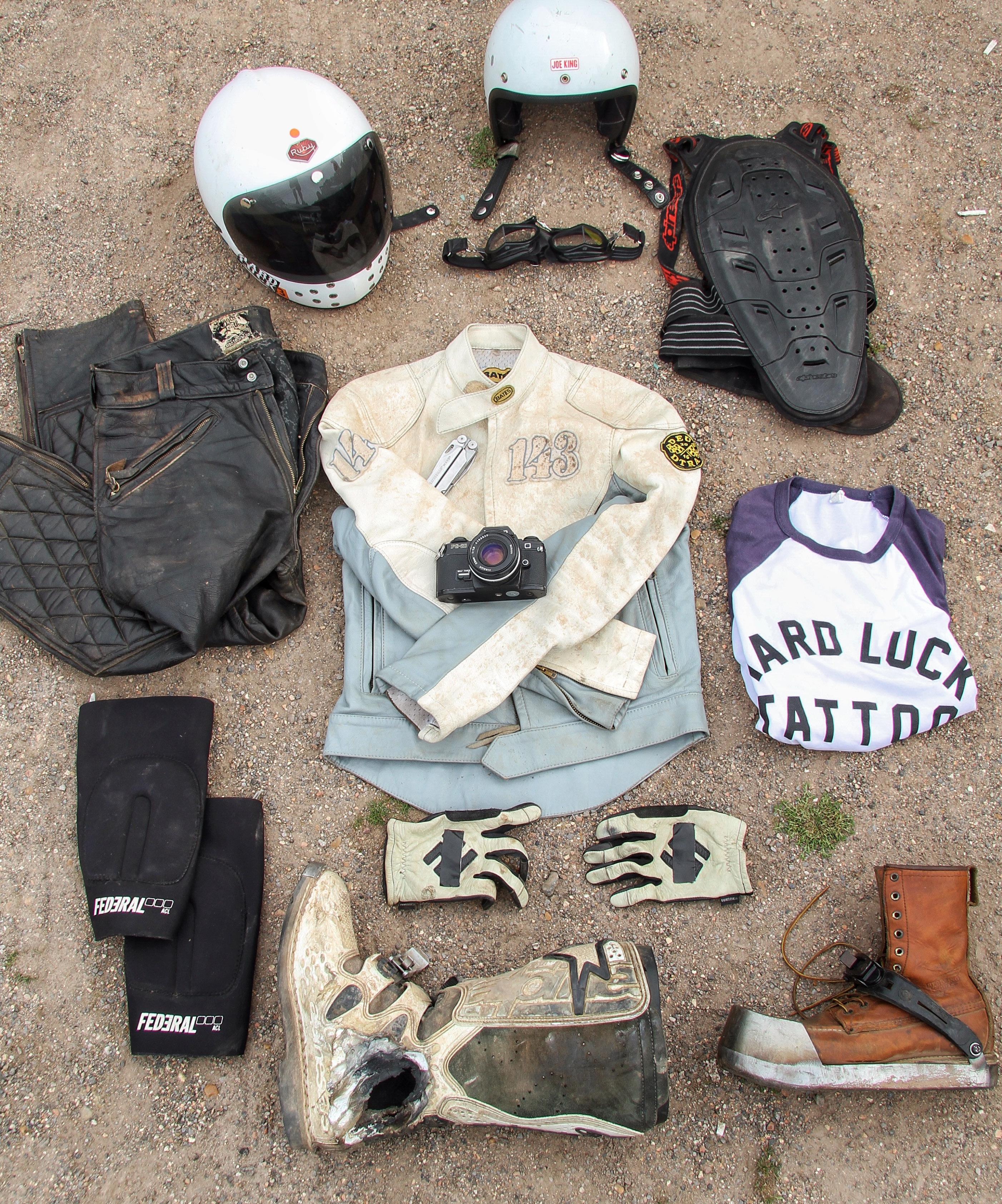
109 10 13 11 9 8 7 6 5 4 3 2 1 12
photos: Gary Inman, Max Inman
PROJECT BIKES
SIX
RACES INTO the beach racing season and our Honda 650 is continuing to develop and mutate more than I thought it would. After a few seasons of zero maintenance and medieval cruelty I revamped the whole bike for the 2017-18 season. The previous update, in SB31, spoke of the first race for the reinvented bike and a podium in the unlimited road bike class. Since then a pattern has formed: one good meeting followed by one blighted by ‘issues’.
The problems are always the same; the bike dies on full throttle on the back straight. I was sure it was water in the electrics, so rewired the bike using Japanese-style connectors bought from Vehicle Wiring Products for £40, including the crimping tool. It took six hours to sort the four-wire harness. I’m not methodical, just slow.
Next race, I thought I’d solved it, the bike behaved. The following race, it died while I was second. And then the exhaust, that had been cobbled together from two crappy pipes, blew to pieces. I put the bike in the van and sulked home.
I know some great exhaust fabricators and Geoff Co-Built had already said he’d make one for me in a hurry if I ever needed it. Now I did. He fabricated the exhaust over the Christmas holidays, a stainless two-into-one, sprung together, slash cut and baffled. It’s beautiful and nowhere near as noisy as it looks.
While I was collecting it I used Geoff’s workshop to make new alloy sidepanels to replace the existing ones, which had cut-outs for the defunct through-the-frame exhaust. With his guillotine and press it took me about a tenth of the time to make these compared to when I used tin snips to make the originals at home. It’s just a shame his workshop is located 105 miles from me.
With the urgent exhaust issue solved, the Honda still wasn’t any more waterproof and I was running out of time, because I’d be away for a week at SnowQuake prior to the next race. I dropped the bike off with Carl CFM, a multiple Mablethorpe champion, with a list of jobs I’d liked to have done myself if I’d had the time.
Top of the list was to make it more waterproof. There was a thought at the back of Carl’s mind that the pattern coil I’d fitted was a problem. Fellow beach racer Adam Grice sent me his spare to try. Carl also fitted a long HT suppressor cap that extended further over the spark plug. While he was at it, he took off the ignition cover and replaced the wiring coming out of the casings.
There are two schools of thought for beach race waterproofing. One is, try to enclose every component you can. The other is to leave the components exposed (because when enclosed if water does get in it causes rot) and waterproof the connections and terminals as best you can. Carl is in the latter camp, so plenty of automotive silicone sealer went on the Honda’s few remaining connections.
CFM also riveted the new alloy panels on the frame and made a fender extender from scrap alloy.
The final big change was to replace the Maxxis Maxxcross SM tyre, as close to a paddle tyre as you can use and be within the rules. It was mustard down the straight, but didn’t offer the side grip I’d hoped. It wasn’t terrible, but the fastest racer in my class on the beach is Steve Lomas of Five-One Wheels, who uses and sells a Michelin S12 for £63. CFM fitted it, with a super-heavyduty £25 Michelin inner tube. The tyre sidewall was drilled to fit the valve through the tyre rather than conventionally, through a hole in the rim. That way the tyre can spin
on the rim without risking ripping the valve out of the tube.
The first race after all that was on a bitterly cold morning in midJanuary. The unlimited road bike class had 11 entries, made up of a number of Honda singles, including Adam Grice and Steve Lomas, plus Richard on his rapid Cagiva 1000 twin, Dean on his reliable DR600, Mark on his Hinckley Bonneville, a Harley, CCM, CBR600, Z750...
The beach track is laid out on the morning of the race and its size is dependent on the condition of the beach. Sometimes it’s a long track, better for the fast, heavy bikes, sometime the straights are shorter and give the advantage to the slower, more nimble machines. The Sideburn Honda is in the latter category. This week it was short.
I finished third in the first four of the day’s five races. I was blitzed down the straight off the start, but the new Michelin felt great and the track was holding together better than it had all season. I could pick off rider after rider through turn one and two. Sometimes the corners become so rutted they’re painful to ride through on a twin-shock road bike with minimal suspension travel. This time I could race and think about lines and body position.
There was a deep puddle on the exit of turn two that I couldn’t miss and was repeatedly soaked by other riders I was making moves on. In the final race of the day I picked a different line and unwittingly went through an even deeper section of the puddle. The bike died in a cloud of steam with me in third place.
Part of me thinks not many bikes could have coped with that dousing, and I was unlucky to hit the puddle at its deepest point. Then I realised plenty of bikes had kept running.
Still, I came away with joint third overall and a tiny trophy. We’re moving in the right direction.
The latest on the progress of our Honda sand racer
Words and
(clockwise from top left) Beach bikes are mean; the editor’s son, Max, is race mechanic; Starting next to Adam Grice; Tiny trophy was hard won; Sheltering from the snow; There’s a class for most things at Mablethorpe, and if you’re daft enough to race it, they’re daft enough to let you; Super-cool Co-Built slash-cut stainless pipe; Jack Bell getting into the Christmas spirit at the late-December meeting; The world capital of beach racing






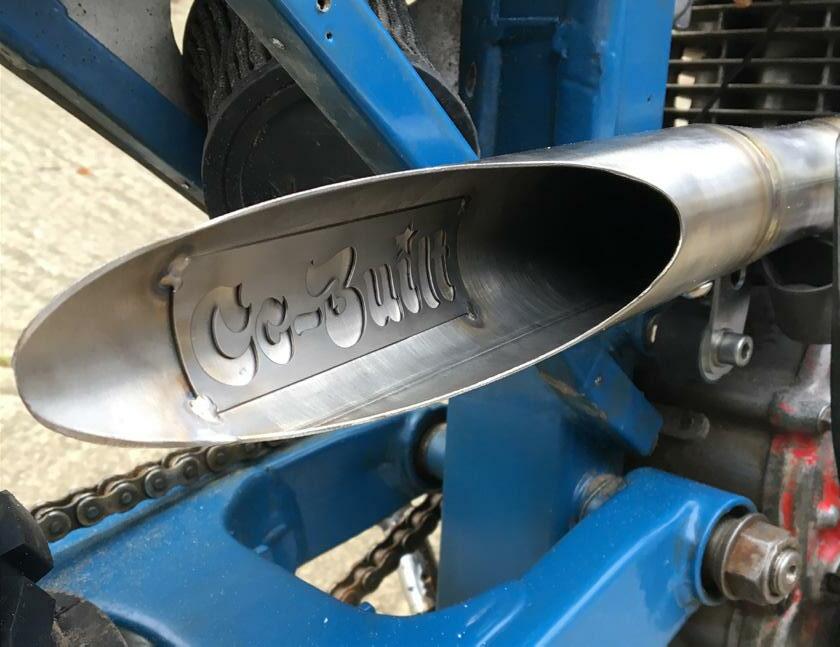


111 CONTACTS Cfmsleaford.co.uk vehicle-wiring-products.eu

Order limited-edition T-shirts, sweatshirts, patches, badges, magazines, subscriptions, art prints and more Shipped worldwide Visit Sideburn.bigcartel.com Sideburn Spanish T-shirt £19 Photo: Caylee Hankins Wingboot rub-on sticker £3.50
Sideburn’s poet races any chance he gets.
He owns a motorcycle repair shop in Wheat Ridge, Denver, Colorado
When Dirt Is Sticky
A poem by Travis Newbold
Photo: Jon Wallace/Brapp Snapps
When dirt is sticky
The line is tricky
Grab a gear
Lift the front and hook the rear
Feed the clutch some finger
Leave some shredding roost to linger
This is my dirtbike
There are many alike
This one is mine
It is my tool-toy sublime
My valentine adrenaline sunshine
It is what I most like
My ol’ true
Far from new
Mother f&#king
DIRTBIKE
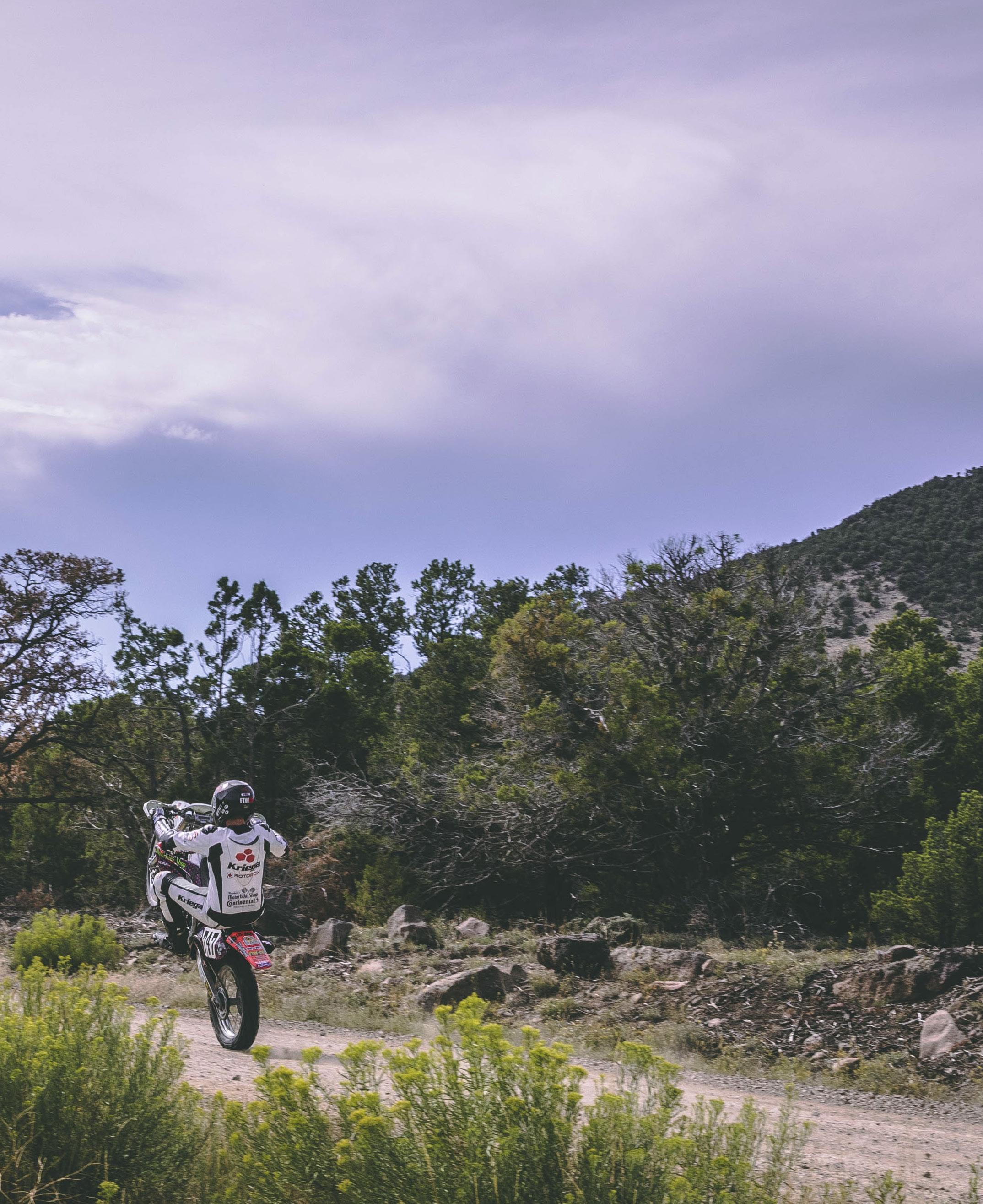
113
Aksland
Subject: Re: Me and Alex
SB: Hi Skip, you keep unearthing these great podium shots for us. Where and when was this one taken?
SA: This photo is from the 1978 half-mile national at Ascot Park. I was riding a Harley-Davidson XR750 built by Terry Sage and Stormy Winters. The other riders are Alex Jorgensen and Garth Brow. Alex was on Ron Wood’s Norton; Garth rode Mert Lawwill’s XR750 when he was on the west coast. Garth still races the 450 singles class from time to time and Alex owns a Suzuki and Kawasaki shop in Stockton, California.
SB How did this race pan out?
SA: Going into the race we all knew Alex was the guy to beat. He was winning the weekly Friday night races at Ascot regularly on the Norton. I ran in the top five most of the race and ended up finishing second. Alex won and Garth was third.
SB: We’ve had lots of photos with Lynn Griffis in our Trophy Queen series, do you think AFT are missing a trick by not having one trophy queen for the season?
SA: I think times have changed. When Camel were the corporate sponsor they paid Lynn’s salary. I’m not sure how it works now. It was cool to have Lynn as part of the series though. You could count on seeing her at every event and it made the podiums that much more special.
SB: Jorgy is wearing a hockey kneepad. That fad didn’t seem to last for long, did better boots and leathers make them redundant?
SA: The roost was so bad at Ascot if you didn’t wear motocross boots or shinguards you would really get beat up. I used milk cartons as hand protectors.
SB: Can you tell us why he’s wearing a Hawaiian lei and carrying some kind of German stein?
SA: The promoter, JC Agajanian, provided a wreath for the winner and the mugs were given to the top three by Camel. We would share the champagne in the mugs and have a few beers afterwards.
SB: California had an incredible run of producing champs, then sending them to the grand prix championship. What changed?
SA: Back in the ’70s and ’80s we could race a local dirt track three to four times a week at amateur level and once a week professionally. Now you’re lucky to find a flat track race once a month. Everything on the local scene is MX now. All the great riders that have gone to the GPs came from flat track.
What’s great about this photo is that it shows two local boys from Northern California towns, separated by 30 miles, who grew up racing at Lodi Cycle Bowl and just kicked everyone’s butt.
From: Skip
To: sideburnmag@gmail.com Date: 8 January 2018
>> Ascot Park 1978 35 23 17 15 10 10% Prominent 115% 5% smiles 12% pants 48% Serious moustache 13% Discreet fumble 10% Beautiful teeth 15% Winner gets girl 15% Champage shower 47%

51
Photo: Dan Mahony































































































































































 Words: Gary Inman Photos: Tom Bing
Words: Gary Inman Photos: Tom Bing
























































 Jonny Wilson >
Jonny Wilson >



 Kevin McGonnell
Kevin McGonnell

























































 (top) More than three years in and everything still feels crisp and fresh, none of your bile-fuelled grudge-graffiti here. (above) Main Street, Fox Town, where meeting rooms double up as dummy shops; (below) communal canteen and hang-out spot; (right) nose guard reception area
(top) More than three years in and everything still feels crisp and fresh, none of your bile-fuelled grudge-graffiti here. (above) Main Street, Fox Town, where meeting rooms double up as dummy shops; (below) communal canteen and hang-out spot; (right) nose guard reception area





































